+-+-+-+-+-+-+
|B|R|U|I|S|E|
+-+-+-+-+-+-+
home | categories | readme
A Luddite Archaeology of Hobbyist Computation
Abstract
What does it mean to propose a Luddite archaeology and why might it be productive pointed at the realm of Hobbyist computation? I begin this research with an argument that the Hobbyist reveals potentially uncomfortable tensions within creative practices that are critical of technology and can broadly be understood as following from a kind of commercial necessity implicit within the hobbyist.
The Luddites have endured a reputation in popular culture as anti-technological, whilst the primary concerns of their actions were actually the specific changes in labour conditions that were being imposed by the introduction of new technologies. These slipped meanings make them of particular interest here, particularly in relation to techniques of automation that continue to change social relations today. Settling close to craft, the research also explores a definition of the Hobbyist in relation to creative artistic practices around computation. I believe this is important as it offers a reflexive tool for thinking through creative artistic and research practices that are intended to perform critiques of these technologies.
The city of Leicester plays an important role in Luddite history and I situate this research in the city and as a part of the artistic activity and communities present there. This allows for specificity and proximity in reference to the Luddite history. It is also the place where I live and work, and the location of the artistic communities I draw on when performing parts of the research and that admit this activity as part of their general existence.1
This discussion weaves in parallel to the assembly of a Very Low Frequency (VLF) antenna. This forms two main components of the text, the how-to and the why-to. Documenting the assembly in the form of an instruction manual, tunes the antenna as a discrete object upon which Luddite archaeology is performed. The instruction manual is an integral part of hobbyist activity that allows individual replication. This text has been assembled here across through a range of mostly open source software approaches. This includes: the use of collaboration suite Cryptpad, for drafting and receiving comments from my supervisors, the use of markdown documents, collated and converted with Pandoc for web and print formatting. The web version is assembled with simple html and css. Some further details about the construction of the web page can be found by inspecting the source.
The VLF antenna acts as a prototypical/pseudo component of hobbyist computation. It is an object that allows the reception of very low frequency radio waves. These include intentional human-made signals, as well as naturally occurring phenomena. The antenna assembly is not intended to demonstrate ingenuity or technical skill, but instead act as a model for the hobbyist approach.
The methods of the historical Luddites are studied along with their eponymous origins. This is compared with critiques of capitalism today (including degrowth) and their adoption in creative practices (such as the experimental endeavors of the Tiny Mining Community). I identify the following key concepts as contingent to Luddism: Commonality, Writing and Conviviality.
Finally, I detail the use of the VLF antenna in public settings and the converging practices of a Luddite archaeology, such as a guided walk I led through the city of Leicester (visiting key sites of historical Luddite incidents). In conclusion I reflect on how these processes of Commonality, Writing and Conviviality directed as an archaeology make the tensions described above, around the effects of technology and automation and creative practices more exposed and that otherwise would not be visible or audible.
Section summary
Framework
The wooden frame of the antenna is discussed and its build documented. The size of frame and purpose is discussed. In this section I also introduce contextual research that supports the developing Luddite Archaeology.
I detail my use of archaeology and the framing of the hobbyist.
I examine various analyses of the historical Luddites and the preceding, mythical origins of Ned Ludd. This includes more detailed research into the localised instances of machine-breaking, letter-writing and protest that were taking place in Leicester from the late 1700s through to the mid 1800s. Studying this wider timeframe contextualises the Luddite struggles as part of a long series of attempts to resist the changes of industrialisation, and also how this related to other movements, such as anti-slavery, women’s rights and animal rights.
I review recent studies that compare historical Luddism to more recent resistance movements. This includes the literary approaches, often connected to science fiction, that emerged with the proliferation of computation in the 1970s, through to the ongoing response to the energy-intensive computation of today. Specifically this can be traced through the ideas of artificial intelligence.
This section compares the idea of the commons that is prevalent in Luddite analysis to other movements emerging today. These are ecologically centered responses to capitalism, in particular, degrowth and permacomputing.
Resistance
This section explores the materiality of this essential part of the antenna. The source of the copper is considered, along with the process that converts it from raw material to hobbyist product. The wire needed for the antenna is calculated and installed on the frame. It is these processes that reveal the inherent contradictions between the use of a material and the intentionality of the creative practice.
The particularity of hobby radio is examined. This is based on the various laws and governing organisations that limit and control the use of the electromagnetic spectrum.
I also draw upon the practices of various artists using VLF antennas or working with technologies adjacent to this area, to consider the hobbyist and luddite framings.
Amplification
The antenna is connected to an amplifier and listened to. This takes place with other people, in workshop settings and alone on hillsides, in a loft or walking through the city. This section expands on what happens when these methods of resistance and archaeology are enacted in the world. This is described through several experimental events or happenings that occurred in the course of the research. The idea of the commons is explored more closely.
This section returns finally to the question of what a Luddite Archaeology is. It considers the difficulty in appropriating directly the historical Luddites and the contradictions that emerge. It suggests a deeper examination or clearer break is needed. I map out a trajectory for the continued Luddite archaeology of hobbyist computation, by means of a steady ascent of the electromagnetic frequencies, which corresponds to an increasing complexity of hobbyist computation and the devices that operate within these different zones.
Code Practice
The construction of the website and the methods of hosting tie in with the general aims of this research - and follow the active quality that I argue a Luddite approach entails. This exists digitally in a fragile state. It is not expected to remain accessible for any great length of time. It depends on a continued use of browser software that renders HTML and CSS to current standards. The website structure also exploits a hyperlinked fluidity of motion between sections of text, footnotes, illustrative media, audio and un-rendered code comments. As an act of preservation within the formalities of the university environment I enclose thesection of the HTML below along with several other excerpts that document how different media elements are composed on the page:
<!DOCTYPE html> <html lang="en"> <head>
<meta charset="utf-8" /> <meta name="viewport" content="width=device-width, initial-scale=1" /> <meta name="author" content="Mateus Domingos"> <meta name="author" content="ghostglyph"> <meta name="description" content="bruise is an experimental publishing project by leicester-based artist mateus domingos.">
<!-- favicon generated using https://favicon.io/favicon-generator/ --> <link rel="apple-touch-icon" sizes="180x180" href="/apple-touch-icon.png"> <link rel="icon" type="image/png" sizes="32x32" href="/favicon-32x32.png"> <link rel="icon" type="image/png" sizes="16x16" href="/favicon-16x16.png"> <link rel="manifest" href="/site.webmanifest">
<title>Luddite Archaeology</title> <!-- Import the webpage's stylesheet --> <link rel="stylesheet" href="/style.css" /> <link rel="stylesheet" href="res-styles.css" />
<!-- Notes about the construction of this page. These are both for the reader and myself as the author - to remember how to do this. The page is generated in part from a folder of markdown files. These are combined and formatted as html using Pandoc. $ pandoc *.md > body.html --file-scope This file is then merged with the header and footer files. $ cat header.html body.html footer.html > output.html --> </head>
This element creates an audio player on the page. Whilst reading the thesis you are invited to listen to a recording made with the antenna. These sounds can also be found at this link (https://mega.nz/folder/UTJQlRaK#fNi_IE108kLKcPCSBSROfw)
<div class="radio"> <audio controls> <source src="sounds/rec_20230611-175355.mp3" type="audio/mpeg"> Your browser does not support the audio element. </audio> </div>
<figure> <img src="images/f66.jpg" title="Homebrew Computer Club Newsletter Volume 2, Issue 1, January 31, 1976." alt="HobbyLetter" /><figcaption aria-hidden="true">HobbyLetter</figcaption> </figure>
Framework
How To (1)
Start here – without knowing the route we’ll take or even the destination to which we are headed.
Let’s assemble together across screens, with guesswork, imagination and deception.
You are assembling a frame. The frame will support, guide and constrain the components we apply to it, and also the ways in which it performs during our interactions with it. The frame can be made out of any material but the construction we are embarked on presents an opportunity to think about the different qualities that different materials present.
If you are comfortable working with wood, that can be a convenient approach. It’s the method I’ll describe here.
If you intend to transport your antenna to different locations, consider using something light. A bicycle wheel or plastic hula hoop could be good options. Another alternative is to use a large board or other moveable surface and just hammer in nails at the corners of your square or around the perimeter of a similarly sized circle.
A good size is around 1m2.
Our frame here is made from oak strips 110cm in length. The corners are simply lap jointed and a piece of beech dowel is also added at each corner. This is a frame that is most suitable for fixing to a wall or otherwise suspended. It doesn’t include a stand or handle, but it will still be easy enough to move around if we wish.
Previously, I have enjoyed making frames in unusual shapes, that look like ornaments from unknown rituals. I paired these with simple crooks, made from large pieces of dowel. I tell people to imagine they are listening in the future, or in the past. The antenna is part of an unknown ritual. What is the world they are listening to? But let’s not jump ahead.
You will need: a saw, a router, clamps, wood glue.
Cut four lengths of wood 110cm in length.
Join the lengths into a square.
To create the lap joint, measure a square from the end of the length. On my frame the joints alternate the orientation on each end of the length. From the side each one is like a stretched S or Z. If you do them each like that, you’ll end up with four pieces that slot together.
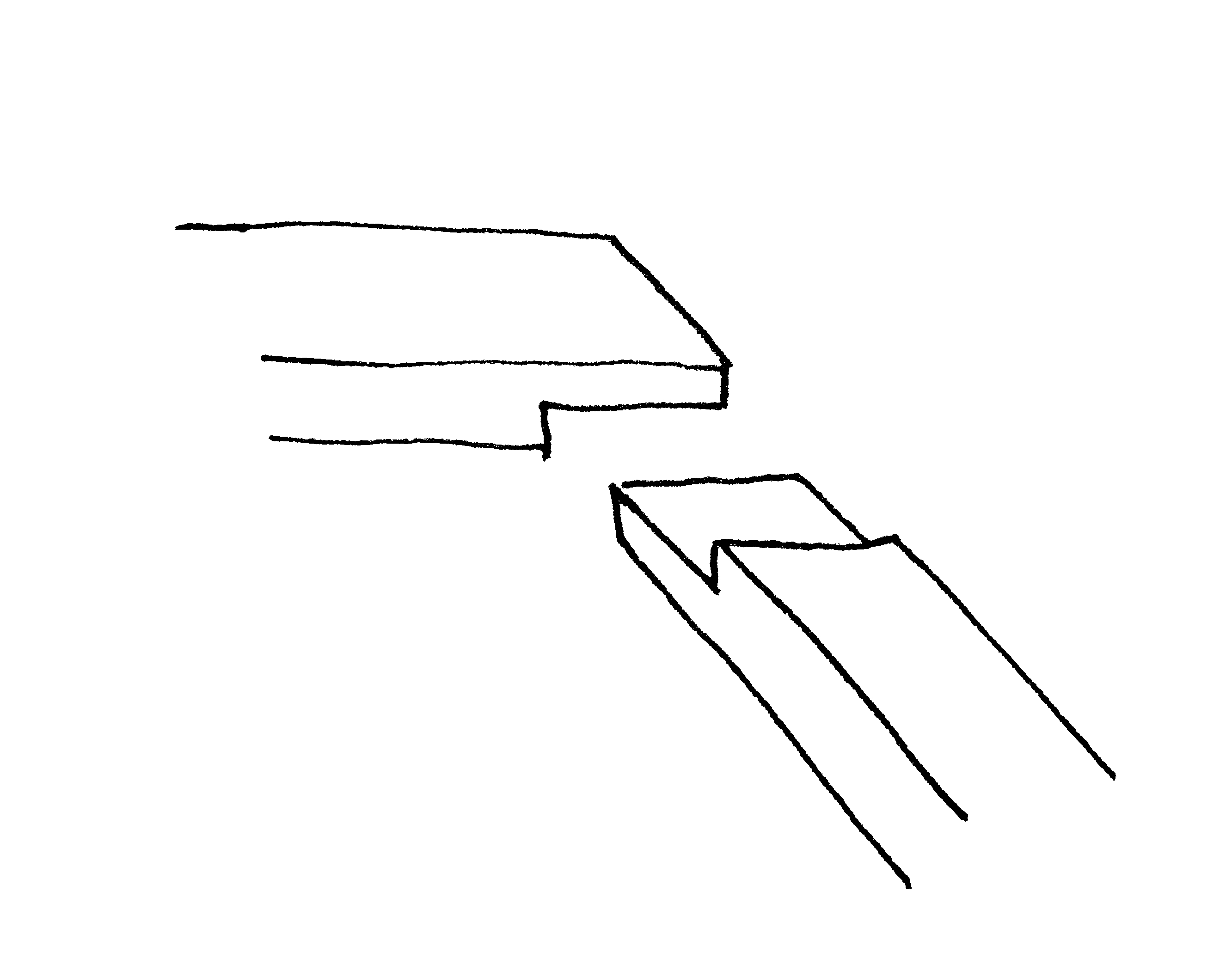
You need to remove the square to about half the depth of the wood. I made cuts first using a multi-tool and then worked further into the wood using a chisel. In the photos my cuts show lots of burn marks, as the saw blade I was using wasn’t sharp enough.
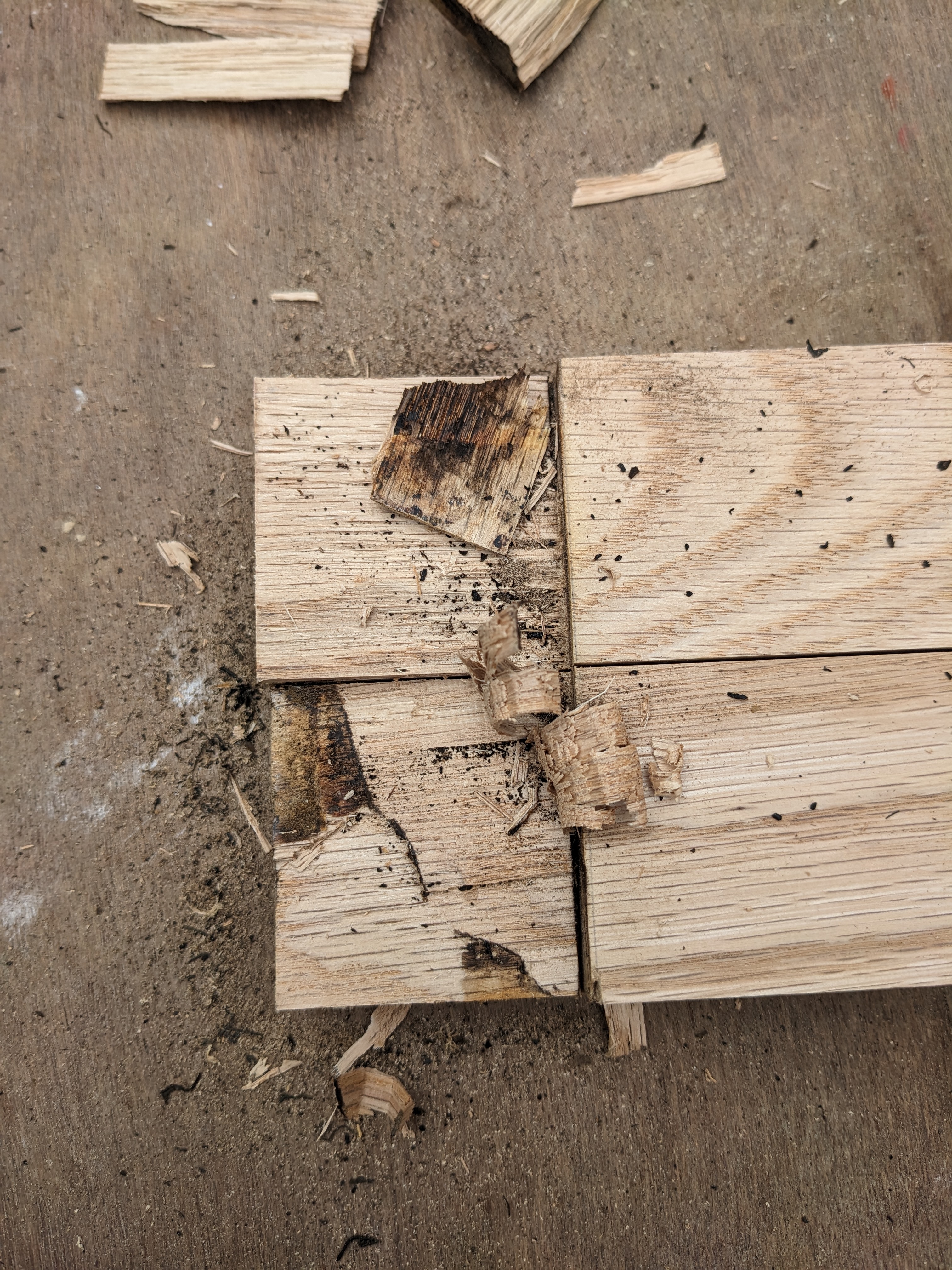
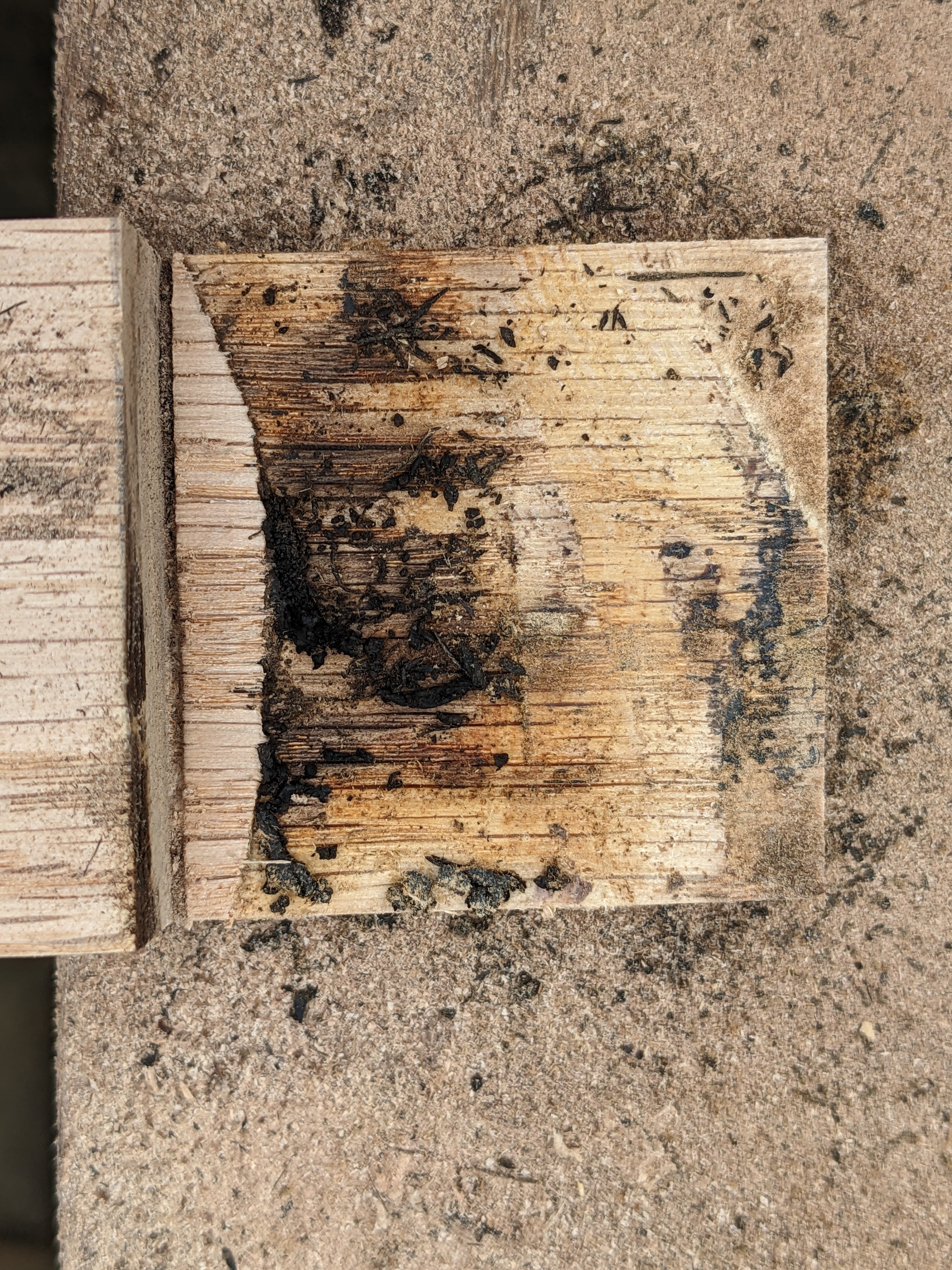
As the cut gets closer to the final size, keep checking progress using other pieces of wood.
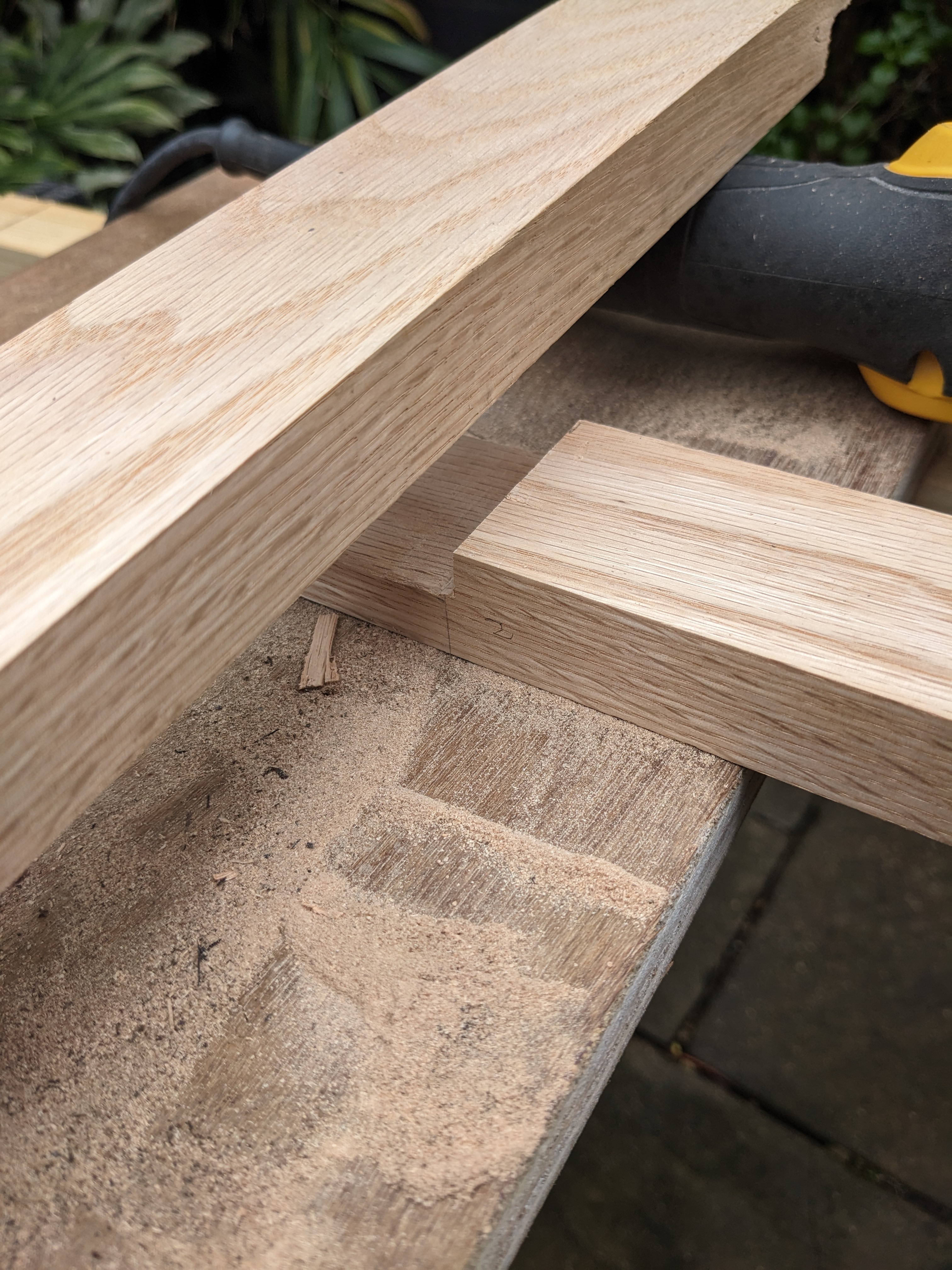
Use clamps to hold the frame square as the glue dries.
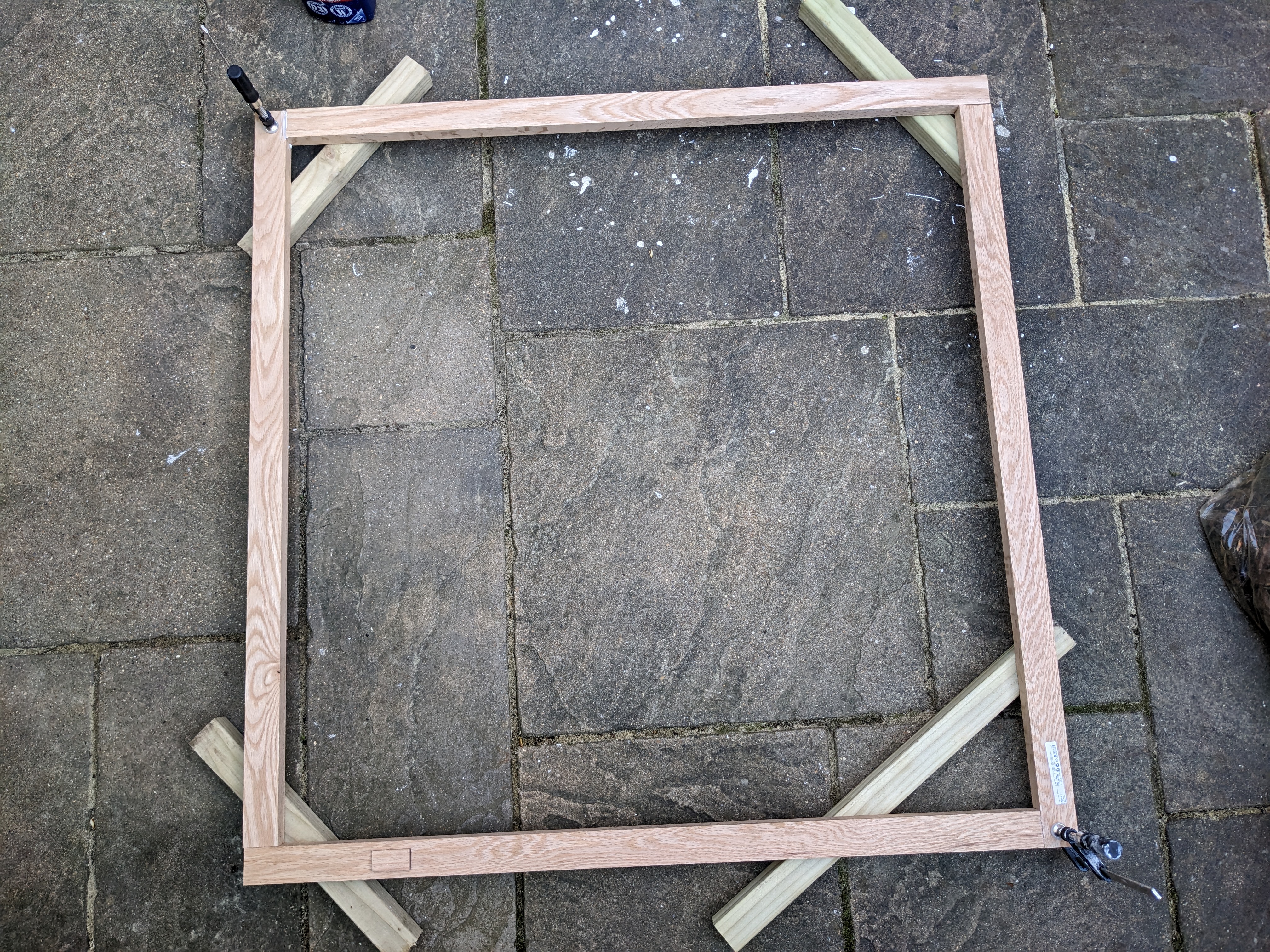
Drill a hole through, as close to the size of the dowel as possible. Give the dowel a good coating of glue and push it through. Wipe away the excess glue. You can leave the dowel slightly longer at this stage and trim it back later.

- Create a channel for the wire.
We use a router to create a channel around the outside edge of the frame. It doesn’t need to be too deep. In this design I’m hoping to just about conceal the wire when the frame is viewed from the front. This is where our antenna coil will be wrapped. If you don’t have access to a router, you could use the dowel pegs as the supports to run the wire around.

- Drill holes through channel and create void for connecting.
Decide on a location for the coil to begin and end. At this point you will create two holes for the coil to be fed through. This will be close to the point where you connect external cables to the antenna, so make sure it is convenient to your design.
Drill two holes about 1cm apart from the base of the channel into the center of the length of frame.
Now we will make a small void, within the frame that will give us some space to connect components. In line with the two holes, from the face of the frame cut out a small square section with a lip about 10cm in length and to nearly the full depth of the wood. The two holes that you made previously should now be connect the channel to the void. Cut a smaller piece of wood to sit on the lip, flush to the surface of the main frame.

Why To
This research explores the possible strategies toward a Luddite approach to media archaeologies. It also attempts to introduce and propose a definition of the Hobbyist in relation to creative artistic practices around computation.
Following Blackwell et al. (2022) in their reading of Haraway, I’m interested here in centering the ‘lived realities’ contingent to this archaeology. It is an archaeology through hobbyist practice and the observations resulting from the application of different creative acts.
As will be examined further, this feels like a necessary framing from which to consider Luddite archaeology. Whilst not adopting a universal perspective, it is one that attempts to frame the local as part of and contingent with, the global.
I begin the research from the inherent contradiction of capitalism, that a system that demands continuous growth is unsustainable on a finite planet. The methods of extraction may move location and change their quarry, but always to the further destruction of the earth systems that sustain any kind of life at all. Traced in different ways, capitalism conjures surplus from labour, whilst the sites of the labour are ever changing and expanding following the extractavist logic. This was formulated by Marxist philosopher István Mészáros in 1972, as
[The] basic contradiction of the capitalist system of control is that it cannot separate ‘advance’ from destruction, nor ‘progress’ from waste – however catastrophic the results. The more it unlocks the powers of productivity, the more it must unleash the powers of destruction; and the more it extends the volume of production, the more it must bury everything under mountains of suffocating waste. (Mészáros [1972] 2014: 49–50) [Quoted in Saito, 2022]
Archaeologics
Using the framework of archaeology presents a range of possible meanings and contexts from which to draw. The main ways I’m going to think about it follow the media archaeology of theorist Jussi Parikka (2012).2
During the earlier stages of my research I also explored the neighbouring methodologies, of geology and forensics, which I linked to a scaling of enquiry.3 These various scales have remained important in my navigation of this research.
I also draw on the archaeology of knowledge described by Michel Foucault, which is important to many of the sources and examples I’ve drawn from. This includes, for instance, the archaeology of sociologist, Adrian Mackenzie, in Machine Learners (2017) and the Live Coding (2022) manual of Alan F. Blackwell, Emma Cocker, Geoff Cox, Alex McLean and Thor Magnusson.4 It is also present in the Media Ecologies (2005) of author Matthew Fuller, where he notes the importance of Foucault’s definition in making it useful as a political tool, by the way in which it “allows deep rules, those that are unspoken, to come to light.”
In exploring the Luddites, I also inevitably, open a parallel enquiry that follows the narrower definition of the archaeological, as the study of human history, through the artifacts and material remains.
These different contexts are at play throughout the text, but ultimately the archaeology I am interested in describing through Luddite means, is one connected to the sense of archaeological to discover what stories or evidence these objects can offer in and of themselves - in other words, what can they say?5.
Hobbying
I am using the term hobbyist here to indicate an actor that is engaged with a technology such that it is open to manipulation and sabotage. As well as occupying a position or relationality with technology that affords this conviviality, the play of the hobbyist is at constant risk of being folded back in to capitalist modes of production.
The use of the word comes from the naming of a small horse, which by the 1600s referred to the hobby-horse as a child’s play thing or the horse costume used by Morris dancers and other folk dance customs. By the 1800s the term was being used to refer to leisure activities and pastimes (Etymonline, 2023). The development of this understanding can perhaps be seen in relation to the development of capitalism and the industrial revolution. I suggest that it is only under these conditions that a hobby can hold this definition as something unproductive to Capital; as an activity that doesn’t produce surplus value. It seems to always contain this unproductive quality, which is perhaps why it is commonly used pejoratively, whereas similar related terms such as amateur, or craft seem capable of encompassing both unproductive and productive relationships with Capital.
The term hobbyist might not be a prominent self-descriptor of those engaged in experimental, creative arts practices. These might more commonly be described as DIY or punk. This serves to distance them in some respects from standard commercial practices of the same craft. They might be thought of as occupying a default anti-hegemonic position. Questioning the relation to hobbyist complicates things. It draws attention to the places where these practices overlap with contradictory value structures and also questions the material sources of these practices initially. This is closely related to the discourse raised around the Free/Libre and Open Source Software (FLOSS) practice, where tensions between socialist and liberal values often surface. Focusing on the hobbyist focuses initially on the hardware and material contingencies of such activities. The adjacency of terms such as hacker and amateur are also useful to consider.
This is an attempt at using its uncertainties to occupy different spaces and make legible the materiality of supply chains. The Hobbyist as performing a ‘useless’ production is perhaps enabling of practices which are dismantling, slowing down and ultimately identifying possible futures not probable (Isabelle Stengers via McQuillan [2022, loc13.30]) (see also Badiou in Crary 2022, loc7.7]).
This contradictory aspect is also identified by author Marina Vishmidt,
the figure of the amateur reflects an ideal of engagement that is semi-autonomous from institutional and commercial circuits, although it may be shaped by these at several levels, even in simple negation. (Vishmidt, 2006)
This is a very useful framing. In the discussion here, I am interested in the uncomfortable friction produced by the categorisation of activity as hobbyist. As Vishmidt writes, it does occur as a kind of distortion on the potential of the amateur:
“The amateur can easily also shade into the hobbyist, whose consumption of leisure is enhanced by obsessive research and affinity-building around the object or activity, as opposed to say, mere shopping.” (Vishmidt, 2006)
It is an enhanced, dedicated form of consumerism, which often hides behind self-importance and grandiosity.6 Crucially, if the hobbyist is a term defined from within the context of capitalism, it follows that an anti-capitalist arts practice would not be compatible with a definition as hobbyist. It perhaps marks the distance between intention and reality, of something constrained within a system.
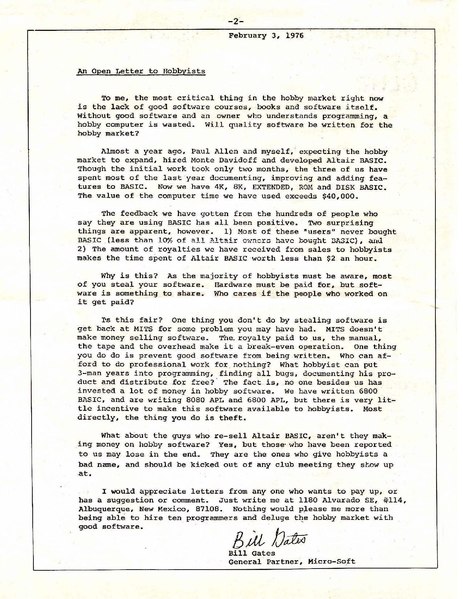
There is also an uncomfortable specificity of the hobbyist in relation to computation. In 1976, Bill Gates famously wrote his Open Letter to Hobbyists. This set the stage for the criminalisation of software piracy. He argued that the free sharing of software, by hobbyists wasn’t fair on developers (software companies). The open source movement started, or was at least able to gather around the collective resistance of the kinds of closure advocated for by Gates.7
My focus is on creative communities and peer groups as they/we exist in different areas, such as the academic institution and arts organisation, and their/our engagements with technology. Even within practices sympathetic to capitalist alternatives, countless different methods and approaches to occupying these positions can be found. One example of this is perhaps to take the premise of technological determinism and how an individual responds to such ideas. Technological determinism is the question of how technologies develop and whether this happens autonomously or as the result of choices by individuals or groups. Understanding the development as autonomous can make it appear inevitable and removes the possibility of ethical engagement. Understanding the development as a continuous outcome of decisions made by people, opens up the possibility of ethical engagement.
If we focus for a moment on the zone of social networks, and the alternative infrastructures built by communities we can examine some of the ways in which this undecided resistance is present. Examples of these communities could be Lurk and New Design Congress, both are European groups that host a range of services; including federated social networks, mailing lists, document editing and video sharing. Founder of New Design Congress, Cade Diehm writes about the danger and uncertainty created by the difficulty of consensus within these communities (2020). Diehm is sympathetic to much of the rallying of these communities, and the embedded forms of protest they enable, “encoding protest in encryption, or framing servers as facilitators of self-expression” (Diehm, 2020) but wary of the way these infrastructures are deployed. Diehm writes that, “as these networks are decentralised away from concentrated power, their risk, and political and economic capital are equally decentralised. The antagonistic rhetoric of these systems mean that participants are naïve to these risks.” (Diehm, 2020)
In the same paper Diehm quotes programmer Simone Robutti who frames this position as the ‘Hackerist perspective’. This is in close agreement with Diehm and Robutti writes:
Today, the hacker multitude is incapable of producing pervasive alternatives, producing viable and accessible solutions, and ultimately counter-attacking the continuous invasion of Big Tech of the public and private spaces. (Robutti, 2019)
It would seem that to fall into this definition of the hacker would undermine many of the designs or reasons of the practice in the first place. It leaves the hacker in a place where they are unable to achieve change across the systems they are a part of. For Robutti, this leads to “the creation of small spaces of safety which get harder and harder to defend, requiring increasingly larger efforts to be maintained.” (Robutti, 2019)
I think it is useful to compare this hackerist perspective with that of the hobbyist. It performs a similar task, unmasking or questioning the way the intended aims of a creative practice map to their actual outcomes and the wider impact of those.
Carrier Waves
A key strategy (as this methodology of Luddite archaeology is developed) is the fluidity of these stated positions. This research (and many of the creative examples cited later) is multidisciplinary, drawing on the forms and formalities of academia and the arts. It does so out of necessity, a tactic to evade capture, or at least delay or confuse it, within these structures that have ceded much to the mechanisms of financialisation, and demands of growth and output - which are increasingly at odds with attempts to undo and repair. As the hackerist/hobbyist positions suggest, the relationship to the locations of their output (for example a publication or exhibition, through an institution, or within a gallery) are of course responsive to their own support systems, which are more than likely dependent on conforming to the present conditions.
This requires an understanding of the process or perhaps as Fuller, writing with architect Eyal Weizman (2021) identifies it, the ‘investigative commons,’ which might be able to “nourish the troubled commons.” (Fuller and Weizman, 2021) I will explore this idea of the commons further in the chapter Luddite Commons.
If an alternative to a growth economy is considered, we can think through new ideas, structures and relationships. The spirit of the Temporary Autonomous Zone (or T.A.Z., as described by anarchist poet Hakim Bey (1991)8, and the examples of the ZAD (Zone To Defend)9 are concrete examples of how this might manifest. In their account of life on the ZAD, artists and educators Isabelle Fremeaux and Jay Jordan (2021) recount the emergence and survival of a community defending a plot of land against the development of an airport. This happens through ‘commoning’, a practice of shared joyful resistance and the remembering of long dormant folk rituals.
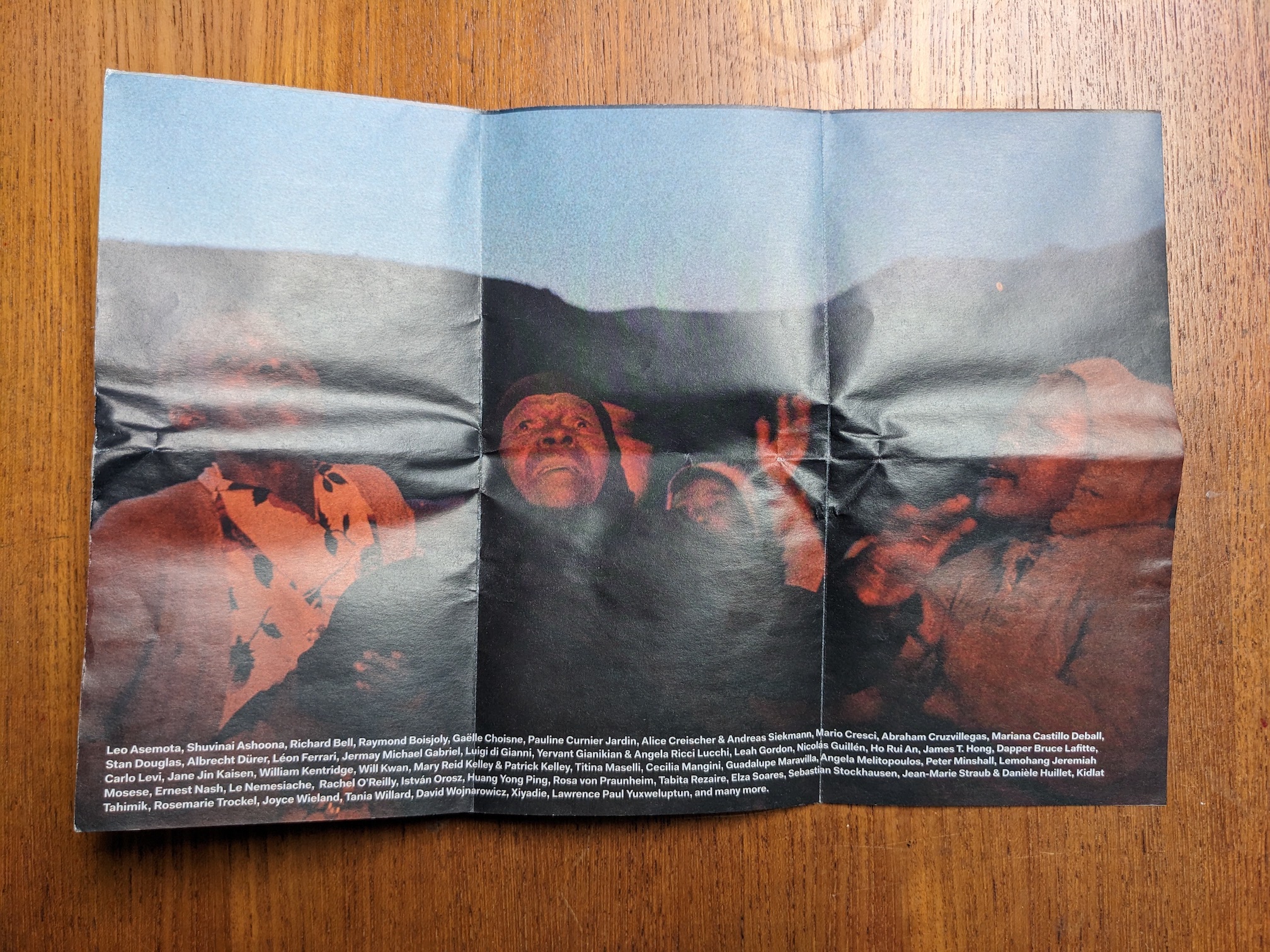
Ultimately, if these tactics are to begin or to spread, there must be a requirement to accept the legacy of capitalism and colonialism, to name it, and to declare the occupation of its ruins and th re-purposing of them. It is this declaration of ruins that was explored in the exhibition Ceremony, Burial of an Undead World (HKW, 2022) which was prefaced by Anselm Franke’s curatorial statement that “to make different futures possible, this undead world—which violently resists change in its refusal to die—must be laid to rest.” (Franke et al, 2022) The curator framed the performed act of burial within the zone of the gallery. It suggests the gallery is a space to imagine these other possible futures and explore their performance. This connects to the work of artist Michael Turinsky (2022) with which he suggests that artists have a responsibility to open spaces for repair to take place. He notes that humans have been shown to learn concern through experiencing repair. (Turinsky, 2022)10 The occupation of ruins might also reframe or provoke computational practices to engage only within the constraints of what is salvageable.
Connected to this understanding of capitalism is the imperative of decolonisation. Thinking about who it is that is colonised, writer Karim Lazali provides a useful definition, the colonised as being someone who is denied responsibility, and therefore the agency to care. A de-colonising process would inscribe new responsibilities or return them. (Lazali, 2021) The industrial revolution and colonising imperative of capitalism is traced through in the electronic waves explored here; in the shipping routes, that trace undersea cables that trace earlier shipping routes, and all organised around the structures of colonial expansion and the methods of power and control. It’s perhaps important to keep this framing in mind as many of the proposed solutions or desirous responses to the climate emergency (even if framed partly as an anti-capitalist approach) keep the colonial organisations of power and denial of responsibility. For example, this is the case in Malthusian11 responses which seek to limit the size of populations. Writing in The Future is Degrowth, Matthias Schmelzer, Andrea Vetter and Aaron Vansintjan note, “Malthusian critiques that problematize population growth, are less important for degrowth. On the contrary, many degrowth authors criticize arguments that primarily focus on population growth as structurally racist.” (2022)
The methodology of Luddite archaeology resolves different articulations of these larger systems, and moments of disassembly that effect a form of resistance.
Luddite Webs
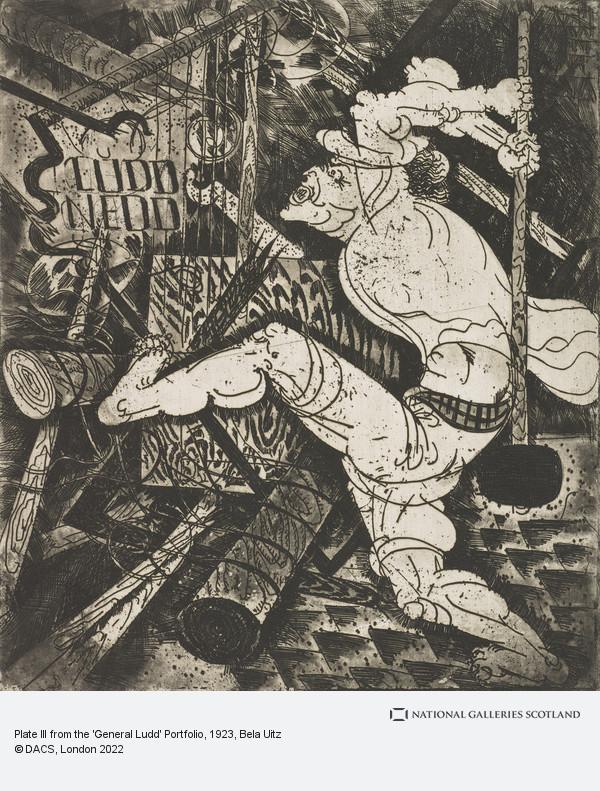
Here Lies a Luddite
This research considers the historical Luddites, and the forms of action they took to demonstrate against changes in working conditions under the imposition of technological change. It’s of note that like the hobbyist these are positions that are forced by the development of capitalism and the intense changes of automation.
I consider the methods used by the Luddites and how these might map to contemporary actions. It is worth asking why do we need the Luddites at all? What does it augment to other modes of resistance (with much more of a reality in the present moment)? The Luddite only suggests a focus on a set of actions and questions that challenge relationships to labour and technology - that push open new commons, or as they phrased it, “put down all Machinery hurtful to Commonality” (Binfield, 2004). It is a movement that demonstrated techniques of refusal, destruction and sabotage, all of which remain important and present in resistance movements today, as can be seen with the local (Leicester) demonstrations at the Elbit drone factory13, motorway blockades of Just Stop Oil (Guardian, 2022) and the decentralised, psuedonymous actions of the hacker collective, Anonymous14.

This is also distinct from popular misunderstandings of the digital commons, which as art critic Jonathon Crary writes never existed: “From the start, internet access for a global public was always about the capture of time, about disempowerment and depersonalized connectedness.” (Crary, 2022). Crary continues, “The only reason the internet seemed “freer” or more open initially was because the projects of financializing and expropriation did not occur all at once and took a number of years to reach an acceleration point in the early 2000s.” (Crary, 2022). It is important in the thinking here, that the desire (which is perhaps part of the popular misconceptions of Luddism) is not a return to previous states, but a recognition that things change and that we need ways of understanding these changes and how we might choose to move forward.
Work done by cyber-feminist15 movements includes the dismantling, refiguring of languages of computation and the relational structures between users. This activity is described by the participants of Systerserver as different to conventional server structures because “Feminist servers by contrast not only set out to queering binary gendered or other violent and oppressive tech language but also to the production of horizontal peer relations by imagining alternative roles of responsibilities and care-based approaches to technologies.” (mara karagianni, ooooo, nate wessalowski, vo ezn, 2023) A Luddite response, I would argue, should be seen as one part of a wider network of social movements.
It is also a minor form of resistance that can only be performed within the window of time that it takes for a new technology to be assimilated. It is the resistance of change, as distinct from emancipatory movements that seek to undo existing harm16.
Acknowledging the specificity afforded by Luddism it is also important to remain attentive to how it works alongside the technological critiques provided by other movements and networks such as the cyber-feminist and queer as referenced already, or the disability rights movement17 which are relatively recent and reflective of the technological progress since the framework knitting machines of the 1800s. I will expand on the argument for this position in the section Eliza.
I will discuss later in this section some of the ways in which Luddism of its time was also already acting in this way - a patchwork of resistances. Looking at Luddism opens up opportunities to interpret their writings and actions. To use the tools, as in; “Enoch made them, and Enoch shall break them”18 or to change the tools to heed a Lorde-ite warning “the masters tools shall never break the masters house.” (Lorde, 2017)19
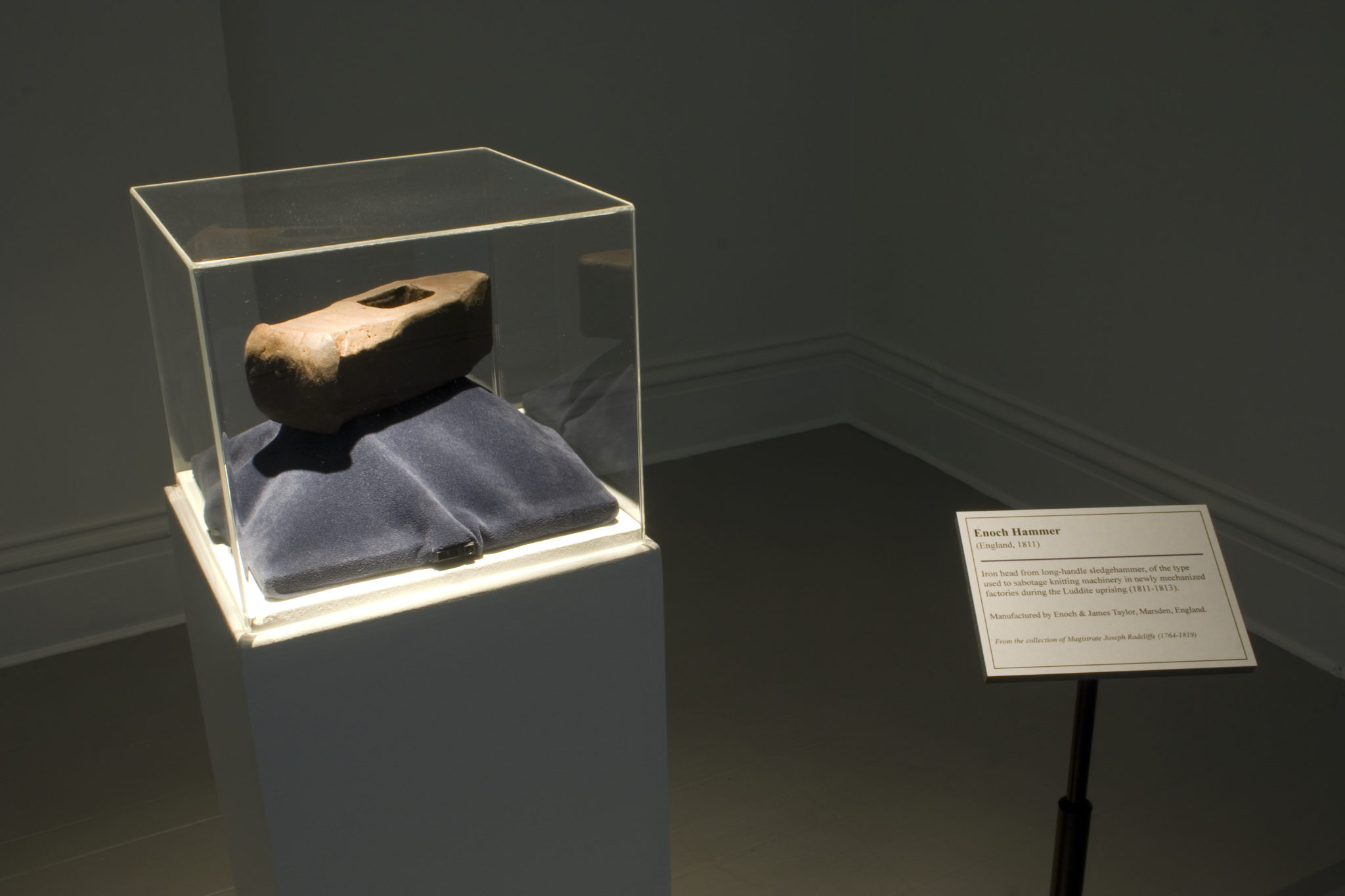
For Philosopher Gilles Deleuze the type of society in which we are resisting is now fundamentally different (1992). The disciplinary society has shifted to society of control, and with that our social relationships and forms of resistance possible have been altered.
Thee Ludds20
As a collective movement the Luddites were active only for a brief period between 1811-17. Their actions were one form of resistance within a range of others, that sought to resist the changes more widely impacting society through industrialisation.21
In defining the Luddites, writer Kevin Binfield (2004) identifies three distinct localised forms of Luddism. These are the Midlands, Northwestern and Yorkshire. Each region contains particularities regarding the types of actions that were carried out and the types of labour being contested. These largely relate to the textile trade but were not limited to it. The localised forms each relate to the different conditions of work in that area, and the different specialities, organisations of labor and hierarchies of power.
The changes being caused by the deployment of technological developments, generally led to a breaking down of jobs into smaller parts, or piecework, and a reduction in quality of product for an increase in the amounts produced and the reduction of the costs to produce them.
The looms that facilitated this production were rented to mill owners who employed workers to use them. The centralisation of this production within a mill or factory was itself still a relatively recent development, and one borne out of the development of the loom. Newspapers at the time of the Luddites linked the eponym of Ned Ludd to the story of Edward Ludlam, a framework knitter from Anstey, Leicester, who broke his masters loom in the 1780s. This would have been a different kind of loom, and one housed in a home or small workshop.
In thinking here about a re-appropriation or learning from Luddite tactics, it is important to think about how this re-appropriation was always to some extent part of it, as it morphed between regions that it was able to exist in different forms responding to the specifics of space and time.
Epistolary Luddism
Binfield’s research is drawn from the attempt to collect together the writings of the Luddites. Through this collection and the accompanying analysis the importance of the letter writing itself is clear. It shows the attempts of the Luddites to turn the systems of power that were being set against them, back against themselves. They concede to legalese, and attempt to have their arguments considered. This is at least true within the context of the Midlands Luddites, where “the framework knitters saw in their ‘‘Charter’’ a legal bastion that they hoped might be supported by the authorities to safeguard their trade.” (Binfield, xvii) The existing organisation of the framework knitters, through their charter, had established and recognised customs. “It governed what knitting techniques ought to be employed, how journeymen and small masters negotiated for wages with hosiers and large masters, and how frame rents would be set.” (Binfield, p21)
The legal style of these documents could have been based on the available documents within the trade, or public texts and notices as Binfield identifies. (Binfield, p26) Binfield also notes that the “fact that the legalistic discourse appears to resemble or derive from official forms but also to contradict the official forms in intent may have caused scholars such as E. P. Thompson to concentrate their attention more on the directly threatening letters as more uniquely Luddite.” (Binfield, p28)22
This epistolary practice also allows the eponym to function. There is a playful freedom in the assuming of a name. It is a form of self-identification and unity that offers some anonymity to its users. “General Ludd is an author who gives utterance to the complaints of a collective body.” (Binfield, 209)
It is also this practice which in transmitting through the postal system, creates its own record and archive as accounts are kept and copies are made. In Binfield’s collection this includes the threatening letters, as well as those that are composed from gaol. The letters are often difficult to parse, containing “misspellings, grammatical errors, omissions, and insertions” or even the palimpsest of a Luddite oath. (Binfield, 214)
This suggests an importance in the collective act of writing a letter, of negotiating what to include. To jump for a moment to the contemporary and our archaeological object, within the experimental creative communities that form with and through these technologies, a collective writing process is commonly performed, evident in the actions of anonymous net activists, FLOSS organising.23
Historian E.P. Thompson (1975) traced the use of anonymous letters throughout political unrest of the 18th and 19th centuries showing that
in any general episode of agrarian disturbance or of food riot, a score of grievances come to the surface in these letters, supported upon a general levelling sentiment. This is true of the riot years of 1766, 1795, and 1800-1801; of the East Anglian disturbances of 1816; of the ‘Swing’ riots of 1830 and their aftermath of arson in the 1840s.” (Thompson, 277, CoA)
Thompson also notes the decline of the anonymous letter after the use of the printing press became more widespread, and the practice of radical presses emerged. During the time of the Luddites, letters were able to serve as a method for spreading dissent when individuals were less likely to have access to a press (and the ability to print many copies) as the recipients would often publish them in newspapers seeking the authors to be identified and advertising a reward.
Perhaps in this particular redesignating of the Ludds, there could be a new spelling or phrasing to indicate its distance, the doubling and distortion, N. Ludd maybe. artist Ollie George traces the appearance of the only actively non-male psudeonym that appears in the Luddite letters, Eliza. George suggests that we use this now to see how “between the cracks of lost fiction and a tale held captive, one coded body is weaved back.”(George, 2020)
Writing is clearly an important tenet of the luddite strategy. Whether it involves adherance to the collective psuedonym or a mutation into other forms. It records intention and possibility and becomes enmeshed in the fabric of text it is concurrent with - through the mimicry or subversion of legal forms, the borrowing of these lexicons or the parasitic publishing technique of the threatening letter.
Luddite Echoes
Often cited as the last of the Luddite incidents is the attack at Heathcoat & Boden’s factory in Loughborough that took place on 29th June 1816. Newspapers reported that a group of 30 Luddites entered the factory whilst more stood guard outside. The Luddites injured one of the guards and proceeded to break all the framework lace machines in the factory, of which there were over 50. The frame-breaking had occurred following the sudden reduction in wages at the factory, and unsuccessful pleas and strike actions seeking to increase wages.
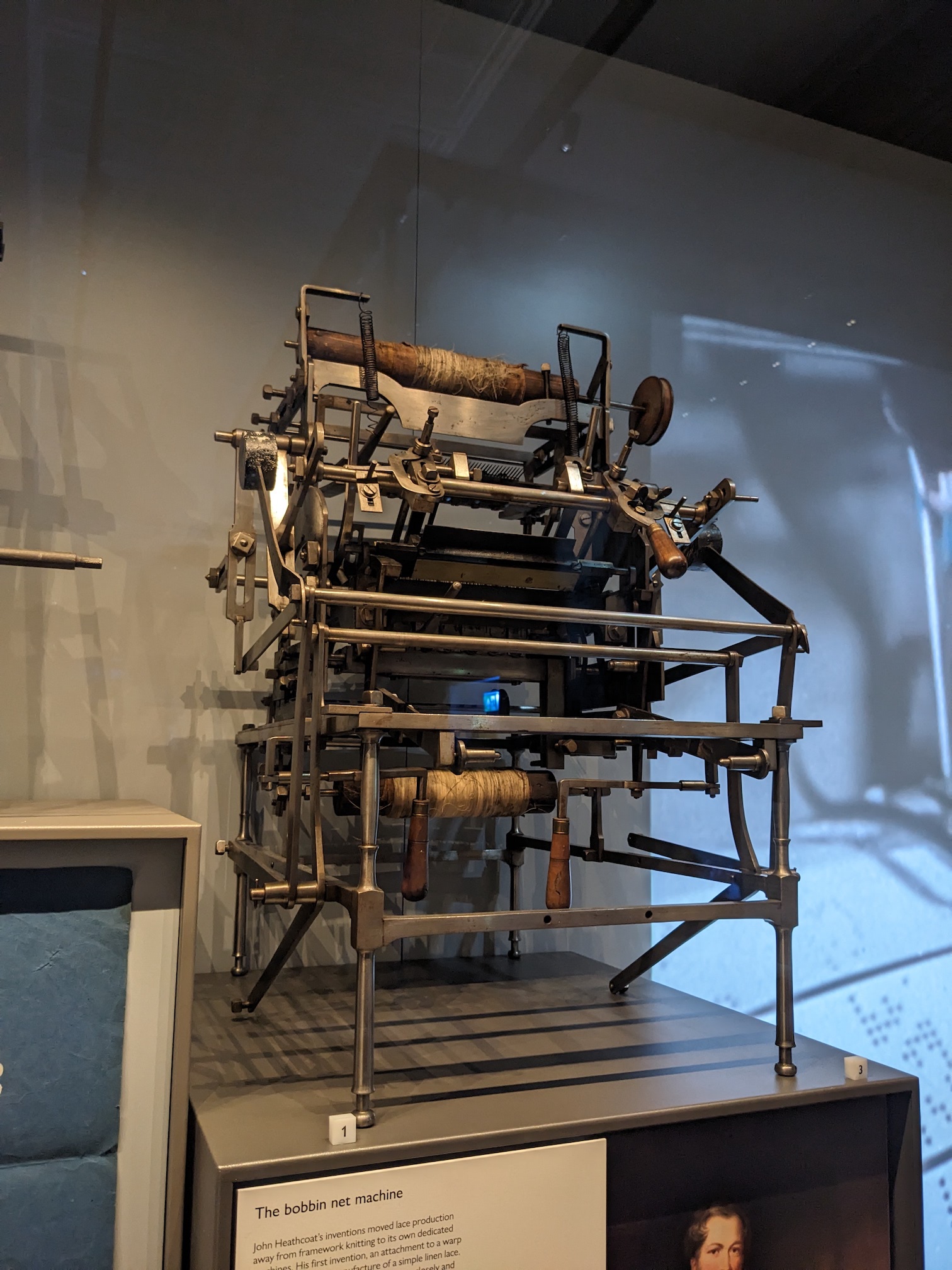
This destructive direct action, is the kind the Luddites are most closely associated with. The outcome of this attack was the arrest and hanging of six men, and the transportation of a seventh. The owners of the factory were awarded compensation of £10000 the following year, although this was never paid as a condition was that it be spent locally and by this time, the factory owner Heathcoat was already moving his operations away from the midlands - taking advantage of cheap premises and labour in the South West where the wool trade had failed. (Hammond, 1919 p.247)
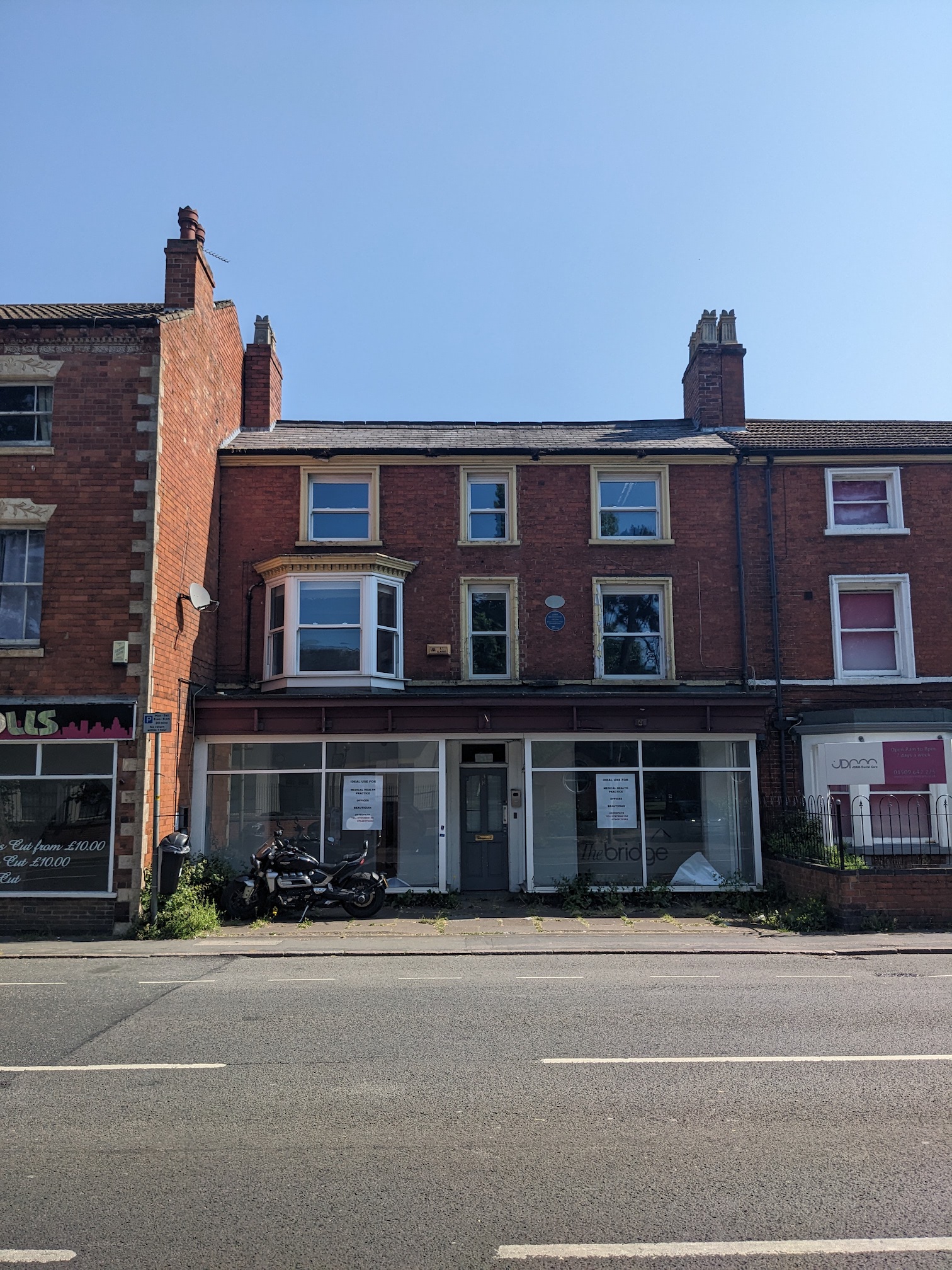
Machine-breaking, like the letters discussed already, was not unique to Luddism. During the emergence of Luddism, an emergency bill was passed that made the breaking of Framework knitting machines a capital offence. This was an update of the existing Protection of Stocking Frames, etc. Act 1788, which had been passed in response to earlier breaking and sabotage.24
In Tools for Conviviality (1973), Ivan Illich suggested a way of engaging with technologies, and actively participating in the worlds that tools create. “The conviviality he was aiming for was that tools should enable ‘autonomous and creative’ activity rather than producing conditioned responses or automatisation (McQuillan, 2022).
I think it is within this need for the convivial, that machine breaking can be explored as a technique of contemporary creative practices. “For Illich, a vital part of producing convivial technology was the idea of negative design criteria to define the limits within which tools are kept. […] As with the Luddites, Illich felt it was vital to limit the scope of tools in order to enable social justice.” (McQuillan, 2016)
The convivial is technology that is malleable and responsive. The framework knitting machines, although automating parts of the process, still required skill and knowledge to operate, and as large wooden frames were susceptible to wilful dismantling. With contemporary computational technologies, there is often a perception of more distance to the troublesome machines.
The reanimation of Luddite ideology has been explored by different groups at various times. This led to the neo-luddites of the 1990s through to the recent examinations of Luddism against ‘big-tech’. It is seen as a critical way of engaging with technology that is neither technophobic or technophilic (Juarez and Tierney, 2022). Writer Gavin Mueller finds potential in the ability of Luddism to “generalise”, stating, “it is not an individual moral stance, but a series of practices that can proliferate and build through collective action.” (Mueller, 2021 p.129) It is in this way that Luddism is accessible, and remains an active form of resistance.25 Investigating digital media technologies invariably leads to problematic ends that require actions- i.e. because of the materials used and the processes of their extraction or the entanglement of computation with military research. This inevitably leads to different responses.26
In Dismantlings, writer Matt Tierney (2019) aligns the 1970s North American literature and the emergent critique of technology at the time with Luddite techniques which he defines as the “performative breaking of machines that limit species expression and impede planetary survival”. (Tierney, 2019 p.13) Distinct from the earlier characterisation of epistolary Luddism, this technique, when performed through poetry and text is what Langdon Winner called “epistemological Luddism.” (Tierney, 2019 p.26).
This threads closer to the luddite archaeology developing here - the how-to replaces the poetry and becomes performance manual, and it is the (dis)assembly of the antenna that offers evidence.
In the work of Audre Lorde, the language of the tool is used to orient and decide which technologies should be used to what ends; “To Lorde, tools are for examining and dismantling, more than for making, and their most urgent task is to examine and dismantle the epistemological impediments to solidarity.” (Tierney, 2019 p.31) Lorde’s statement that “the master’s tools will never dismantle the master’s house” can be read as descriptive of the platforms and gated zones of digital networking infrastructure that constitute the master’s house. Indeed, popular metaphors for these places often acquire the domestic or pastoral, i.e. a house, a garden, a wall.
In conclusion Mueller states that “a collective politics requires recognising and recovering our own radical self-activity along with that of others. Even, and perhaps especially, when it involves breaking things at work.” (2021, p.136)
The question for artists is possibly around what constitutes the site of work.27 The ability for art to disconnect subject and context is part of what artivists Isabelle Fremeaux and Jay Jordan define as Extractavist Art, which emerges from a system contingent on limitless growth.28 (Fremeaux and Jordan, 2021) For Fremeaux and Jordan the answer is to refuse the terms of the ‘art world’ and follow a practice that does not separate aesthetics from ethics and is something like an “art of life”. (Fremeaux and Jordan, 2022) Modes of knowledge sharing, outside of academia or as hybrid models that move between spaces offer a clear framework for these archeological dismantlings.
It is also useful to recognise that alongside these critiques of the emerging computation of the 1970s there was resistance that included all of the techniques demonstrated by the Luddites. Aiming to reduce military capacity, the bombing of data centres or computer labs, which were often enmeshed in university campuses was commonplace.29 (Harris, 2023)
Luddite Commons
One of the conditions that was contingent on the Luddites and their contemporaries, was the enclosure of the commons that was carried out through parliamentary bills, beginning in the UK with the Inclosure Act of 1773. These acts enabled the transformation of commons into privately owned spaces.
Marxist historian Peter Linebaugh describes commoning as “conducted through labor with other resources; it does not make a division between “labor” and “natural resources” (2014) and as “primary to human life.” (2014) For Linebaugh, the commons is what provides a foundation for the state to emerge from, and yet it remains independent from it, with “custom, memory and oral transmission” maintaining its culture. (2014) Linebaugh also argues that these processes of enlosure were essential to the establishment of “racial capitalism” and exist as a pattern that is repeated across domains. At the time of the Luddites, this was the “enclosure of common land that created conditions for capitalist labour relations.” (2014). It is in response to this that the Luddite slogan introduced earlier calls to “put down all Machinery hurtful to Commonality” (Binfield, 2004) and seeks to halt these processes of enclosure.
Enclosed AI
Examining a contemporary context, Dan McQuillan’s Resisting AI (2022) notes the continued acts of enclosure enforced through technologies, and specifically AI, “which not only reiterates these enclosures but proliferates new forms at a previously unachievable level of granularity.” (McQuillan, 2022) This is part of a wider critique of enclosure that traces its operations from the enclosure of physical resources, through to the enclosure of information.30 The AI McQuillan describes is the current industry of machine learning algorithms using large language models. These technologies are increasingly used by different organisations in the processing of different types of data. They have recently reached a maturity that has enabled them to be interacted with directly by consumers, as a method for the generation of different texts, images, sounds or other artefacts that can be digitally rendered. “The new era of machine learning means that a similar overarching logic to that which revolutionized global supply chains, through the abstraction and datafication made possible by containerization, can now be applied directly to everyday life.” (McQuillan, 2022) The development of AI also broadly mirrors the drawn out, incremental development of the loom that, as we have seen, the Luddites faced.
The techniques of neural networks that are in vogue with much of current AI development are widely agreed were first developed in the late 1950s with Frank Rosenblatt’s Perceptron: “The Perceptron’s design was much like that of the modern neural net, except that it had only one layer with adjustable weights and thresholds, sandwiched between input and output layers.” (MIT, 2017) The conditions that allow AI to exist as a damaging and dangerous force McQuillan notes are “part of a wider system where extraction follows closely on the heels of abstraction, where everything of the world is seen as a utilitarian resource, not as a component of a fragile ecosystem.” (McQuillan, 2022)
Sociologist Adrian Mackenzie’s Machine Learners: Archaeology of a data practice (2017) traces a similar lineage of machine learning development, from within the institutions teaching and developing it, and the textbooks and video courses that surround it. Mackenzie also writes that “the recognition of ourselves as subjects of machine learning is primarily an archaeological task.” (Mackenzie, 2017).
McQuillan proposes that
to contest these new enclosures we can invoke the commons, not only in the traditional form of shared natural and cultural resources, but encompassing forms of organizing, relating and acting. Commoning is the action of taking aspects of the world back into common ownership and stewardship, and of organizing through structures of mutual aid and solidarity. Commoning is both a refusal of segregation and an assertion of the common good.(McQuillan, 2022)
As we will get to in the study of the VLF antennas, and more generally in the figure of the hobbyist – a complicating question is the definition of these commons. In creating and using technologies, particularly involving computation – it isn’t possible to exist entirely separately from the global infrastructure. It seems closer to a Temporary Autonomous Zone (Bey, 1991) – or even a parasitic or Trojan commons.31
The material depths at which we are able to define these commons shapes the kinds of politics and social relations they produce. Our systems of production and infrastructure, function through economies of scale. If we are to imagine other possible futures, at least with standards of living consistent with networked society, they need to reckon with the materiality that underpins its existence.
Scaling
For some, the following of this materiality does lead to the refusal of certain technologies. Farmer-poet Wendell Berry wrote that,
I would hate to think that my work as a writer could not be done without a direct dependence on strip-mined coal. How could I write conscientiously against the rape of nature if I were, in the act of writing, implicated in the rape? For the same reason, it matters to me that my writing is done in the daytime, without electric light. (Berry, 1990)
This extreme position, although many might agree with the sentiment, it is dismissed as simply impractical by most. But in the experimental arts could this be one place where these ends are considered as closely as possible. At what point does knowledge of the harm done by engaging with a technology undermine the possibility for resistance and change intended by the expression of creativity?
Researcher Daniel Chavez Heras uses Berry’s argument to consider this problem of scale and attention that comes with such ideals, and that to follow this completely is to abandon the global majority. Heras notes that this form of resistance is applicable to the scale of “art festivals and niche online communities, and not so much when we think about the global systems that regulate networked communications upon which millions of people depend everyday.” (Heras, 2023)
Our engagement with technology is generally performed through various compromises of our preferences for the way that technology should exist or mediate or interactions as society. For example we no doubt all hope that our phones/computers/cars don’t contain Cobalt mined by children.32 We accept terms that allow companies to sell our data or use it to train large language models.
Heras continues, “We might not like our dependence on these systems, and individually we might even be able to retreat from them, but I would caution not confuse this desire for individual emancipation with our collective responsibility to the many who cannot afford to resist scale.” (Heras, 2023)
This is also aligned with engineer Nick Chavez who writes about the importance of understanding the way modern production works, and the options available. Chavez understands this through considering the two main formats of factory production, high mix low volume and low mix high volume. These different sites, create different conditions and are sustained through different types of knowledge and labour. (Chavez, 2022) It is only through developing this kind of understanding, that imagined futures can become possible futures.
Work based on concepts such as half-earth socialism and degrowth provide tangible imaginaries of what a post-capitalist world might look like, and how it might function. If Luddism is a way of moving against extractavist technologies, these works imagine the world such resistance might move us towards.
In Kate Soper’s Post-Growth Living, the importance of hedonism is connected to these ideas – and understood as central to any possibility of these changes coming into being.
The aim is to open up the prospect of an eco-benign politics neither uncritically committed to technology, on the one hand, nor overly ‘back to nature’ in outlook on the other, but grounded in new ways of working and spending leisure time, and the sensual and spiritual pleasures they can provide. (Soper, 2020)
Soper’s text challenges the perceived benefits of life under capitalism and questions the potential for alternatives. My research here is connected to the role of artists. Ultimately, Soper sees the potential for change to occur through parliamentary representation and policies, which are themselves related to the “electorates themselves, the cultural influences upon them, and how these might encourage significant shifts in motivation and behaviour” (Soper, 2020) In this framing the role of the artist is important and active in producing those cultural influences.
As Fremeaux and Jordan (2021) have expressed, it is perhaps useful to think beyond the established categories of art and artist33. Responding to urbanisation and rural decline in China, Ou Ning redefines themself as an artivist; “a participant in social movements in the broad sense, but more specifically as a social actor with an artistic approach.” (Martine and Svetlana, 2021 p.101). This category was coined by net artist and activist Heath Bunting (Cowan, 1997) whose practice also resonates here. Bunting has long used wastelands and their “spontaneous ruderal vegetation” as reclaimed commons, showing that “the unchecked growth without human interventions turns out to be a radical counter-concept to the capitalist industry of exploitation.” (Weinberger, 2017)
Locals
Moving outside of these categories, creating new definitions and constructing manifestos is a powerful way of confronting the systems within which we work. It is akin to the imagined futures, found in Half Earth Socialism (Pendergrass and Vettesse, 2022) and The Solutions are Already here (Gelderloos, 2022).34 It makes a shift toward autonomy that attempts to distort the present.
Within experimental creative discourses there is a building intersection of the topic of degrowth and the impacts of computation through the exploration of permacomputing. Marloes De Valk has described permacomputing as
a counter narrative to the rapid “upgrade or die” cycle promoted by the tech industry. It is also somewhat paradoxical, linking an environmentally lightweight practice such as permaculture with one that is as resource intensive as computing, which doesn’t only weigh heavy on the planet due to energy consumption, but also through unethical and damaging practices in several parts of the supply chain, from mining to manufacturing. Most energy is used during the production and spectacularly wasteful end of life phase. This is unequally affecting the Global South. The term permacomputing hints at wanting to do better without being naive about this paradox. (De Valk, 2022)
These discussions seek ways to compute carefully and to question what we need to compute. These are decisions that must be actively made, to under-produce, under-consume, to the accepted norms. These limits force, often, a proximity to the computational surfaces, towards the lower-level, bare-metal languages.
On a broader scale and more generally the focus on sustainability and the avoiding of climate collapse is a common theme within the arts. Primary funder of the arts in England, Arts Council England acknowledge in their Let’s Create strategy plan that “the climate crisis and environmental degradation will be the most significant challenge facing all of us over the next decade and beyond.” (2020) Theories of permacomputing might go further by questioning whether things should be sustained as they are.
Let’s return for a moment to the situated and partial location of this research. These terms resonate within the local artist communities I participate in; the way these groups are constituted, their relationship to the city (Leicester), to a wider network and hierarchy of professionalisation. The deeper context of this, is that the sites of these communities are within the area of intense textile manufacturing processes (of the kind that the Luddites feared) as well as the area in which these historic factories stood, and machines were broken. The VLF antenna opens a channel beyond the expected, immediately sensible. Does a place, the history of a place, similarly open a channel to shapes of thinking, to different modes of storytelling?
We also talk about these movements, these acts of resistance as existing in places. If these are autonomous zones, they are so in different places. The story of the Luddites connects to the Midlands - as the place where these stories travelled through, and these actions were enacted. Might it be possible here, to draw these histories to the surface (even to perform an archaeology of Luddism) to place things on this soil? There is a partiality, and potential in considering the specifics of the local. A question opens as to whether ‘muddy’ archaeologies could also be performed.
In the practice of the VLF antenna, and its implicit process of listening – there is a connection to musician Pauline Oliveros and her manifesto of Deep Listening. This describes an ecological listening - ‘Quantum Listening’ that involves local and global scales. (Oliveros, 2022)
The methods used by the Luddites were local and specific. Threatening letters, the use of existing ‘common law’ and legal forms, machine breaking and sabotage were deployed differently by different bodies. The actions were amplified through the Luddite eponym, which also provided anonymity and the cover of confusion.
The continued extraction of the commons is what we are faced with today. This continues through the implementation of new technologies, optimised for growth and the continuation of capitalism. Articulating a resistance to this are the proposals of degrowth and refusal, along with the practices of artists and ‘artivists’.
It is within the three interconnecting strategies of Luddism; writing, conviviality and commonality that we will navigate this archaeology.
Eliza 35
The role of women within European society at the beginning of the industrial revolution was one in which many forms of work that had once been open to them had been closed off. The unwaged labour of housework, and child-rearing that made the advance of capitalism possible were the result of a long and sustained regime of oppression. Feminist theorist Silvia Federici outlines this in her work, Caliban and The Witch (2004). In this text Federici demonstrates how the witch-hunts of the 15-1700s redefined the role of women and provided the conditions that allowed capitalism to extract profit from hidden labour. Again, we are reminded of this as an essential condition of capitalism, that negates the conditions of commonality:
If capitalism has been able to reproduce itself it is only because of the web of inequalities that it has built into the body of the world proletariat, and because of its capacity to globalize exploitation. (Federici, 2004)
By the early 1800s women were still had jobs in parts of the textile industry, primarily earlier stages in the production, such as hand-weaving and carding. The later parts of the processing of textiles, involving the framework knitting machines was mostly regarded as men’s work.
As noted in the main thesis, there is only one Luddite letter that appears to be signed by a woman (Eliza Ludd). Women were not completely absent from the Luddite protests however. Historians Jennifer Grimmett and Malcolm Thomis have found several examples of women participating in Luddite protests and being arrested as a result (2013). They link these events mostly to places where the protests were more spontaneous riots, rather than planned attacks.
One example of this is the attack on Burton’s Mill in Middleton, 1812. The attack here was “was in part a sequel to food riots in Oldham as colliers from Hollinwood and other rioters from Saddleworth marched from Oldham to Middleton and joined local crowds to attack Burton’s power-loom factory.” (Grimmett, Thomis, 2013) Following the attack, five women were charged with “charged with rioting and accused of creating ‘noise and tumult’ and breaking the windows of Burton’s Mill” (Grimmett, Thomis, 2013). Thompson also traced the participation and prominence of women in the bread riots that took place throughout the 1700s. (Thompson, 1971)
Grimmett and Thomis argue that part of the reason for the absence of women from the organised Luddite actions could be the difficulty of them being in a place where they could organise with men. Much of the Luddite organising and planning seems to have been conducted in pubs. This is evidenced in the accounts of the Loughborough Job (Nottingham Review, 1816), and the enforcement of curfews on pub opening times.
Whilst the introduction of more automated knitting machines entering the factories meant an increase in the availability of jobs for women (and also children) this was under dangerous and poorly compensated conditions.
Researcher Meredith Whittaker has written about the ways in which the methods of control developed on the plantations and with the slave trade were translated into the development of automated machinery (2023). Whilst slavery was abolished, the forms of domination and production were evidently translated into the factories and ‘dark satanic mills’.
As Whittaker writes, the “blueprint for modern digital computing was codesigned by Charles Babbage.” (2023) Babbage36 was influenced by the invention of the Jacquard loom that utilised a punch-card programming technique. There is a tangled trajectory in the development of these automated machines which is followed expansively in philosopher Sadie Plant’s Ones and Zeroes (1997).37
If we follow this, shifting focus toward computation, it is well known that the term computer originally referred to humans performing the calculations that machines would later replace. This technique was developed for the use of astronomy (whilst Babbage was serving as Chief Astronomer) but accelerated in development during the war periods of the early 1900s. By this time the computers were often women, and would be paid half the rate of men. (Grier, 2007)
The global textile industry today, remains in a state of continued development towards automation, but still with the use of human labour in the cheapest conditions possible. This is largely offshored to the global south - yet also persists as part of the UK industry of fast fashion. During the COVID-19 pandemic, the sweatshop conditions of textile factories in Leicester was exposed. (See Nilsson, Wright, 2020) There is also evidence that the textile industry today globally perpetuates the same inequalities recorded during the time of the Luddites. 140 organisations signed a letter to European Policy makers in 2023, calling for gender responsive legislation:
Pollution, land grabbing, the exploitation of workers and violence against human rights defenders all have different and disproportionate effects on women and groups facing marginalisation. Any legislative initiative that attempts to regulate business conduct must address such gendered and intersecting impacts,especially considering that in many sectors, such as textiles and agriculture, women make up the majority of the workforce. Many women are further discriminated against based on intersecting identities such as age, class, ethnicity, caste, migration status, gender identity, faith, sexual orientation and/or other factors. Gender-responsive due diligence rules and access to justice are urgently needed to properly address these deep-seated inequalities.
Grimmett and Thomis note the Chartist movement and resistance to the poor law, as a culmination point for more visible, organised forms of womens protest which emerged in the 1830s. As I mention in the Ludd Walk chapter, Leicester Luddism was concurrent with the abolitionist campaigns and activism of Susanna Watts and Elizabeth Heyrick, which were also influential in the development of the feminist movement.
Recognising the conditions that mostly precluded women from the original forms of Luddism underscores the social nature of the protests. It isn’t about a simple destruction of technology but always the changes they are used to introduce. Luddism as a strategy is a calculation - (or computation) arrived at when the path of non-resistance is worse than that of resistance. It is premised on the ability of a group to hold on to a commonality and organise and as such Luddism is a defensive strategy. It is much more difficult to argue for what conditions the women and children of the 1810s would be defending. A priority for most groups perhaps has to be an offensive establishment of rights and the conditions of commonality.
This is the framing that meets the statement that “feminists can’t afford Luddism” (Bryson, 1999). Researcher Mary Bryson draws on Donna Haraway’s Cyborg Manifesto, stating that the best option is “that minorities involve themselves with digital tools and delve deeply into the possibilities for creating new and potent forms of subjectivity in their engagements with the cyber-mediated world of zeros and ones.” (Bryson, Jenson, de Castell, 2002) Plant adds to the this cyborg reality, with the statement that:
Hardware, software, wetware - before their beginnings and beyond their ends, women have been the simulators, assemblers, and programmers of the digital machines. (Plant, 1997)
Any critical engagement with computational technologies must navigate between these positions, with acknowledgement of what is negated by them. This is similar to Heras’s cautionary arguments towards a computation within limits, and who might be excluded from an imposition of those limits.
Resistance
How To (2)
Now we will attach the wire to the frame.

I’m using enamelled copper wire. The thickness of the wire is measured as 20AWG. The method will also work with other types of wire. I had good results with some old speaker wire. The important thing is that you have enough wire to create a large enough surface area.
To calculate the amount of turns needed we follow Romero’s advice to create an area of at least 12m2.
For my frame the sides are each 110cm, so the area created by a single loop is caluclated as 1.1m x 1.1m = 1.21m2. Therefore to make 12m2 we need at least 10 complete loops.
Thread the end of the wire through one of the holes you made earlier to leave about 10cm. You can fold this and tape it temporarily to the frame.


Now begin to carefully wrap the wire around the channel of the frame.
Already you are listening. The wire creaks in tension around the frame. Keep count of the turns… A tally scratched onto the frame itself, a separate piece of paper, spoken aloud… I find numbers slip easily to other values if I don’t keep a careful watch over them – and so during the time it takes to complete a circuit I’ll mumble the number repeatedly, 1, 1, 1, 1, 1, 1, 1, 2, 2, 2, 2, 2, 2, 2, hoping to fix it in place long enough to keep the count accurate.
You can use an old headphone cable or audio jack connected directly to the antenna if you wish. In our design we are instead attaching a stereo socket. Mount the socket onto the small panel you made earlier to cover the void. To do this drill a hole just large enough for the socket to poke through. Once the socket is pushed through you should be able to thread the tightening nut back on to the socket to hold it in place.
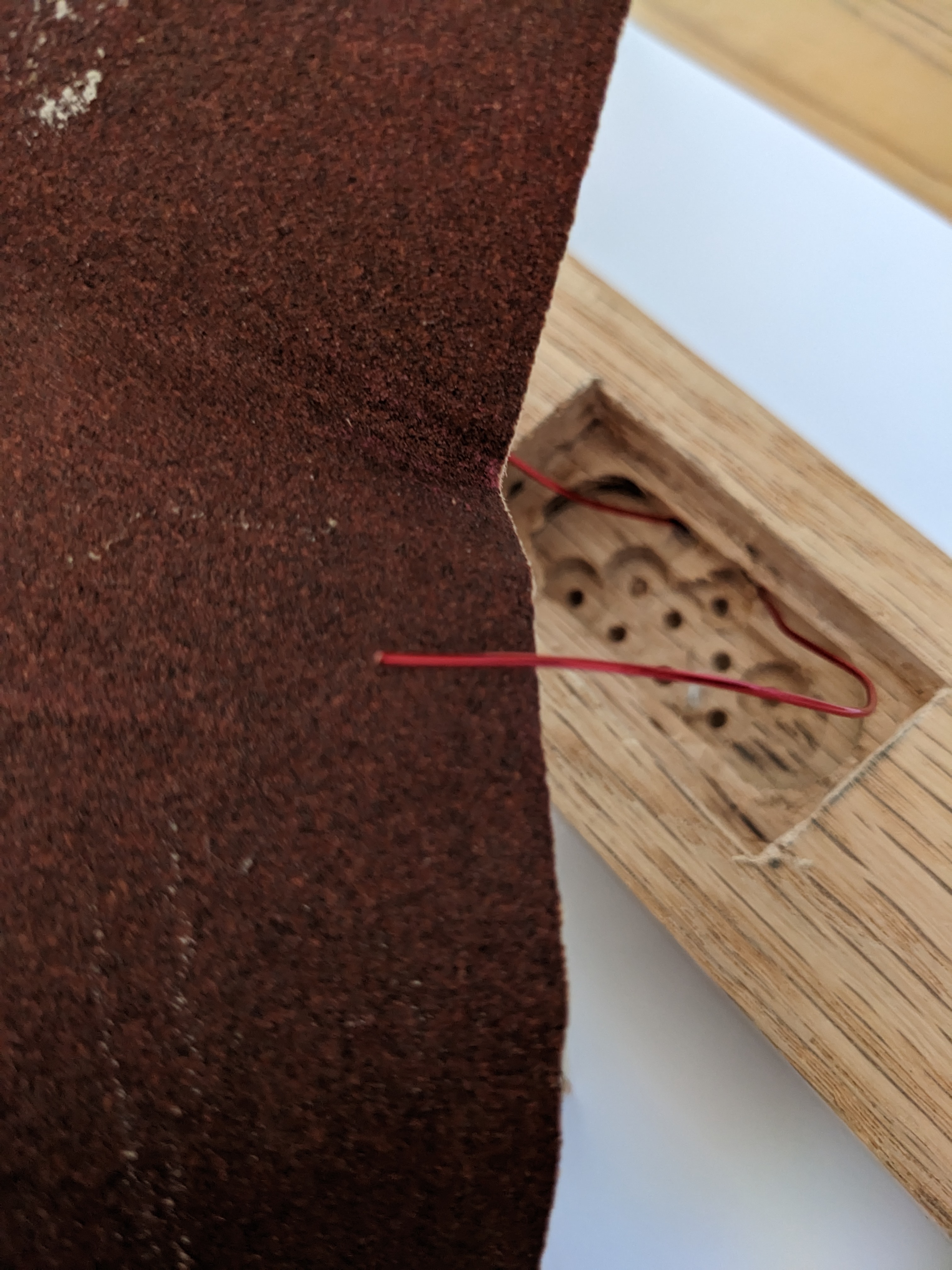
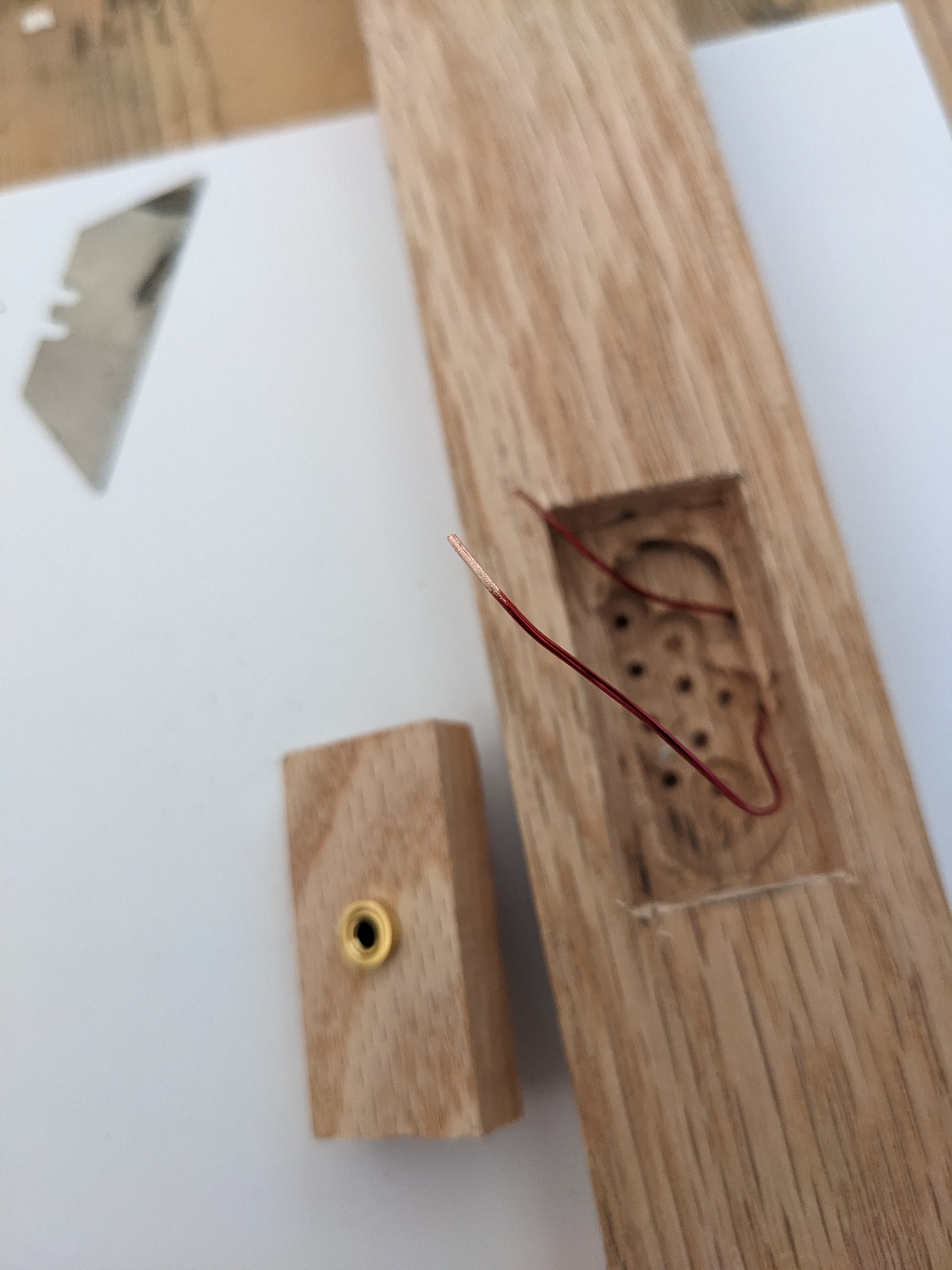
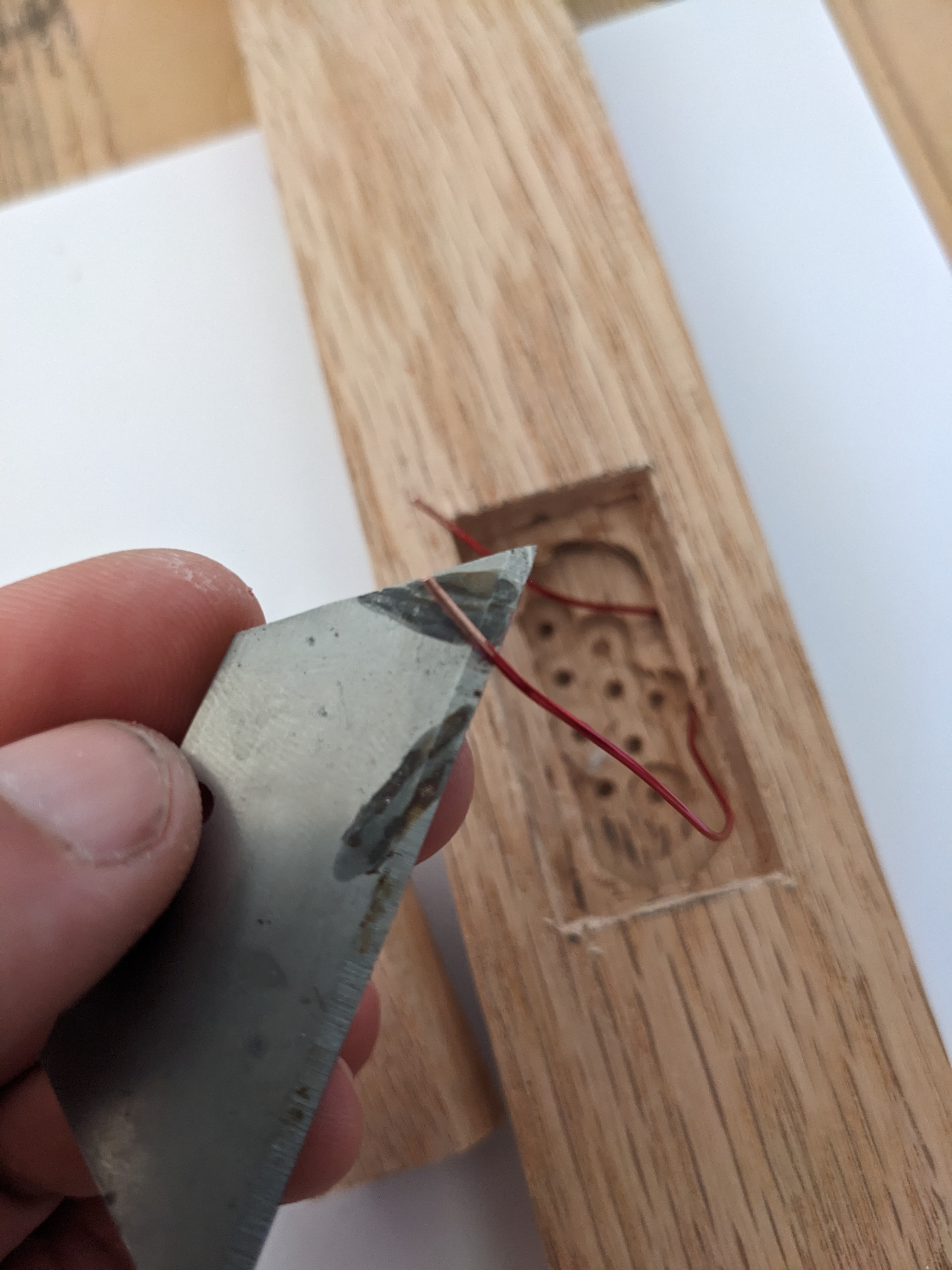
Expose the two ends of the enamelled wire. Use a blade or sandpaper to scrape away about 1cm of the enamel.
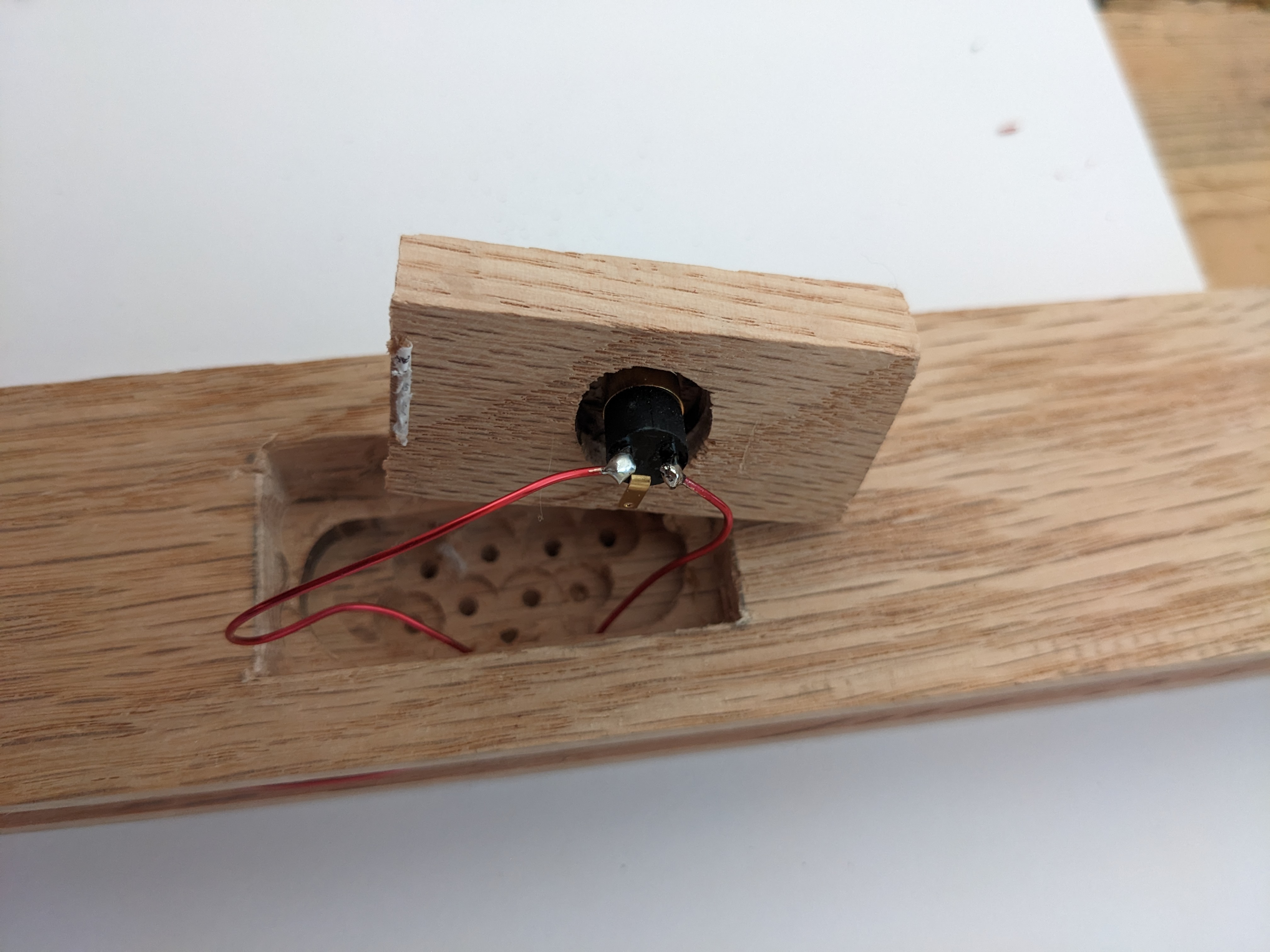
Use a soldering iron to attach the ends of the wire to the left and right legs of the socket.
Push the panel back into place.
If needed, you might choose to use some small screws to hold the panel in place.
Hobby Radio
Radio is an archetypal hobby. There seems to be a combination of factors that cause this, but perhaps among the most compelling is the way it augments our abilities for communication. Radio is included in the 1924, The Book of Hobbies; or, A guide to happiness which declares: “There is no more fascinating way of observing life than to have a radio set capable of receiving all kinds of messages from at least half of the world. Such a radio set is within the average means, and can be built from parts easily purchased.” (Taussig, 1924)
The use of radio frequencies is heavily regulated, with national and international laws that restrict what can be done within arbitrary sections of the spectrum. In the UK the regulation authority is Ofcom. The Radio Society of Great Britain provides an organising body for radio amateurs. The electromagnetic spectrum has been strictly categorised and subject to regulation since end of the nineteenth century with only the part “visible to the naked eye,” evading enclosure. (Fuller, 2005)
The history of pirate radio has an important bearing on the discussion of radio. Pirate radio exists alongside and interlinked with the regulations of hobby and amateur radio. These histories have been explored in detail by Fuller in Media Ecologies (2005) whose focus was on London based pirate radio, and author Christina Dunbar-Hester in Low Power To The People (2014) whose focus was the low power radio of Philadelphia-based collective Prometheus. As with other parts of this research the histories of pirate radio are very localised and contingent on the communities broadcasting, their reasons for doing so and the techniques used for transmission.
The self-determined use of amateur separates the organisation from the market potential of the hobbyist. The licencing stipulations also attempt to limit this through the condition that the radio equipment is used “as a leisure activity and not for commercial purposes of any kind.” (Betts, 2022)
During WWII RSGB members were recruited in efforts to decode enemy transmissions. The existence of radio amateurs, as citizen OSINT (Open-Source Intelligence) networks, persists today – for example with the dutiful logging of Russian military radio broadcasts on web-based software defined radio forums, or even as described in the Foundation Licence Manual, as a resource when conventional communications have failed: “amateurs have their own equipment, ready charged batteries and the technical skill to set up communications in unusual or adverse conditions.” (Betts, 2022)
The specialist equipment required (part of any hobby) in the case of radio, will often require a shared resource, such as an antenna. This physical necessity creates additional needs, each adding to the network of care that can allow the persistence of the community. It is perhaps this need for a continuation of care that leads to the distanced image of the hobbyist, as outside of the normal. The group needs to articulate its difference, whilst remaining open to the growth of the community.
The activity of the radio hobbyist is also easy to categorise as hobby. A typical communication is likely to a minimal amount of information – identifying the sender location, location received, and clarity of the communication. The description from the 1920s has changed little today:
Are these messages always interesting? They seldom are, in themselves, but the atmosphere that they create is well worth the time spent in tuning for them. A man is not vitally interested in the fact that a girl in Berlin is telegraphing a message of affection to her sweetheart in Madrid, or that Don Carlos & Co. in Buenos Aires are rejecting a shipment of cotton goods from a firm in New York, or that Mrs. Jones is glad to tell Mr. Jones that she has recovered from her attack of sea-sickness and expects the Leviathan to land next Wednesday noon; but he is interested in people and what they do and what they think, and thus he receives much pleasure from listening to what his fellow men all over the world are doing and thinking. (Taussig, 1924)
In the practice of reception only, as can be performed without a licence, or through online SDR (Software-Defined-Radio) portals, it is simply the act of decoding that is taking place. The ephemeral transmission is translated by the listener into a written record.
Copper
The construction of the VLF antenna requires a length of wire. Copper wire is most commonly used. The required amount is calculated from the size of the frame. In trying to follow this archaeology of material, we can notice already, at this level of simple component, there is a transformation of the conventional consumer experience - and the role of the hobbyist as a specialist consumer is more appropriate. The length of wire is not how the product is described for sale. Rather, the product is described in terms of its weight. Further calculations must be done by the hobbyist to convert the weight into length. This consumer processing points to the unprocessed status of the wire. It is closer to a raw material.
Geographer Martin Arboleda in Planetary Mine (2020), describes succinctly the processes of extraction and refinement that create copper wire:
Autonomous trucks and shovels working at nearly 4,000 meters above sea level put the metal into a semiautomated train, which then takes it to a smelting and electrorefining facility, where computerized ovens transform it into copper cathodes. The cathodes are put into containers and sent to one of the megaports of the mining industry in the Atacama Desert, where gantry cranes load the cargo into a container ship. After crossing the Pacific, our container is unloaded by the swiftness of the vast mechanical systems of the capital-intensive Chinese ports. Finally, the copper cathodes end up in one of the infamous “dark factories” of the Pearl River Delta. Here, robots and computer numerical control (CNC) machine tools operate in the dark, turning copper into the wires that hundreds of thousands of human laborers in electronics assembling facilities will later etch into the electronic gadgets we carry in our pockets. (Arboleda, 2020)

We can zoom in somewhat on some parts of this, expanding this generalisation to provide some specificities. The Atacama Desert, Chile, is the location of the largest copper mine in the world, the Minera Escondida, operated by BHP. This is in itself already a complicated statement. BHP own 57% but Rio Tinto are also a large stakeholder, and these are the two largest mining companies globally. Copper is mined throughout the world, however it is mined in the highest quantities in Chile. According to NASA, in 2010, Minera Escondida was producing 9.5% of world output. As documented in The Copper Mark accreditation, “there are a total of 10,567 workers on site. Of these, 3,621 are employees and 6,946 are contractors.” (The Copper Mark Company, 2022)
The copper concentrate produced by both plants is sent through two slurry pipelines, to the Coloso Port facilities located south of the city of Antofagasta. At Coloso, the pulp undergoes a pressure filtering process after which concentrate is obtained with 9% humidity. The concentrate is later shipped by land to consumers in Chile and by ocean freight to the various clients around the world. (BHP, 2008)
The copper cathodes are traded on commodities exchanges, where they are graded and registered. The copper is purchased by “wire rod plants and other companies engaged in copper processing, which use cathodes to produce wire rod, other rods, flat bars, pipes, sheets and belts” as well as other intermediaries. (KGHM website) The copper wire available to hobbyist consumers likely comes from a wire-mill. The wire-mills are accessible locally, as well as from the ‘dark factory’ sources that Arboleda discusses (2020). Verifying local sources is not much clearer though. There is exceedingly little information offered in the wire manufacturers information detailing their relationships with the mining companies, or the copper suppliers. The interaction of these manufacturers with their wider industry is sometimes revealed in minor ways through their tax filings. Large UK supplier, Amnack (Doncaster Cables) details the difficulty caused by needing to adopt new methods for constructing cable spindles, following the war in Ukraine and ceasing of the supply of birch plywood from Russia. The alternative supplier was Chinese birch, which then led to the re-design of some packaging processes due to a change in wood qualities. (Mallinson, 2022).
In a recent report for the Financial Times, Monica Mark writes that over 22mn tonnes of copper are now mined annually and that it remains an essential component across industries as a ‘green energy transition’ is attempted. “Unless production is ramped up and new extraction technologies come into play, “the ensuing scramble may be compared to that for fossil fuels in the 20th century”, analysts at S&P Global warned last year. " (2023) Copper is also entangled with the extraction of other ores, which are also seen as critical to a transition to more sustainable energy sources. Cobalt is an essential metal in the production of batteries. In Cobalt Red (2023), Siddharth Kara examines the devastation that is permitted within the Cobalt industry in The Democratic Republic of the Congo, where it is mined along with Copper. Kara evidences that through traders, depots and buying houses, metals mined in horrific conditions are able to enter the supply chain, enabling the producers of products using these materials to claim their supply chains are verified and conforming to human rights. As Kara clearly demonstrates, the structures that permit such harm to continue undermines any conceptions of ethical technology:
The implications of this moral reversion, which is itself a form of violence, stretch far beyond central Africa across the entire global south, where a vast subclass of humanity continues to eke out a subhuman existence in slave-like conditions at the bottom of the global economic order. Less has changed since colonial times than we might care to admit. (Kara, 2023)
Copper is essential to our current computational and electrical infrastructure. It is also, for now, still widely available to the hobbyist - through the tendrilous global mesh. In the next section I explore the poetics of resistance and the electrical phenomenon that makes copper such a valued commodity. In Mark’s essay, there is a circuitous foreshadowing of this in the accounts of gangs stealing copper from infrastructural sites, such as hospitals and railway signal stations along with industrial sites, including those of mining companies that are themselves extracting copper. (Mark, 2023, Royal Bafokeng Platinum, 2022)
Flow
The act of transduction performed by the antenna is a process of resistance. The electrons move against the resistance of the wire. The conduit of the antenna performs a necessary control of flow energised by the electromagnetic waves in the air.
In global infrastructure, the supply chains that enable a material to move from within the earth, be processed and sold, the control of flow is important. It is the points at which flow can be controlled, stopping completely, or slowing down – that power is contested and through which strategies of local resistance emerge. Artists eeefff conceptualise different timescales and facilitate interventions into the architecture of infrastructure through copper wire – a technique of fooling the way the infrastructure sees itself and forcing it to take evasive measures, for which they use the physiological term reafferance (2023). This is achieved through placing wires in specific configurations on railway tracks. The automated, and remotely operated systems that maintain safe operation of the railway classify these placed wires as trains on the line, and halt the actual trains. Similarly, in Tekla Ashlanishvili’s A State in A State (2022), the points at which railway gauges change opens up sites of potential – contested by local governments and international bodies. Ashlanishvili’s film shows that it is the different people that converge at these points that cause these changes of flow to happen. It is possible because of a certain technological setup (the different railway gauges) but mediated by people.
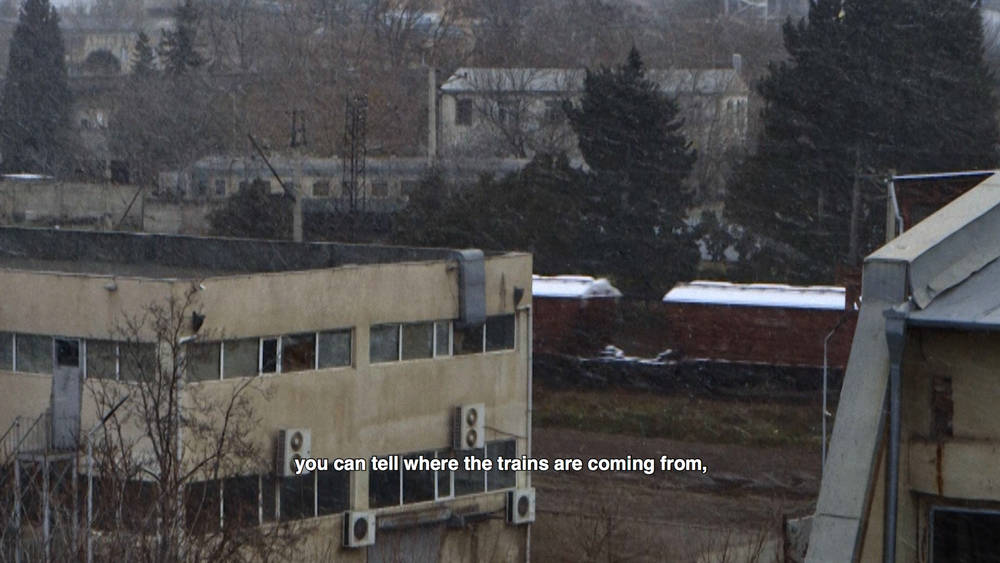
The network society (Castells, 2001) is built around an infrastructure of physical nodes that are a familiar part of the environments we live in; things like routers, telecom boxes and antenna arrays mounted on building tops. We might also include the large windowless buildings that run servers and other parts of the network from strategic locations, and are often incongruously nestled between regular looking office blocks or businesses. The connections between these often remain further obscured; glimpsed as cables disappearing underground, or as things that simply occur outside the bounds of visible light. The transmission of data between these nodes takes place at many points through different zones of the electromagnetic spectrum. It moves stretched and condensed, at wavelengths ranging from approximately 0.00075mm to 125mm.
These moments of transmission are shared excursions – light pulsing through the bandwidth commons of undersea cables, and point to point hopping through CDNs, from street-side cabinets, to domestic routers.38 Error correction is also part of this process, the processing of transmissions with additional data that allows for the intended message to be deciphered or reconstructed in the case of noise.
| Name | Frequency range | Wave length | Signals |
|---|---|---|---|
| Super low frequencies | Below 3 Hz | More than 100000 km | Geomagnetic pulsations |
| Ultra low frequencies | 3-30 Hz | 100000-10000 km | Brain electrical activity |
| […] | |||
| Very low frequencies | 3-30 kHz | 100-10 km | Natural radio signals |
| […] | |||
| Low frequencies | 30-300 kHz | 10-1 km | Long wave broadcast |
| […] | |||
| Ultra high frequencies | 2.5 gHz | 12.5 cm | 2.5 gHz Wifi |
| 5 gHz | 6 cm | 5 gHz Wifi | |
| 300 gHz - 430 tHz | 1 mm - 700 nm | Infrared |
The primary phenomenon received by the VLF antenna is the register of self-regulating, high-energy, lightning strikes that occur across the globe. This happens because there is a continous flow of current, from the air to the ground. This difference would soon be dissipated if not for the continued charging of the earth, by lightning. (Gottlieb, 2013) There is a tension in the different levels of resistance within these different bodies; the earth, the air, the antenna, the human. Resistance and mediation. A point of scalar confusion or disruption can also be seen in considering the perceived effects of flowing current, which are instantaneous (the flash of a lighting bolt through the sky, the flick of a light switch) and the speed of the actual electrons (measured as the drift velocity)which is such that in a standard domestic wire, a single electron might only move about 0.02cm a second. (Heathcox, K. 2001)
Practices
The construction method I have followed is drawn from the Renato Romero’s Radio Nature (2010). This text describes the minimal essential components for the antenna to function. This publication is one outlet of the experimental radio practice of Renato Romero, who has been maintaining an online, open lab dedicated to VLF since 1999. This website documents experiments with different devices and tools to facilitate the reception of very low frequency waves.
During the course of this research I have experimented with several different techniques and approaches to building these antennas. These were also influenced by the experiments of artist Dan Tapper, who recorded similar experimental constructions based on Romero’s designs. The designs in Radio Nature provide an entry point to the minimal construction explored here, but really they are assembled as part of more complex instruments. Some of the antennas I have built are documented in the appended sound recordings and figures, including: Hexagonal, Desktop and Salvaged. The antenna described throughout the text here is documented as Big Square.
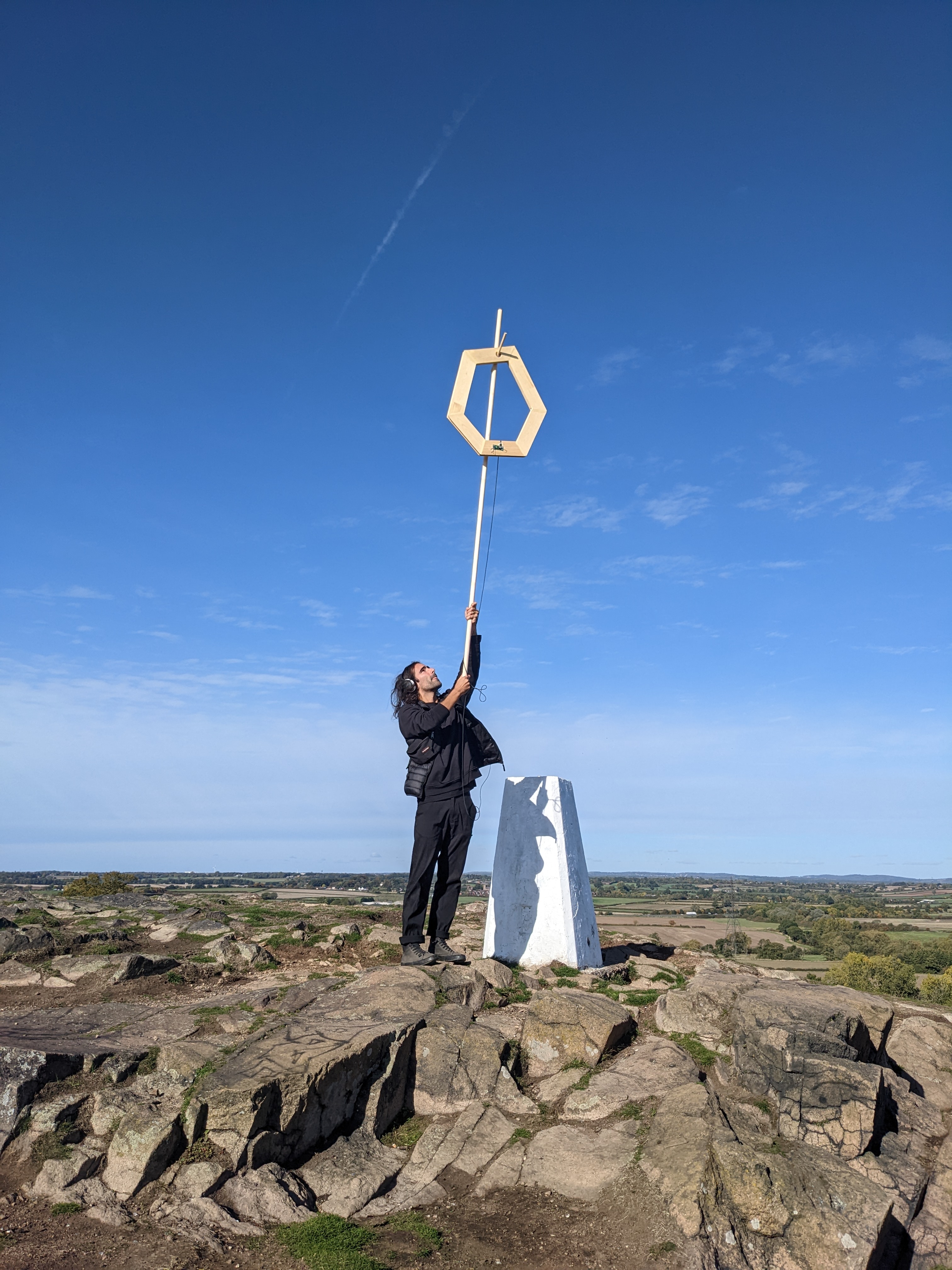
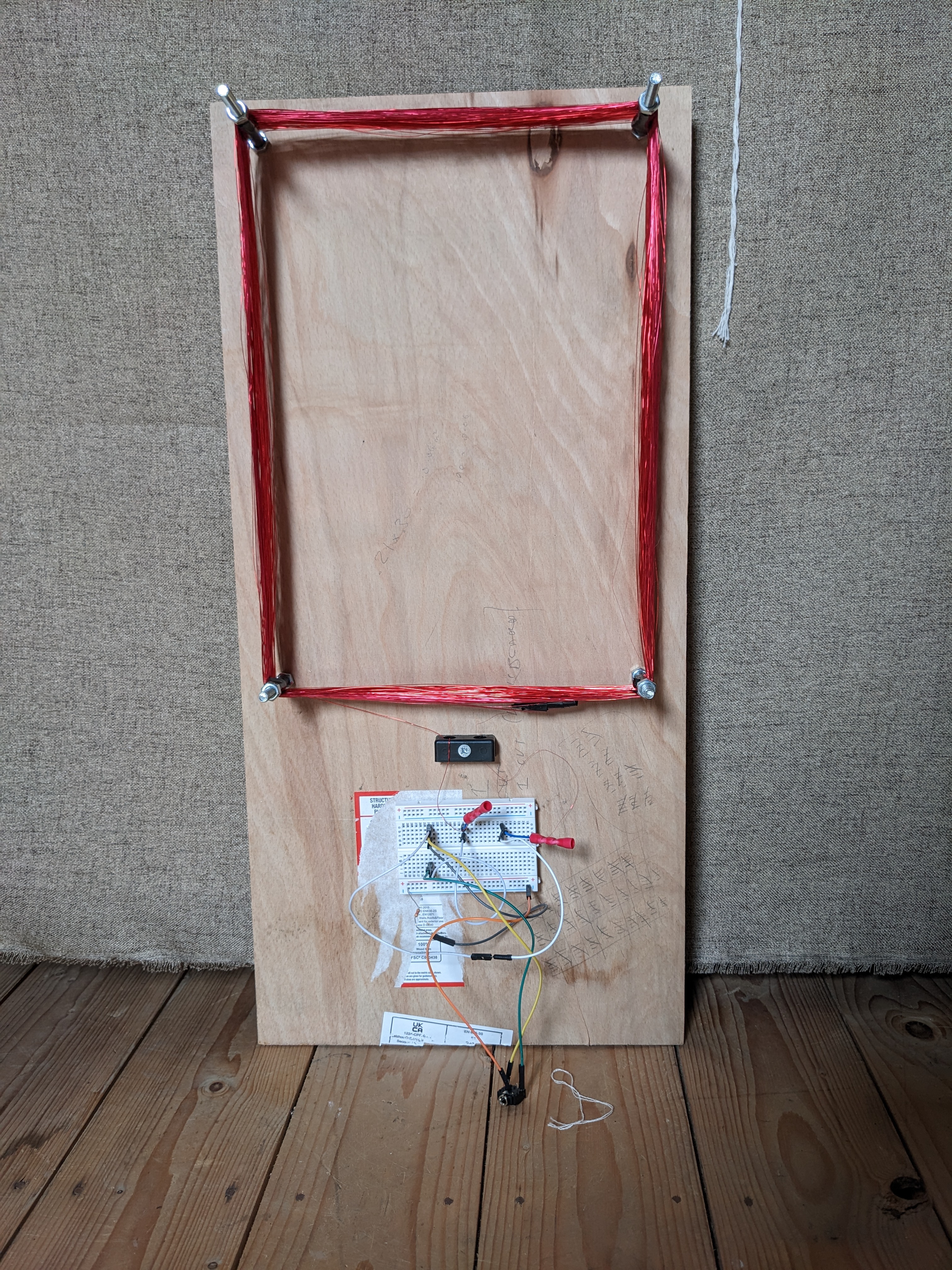
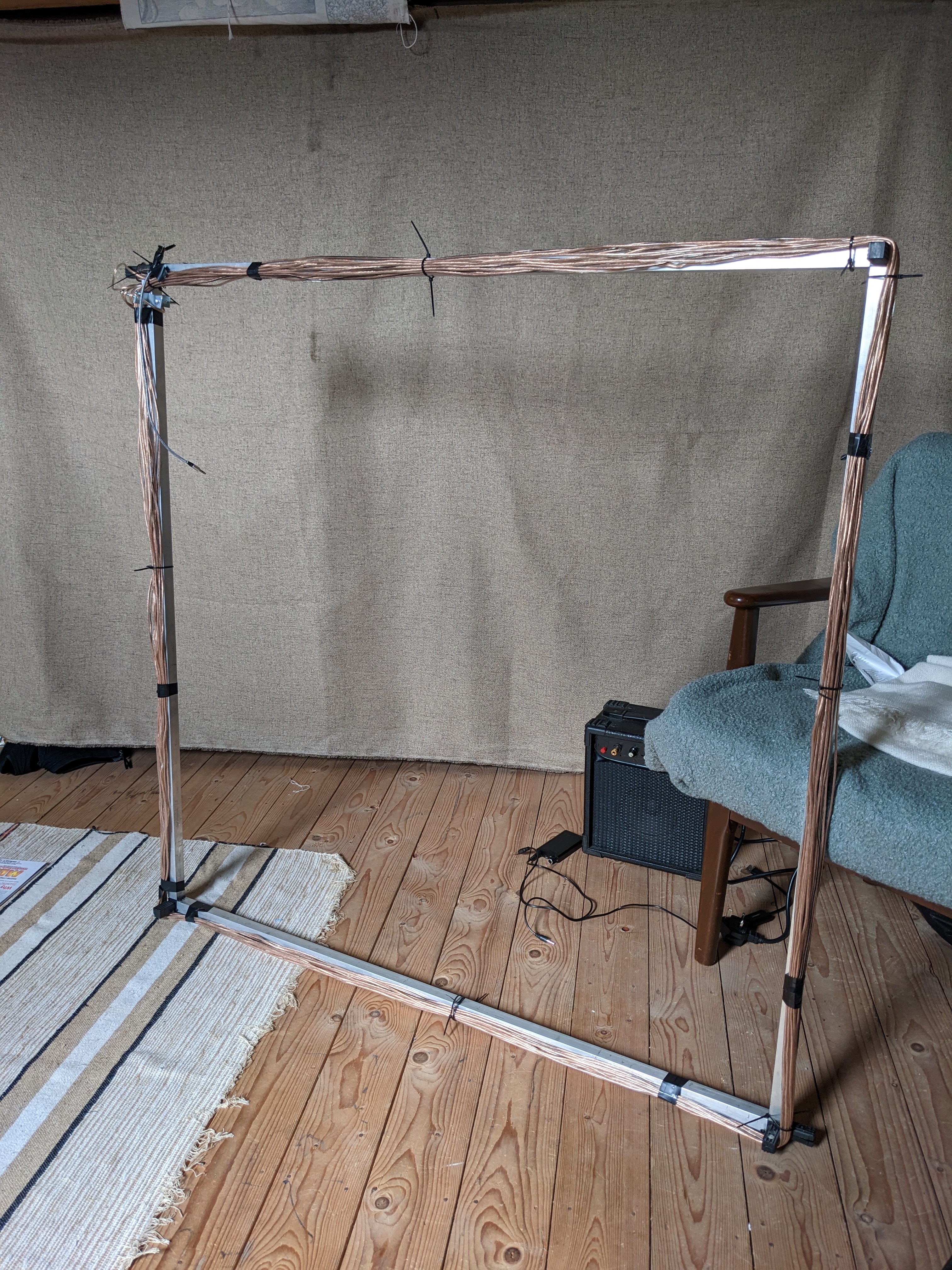
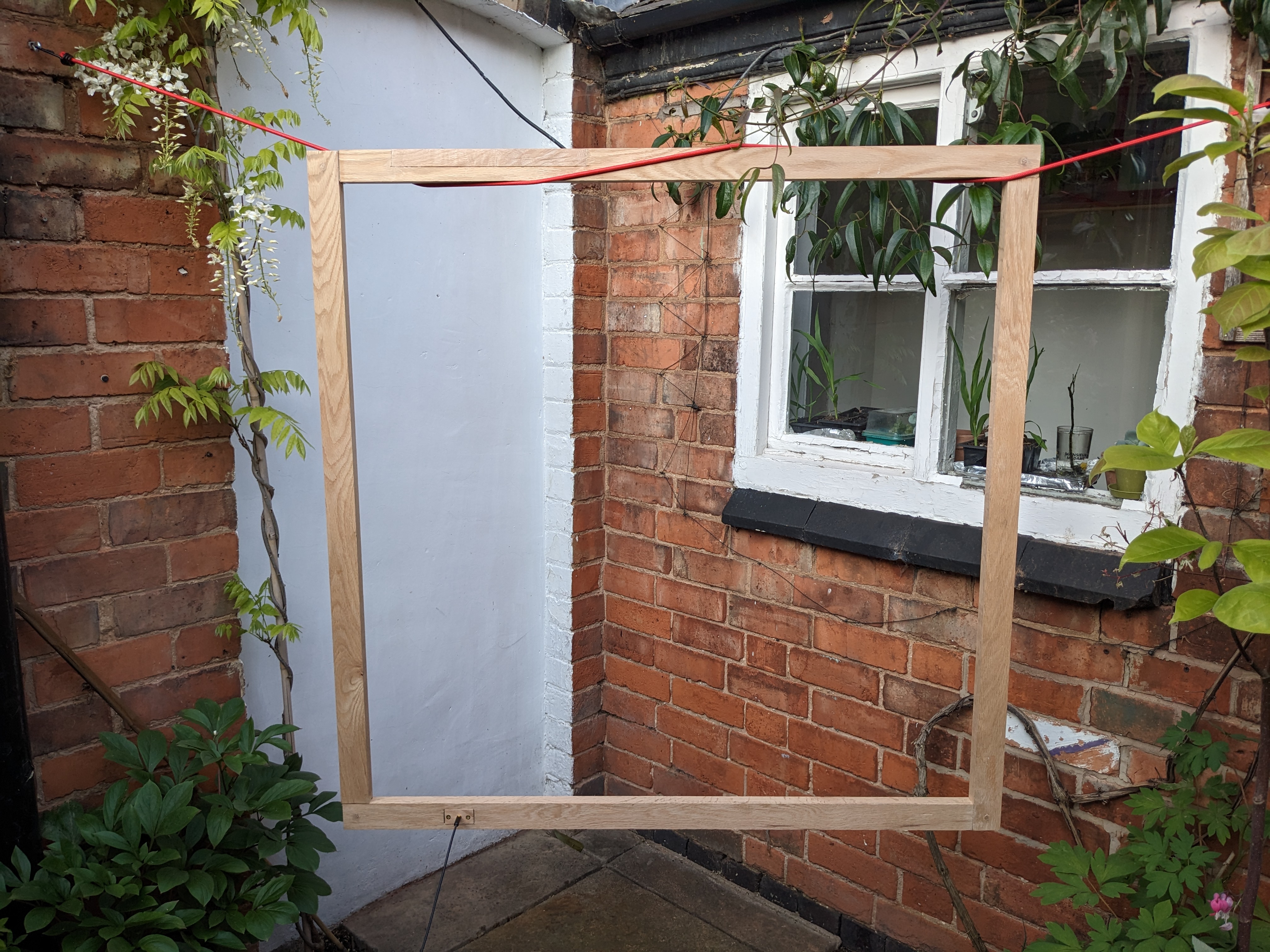
The design of antennas is important across computing scales. Where devices use printed circuit boards, it is common for the antenna to exist as part of the printed circuit board itself39. The antenna allows for the reception and transmission of electromagnetic waves.
Working in the critical design tradition Anthony Dunne describes the electronic object as in addition to the familiar consumer experience of a dematerialisation into software, being a system that dematerialises into radiation (Dunne, 2006) and that we are in ever-increasing proximity to them.
The extrasensory nature of these parts of the electromagnetic spectrum and the contingency as sensory to electronic objects, represents a space for different experiences to emerge or to be cultivated.
Writing about composer Alvin Lucier’s recorded VLF work, Sferics (1980) Dunne reflects on the importance of the process of listening itself,
Although the sounds are fleetingly beautiful, out of context they lose much; their beauty is entwined with the effort endured and the symbolic significance of receiving them, which for some is quasi-mystical, for others a defiant gesture against people’s careless attitude toward nature. (Dunne, 2006)
Dunne identifies a possible drive of the VLF hobbyist, and certainly one that aligns to the creative practices I’m concerned with here. The aesthetic experience of listening and the politics of listening.
In the rest of this section I will focus on examples from several artists working with VLF radio or adjacent practices and consider them in relation to the Luddite methodologies explored above, and simplified as commonality, writing and conviviality. I’m interested in the proximity of the Luddite archaeology to experimental creative practices. In the same way that Luddism was not unique or new in its approaches, I don’t think they are necessarily novel approaches to practice today. However, the point of the archaeology is that taken together and considered as Luddite, it surfaces a certain set of intentions.
The practice of building antennas collaboratively or the production of how-to guides and sharing of methods can be linked to practices such as Jennifer Gabrys’ Citizen Sense, feminist radio collective, the Shortwave Collective40 and earlier workshops convened by Hildegaard Westerkamp.
In researching artists working with these media, it is more often the case than not, that these works are the results of collaborative processes. It is logical that a practice of listening, and transmission, would require multiple people to articulate its speaking/listening states.
Convivial Hobbies
Performance artist Tetsuo Kogawa began various projects experimenting with broadcasting through free radio and micro-radio. Kogawa has spoken about using the medium of radio broadcast and recording, to open up communication between the students he was teaching (Chandler, 2005). Kogawa perceived radio as a weaving medium, capable of “intertwining people and creating interpersonal space.” (Chandler, 2005).
Kogawa’s practice has been described in terms of the convivial, and indeed, Ivan Illich even participated in a broadcast of the Home Run Radio micro-fm station that Kogawa supported. Anja Kanngieser writes that:
What was recognized to be at stake was a different way of employing technology; a way that was contingent on radio’s topologies and actants – the rooms and constellations of buildings, the microphones, airwaves, antennas, (later) Internet platforms, amplifiers, the voices, food, drink, intimacies, corporealities, psychic states, hands, gestures, cables and so forth. Through this employment and organization, micro-radio was configured as a political and therapeutic dispositif – a device for action. (Kanngieser, 2013)
Kogawa’s practice is deeply connected to a defense of the commons. Micro-fm exists in the frequency zones deemed unproductive to the state and left to common use.
The technical proficiency of the transmitters, was also deemed as less important than the immediate communication of the people sharing a room, microphone, broadcast and “in extreme cases, people didn’t really mind how far their transmissions reached, or who was listening to their program.” (Kogawa, 2013) On the influence of Illich, Kogawa writes,
“Tools are not only technological means but also a space of sharing that relates individual bodies. ‘Conviviality’ expresses how tools can be used creatively and joyfully, in ways totally different to the impersonal use pursued by industrial mechanisms.” (Kogawa, 2013)
Through writing, Kogawa shared plans for mini transmitters, that were designed to be legible to a wide audience and possible to implement cheaply. Kogawa calls this the Simplest FM Transmitter. Similar to the VLF antenna I have been building during this research, the tiny transmitter accepts its poor functionality, trading technical proficiency for accessibility and “experience a convivial wireless imagination by this transmitter” (Kogawa, 1991)
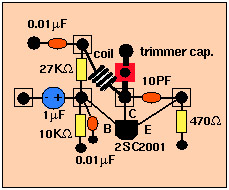
If we think about this aspect of commonality, of making commons. The VLF antenna and adjacent radio/electromagnetic works prove to be effective at articulating what these commons are; the physical spaces that a technology might be interacting with and the combinatory effect of scales. This is demonstrated by Martin Howse and Shintaro Miyazaki’s Detektors(2010-2012). These are devices that detect “electromagnetic signals in the range from 100 MHz to 3 GHz and transforms – or, to be precise, de-modulates – these inaudible waves back to the “design” they had before they got modulated with their carrier frequencies." (Miyazaki, 2012) These are within the range of very high to ultra high frequency emissions and include television, radio, and other communications. They are particularly effective at making perceptible the sounds of the data transfer of internet processes.41
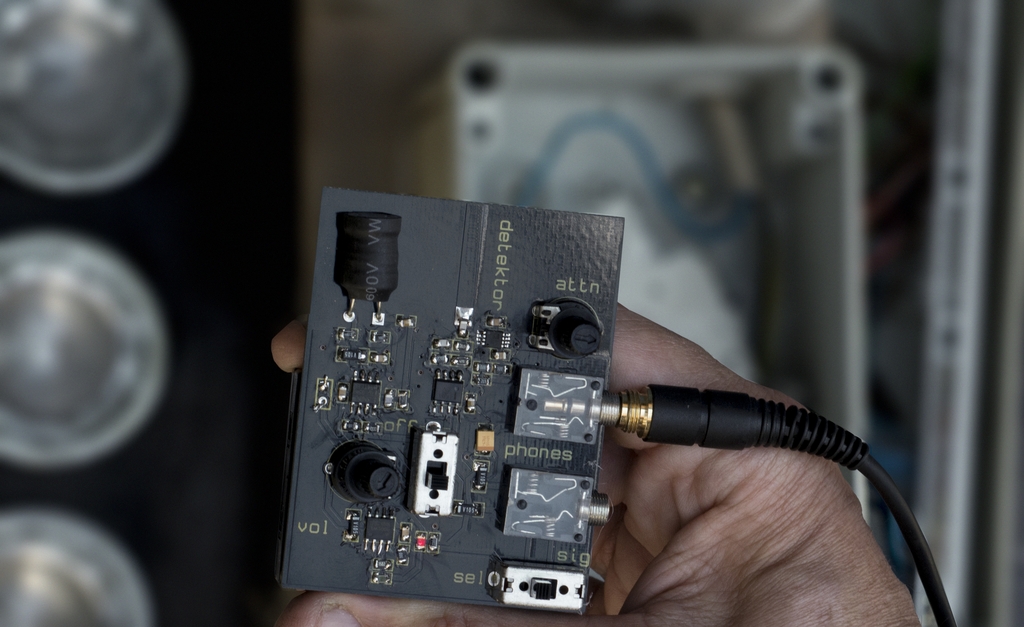
This is demonstrated with a more literal process of mapping, or the cartography of a space in Jenny Pickett and Julien Ottavi’s Flow, Swallow, Blow (2015) which combines antennas and transmitters within the space of the gallery.42 The reception of natural radio is algorithmically interrupted by the broadcast of field recordings close by. Audiences can listen to the antenna by touching specially created devices to the antenna. There is a process of writing about the space, through the creation of field recordings, and exploring the local.
These works seem to be mapping the commons, pushing back against the prescribed bounds of the network, whether through technical protocols or legal restrictions.
Similar in form to Pickett and Ottavi’s work, Joyce Hinterding’s Large Square Logarithmic VLF Loop Antenna (2015) fixes the antenna to the gallery wall. The antenna in this work is applied to the wall as a graphite line. The antenna performs as a diagram and the thing being diagrammed. An audio cable is attached to the ends of the antenna which runs through an amplifier to headphones. Audiences are encouraged to touch the lines of the antenna, which changes the tone of the sound. Hinterding’s website copy suggests that the focus of the work is the exploration of this phonomenon of scavenging energy, through the unpowered antenna within the the close proximity of the gallery (where it might also interact with other works, transmitting and receiving): “a spiral of graphite becomes a resonating structure that emanates energy, scavenging, storing and – when amplified – making audible and ‘playable’ the atmospheric forces in the room.” (Hinterding) This example, perhaps more so than the previous one cited, is at play with the context of the gallery. Thinking about the literally drawn antenna, it could be interesting to consider the antenna as potentially a kind of epnoymous signing - N. Ludd, instead determined by the conductive spiral. The psuedo-anonymity of Luddism performed through these repeated actions.
Peering
In the field of computation, and the communities of open software and open hardware enthusiasts, the how-to guide has taken on a particular form- proliferating in online forums, videos and blogs. Artist and researcher Jennifer Gabrys explores this through her book How to Do Things With Sensors (2019), which functions both as a practical guide to DIY engagement with computing and sensing as well as an exploration of how such guides and toolkits can build new social-political worlds. Gabrys states that “the how-to is a proposition for open technology, which, as Gilbert Simondon suggests, can be a way to engage with machines beyond fixed outcomes as well as an opening into alternative configurations of humans, nonhumans, and relations.” (Gabrys 2019, p.9)43.
Roel Roscam-Abbing and Dennis De Bel, riffing on the well known computer manual publisher O’Reilly, published the zine, Oh’Really?’s ‘A Thing Or Two About Messing Around With Packet Radio’ (2015). O’Reilly publications generally claim to promote a ‘best practice’ approach to emergining technologies, and to make “it easier for our customers to develop the expertise they need to get ahead.” (O’Reilly 2023) Roscam-Abbing and De Bel are creating something much looser and playful with their zine which details a step-by-step guide for experimenting with packet radio using cheap devices. It is interesting to note that in the introduction to the zine, they frame it as being from a “non-engineering” perspective, as well as a “non-amateur” perspective. (Roscam-Abbing, De Bel, 2015). This points to the commonality of the project, that aims not to foreclose inclusion.
The technology described in the zine, packet-radio, has additional complexities to the VLF, micro-fm and HF projects referred to already. It was developed in the 1970s and makes digital communication over radio possible. For Roscam-Abbing and De Bell the importance in exploring this is that:
It shows that ‘there is more than one way to do it’ when it comes to building computer networks, underlining the plurality of possible internets. Although slow, packet radio systems can establish links over very large distances whilst relying on autonomous infrastructures. That makes the technique an interesting proposition for building autonomous and resilient networks. (Roscam-Abbing, De Bel 2015)
Through this re-purposing of the established how-to form, Roscam-Abbing and De Bel are particpiating in the form whilst creating a different possible outcome. It isn’t going to create productive engineers or good consumer amateurs (hobbyists), but something wonkier, open to negotiation and responsive to the people who decide to build it.
Actively Ludd
Whilst all of these practices do appear sympathetic to some of the Luddite strategies explored here to different extents, it would take a further transformation or signing for them to be understood directly as Luddite. This could be in the shared eponym of Ned Ludd, perhaps translated into an antenna design - and replicable across the devices.
Luddism it seems, would require a declaration and the coalescing of different strategies, emerging in different contexts across which the powers of capital might lose their focus.
If I turn this question on my own explicit Luddite archaeology explored here, there is also a danger that it falls short of the luddite claim. In the next section I describe a walk - which was made under a banner proclaiming the reader should ‘Ludd today.’ This document exists as an academic submission, but with as much distance to the norm perhaps, as the Luddite imitations of legalese and charters. The archaeology in its process reveals tensions and transmissions of power, embedded within technology and the artists’ use of technology - but to perform as Luddite it is necessary to articulate a resistance within that.
It is worth now considering how these practices can be articulated as engagments with hobbyist computation. Investigating Kogawa’s Simplest FM Transmitter schematics, I soon discovered that the components are available, like the copper wire, in a form that expects further processing or transformation. Some must be purchased as a packet of 100. These are fairly standard components that might reasonably be expected to be part of a well-stocked hackspace or lab. The radios utilised by Roscam-Abbing and De Bel are popular entry-level hobby devices, and the devices assembled by Howse and Miyazaki exist as a product that would not be out of place in a hobbyist toolbox. They are made possible therefore through the existence of the hobbyist market.
Amplification
How To (3)
Operate the antenna safely. Don’t go out in a storm. Be careful with the volume and kind to your ears. Be aware of your surroundings, if you are listening through headphones, as you will be listening to the space around you, but not necessarily the occupiers of that space that can interact with you unmediated.
The signal received by the antenna will be quiet.
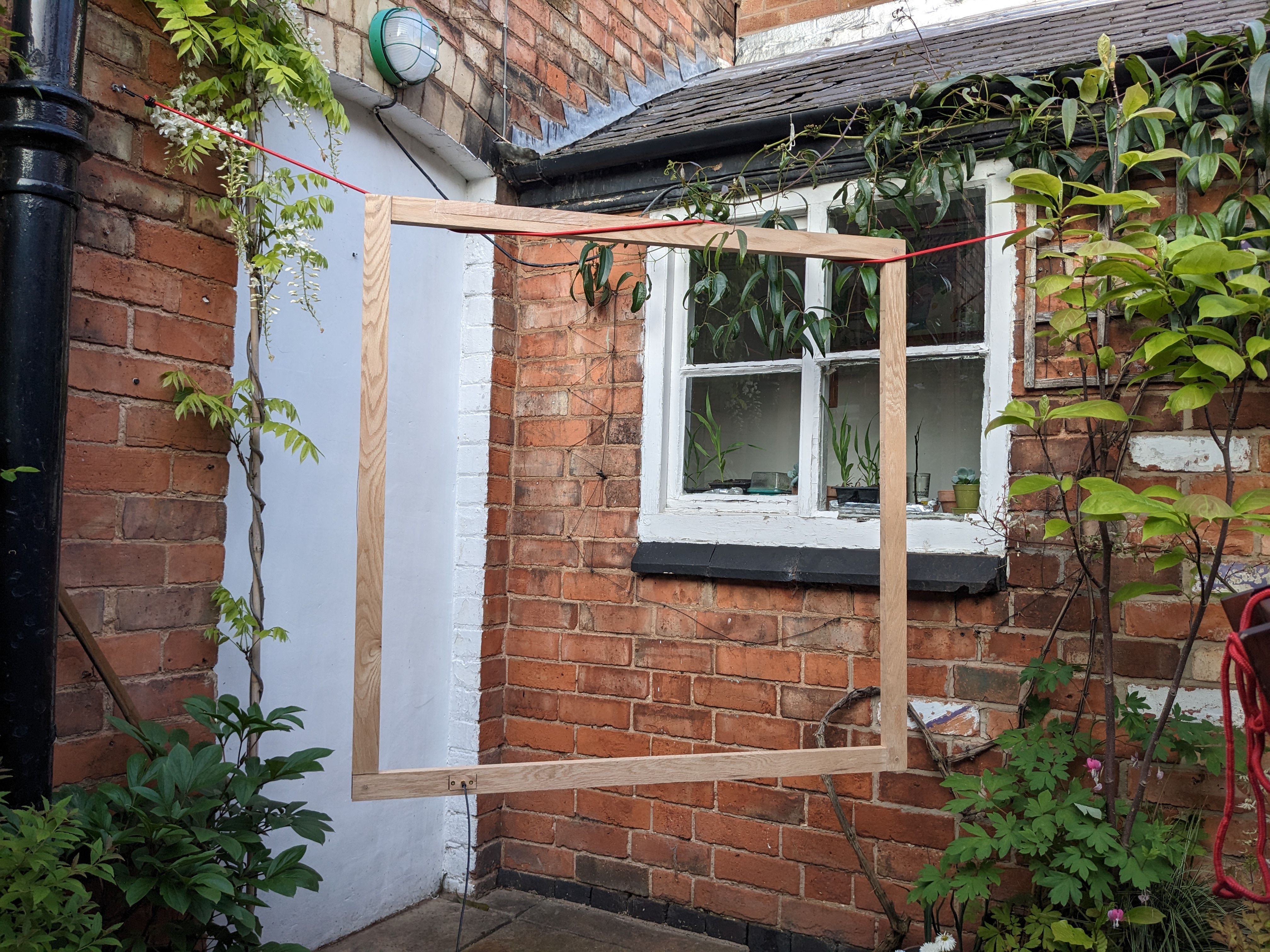
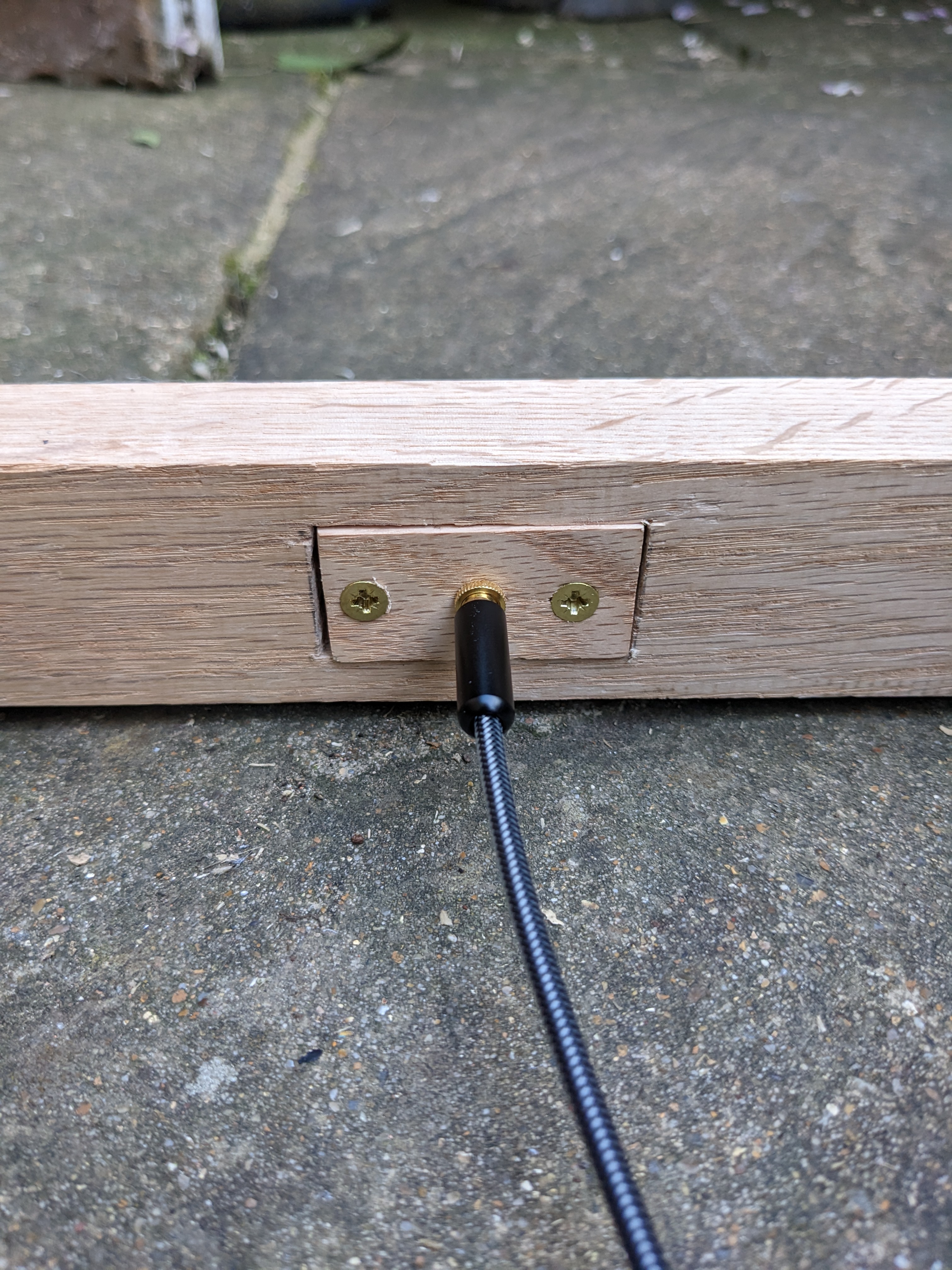
A simple amplifying circuit can be built, or an existing amplifier can be used. For listening with a small group of people I have used a small guitar amplifier. If I’m alone, can share headphones or am recording I usually use a small portable recorder (the entry-level Tascam DR-07x). These recorders usually have a line input which we can use to connect directly to the antenna, via the audio jack. The recorder will provide clean amplification of the signal. Most will allow you to listen through a pair of headphones and record simultaneously.
To hear the sound of lightning and other atmospheric events, it is easier if you are able to move the antenna away from other electromagnetic sources, such as power lines, cars and computers.
Before finding a remote field away from likely ‘unnatural’ sounds listen to the space in which you live. If you walk around with the antenna you will hear the sound changing - likely the persistent hum of the mains power, which changes thickness probably without visible logic.
A touchscreen device, touched near the antenna can be heard as a shuffling step.
A wifi router or TV might pulse into the spaces.
A diagram of invisible activity can be mapped.
Tilt and rotate the antenna and notice the shape of the sounds changing.
If you hold a wristwatch near the antenna you should be able to find places where the ticking of the seconds are audible.
Lightning propogates via groundwave. This means that to receive it through our antenna, it should be placed or held at 90 degrees to the ground. It is directional as well. This means that you can try to point the antenna at a known lightning source or identify where received sferics are originating from.
If you are recording, the file can later be examined using software such as Audacity, which allow a spectrogram view of the audio file. This rendering of the recording makes it easier to identify the presence of sferics and other signals. We can also use this to view signals that are received but that would not be audible without further processing or transformation.
Some examples of the spectrograms are shown below.
![Spectrogram view of recording [0173] with statics marked by red arrows. figure49](images/f49.jpg)
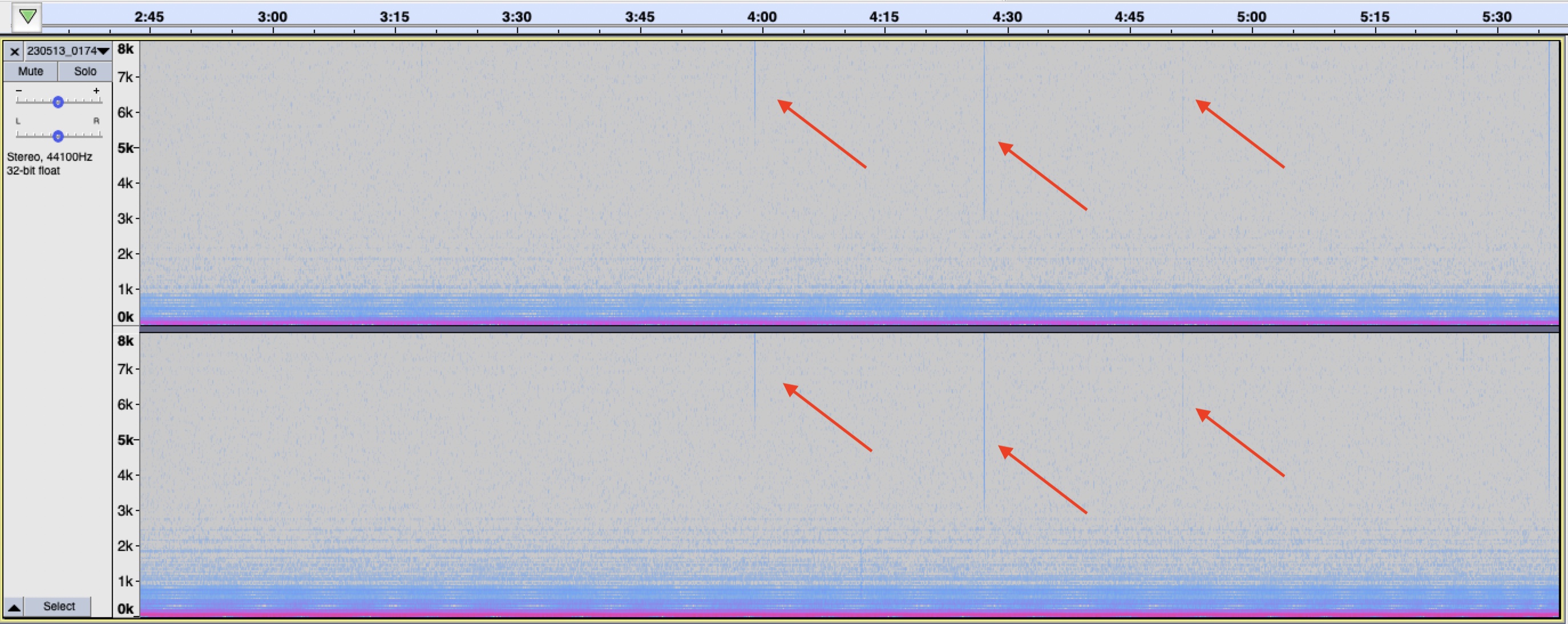
Some annotated recordings are also appended.
In defining the practice of Deep Listening, Oliveros writes that it is,
listening in as many ways as possible, to everything that can possibly be heard, all the time. Deep Listening is exploring the relationships among any and all sounds, whether natural or technologicial, intended or unintended, real, remembered or imaginary. Thought is included. (Oliveros, 2022)
This definition is similar to the notion of archaeology I have been following here, in trying to recognise the possibilities of what can be said/heard at a certain time. In this final section I include an account of a ‘Ludd walk’ which returns to a more traditional concept of archaeology - or at least a return to the physicallity of excavations and erosion.
Echoes
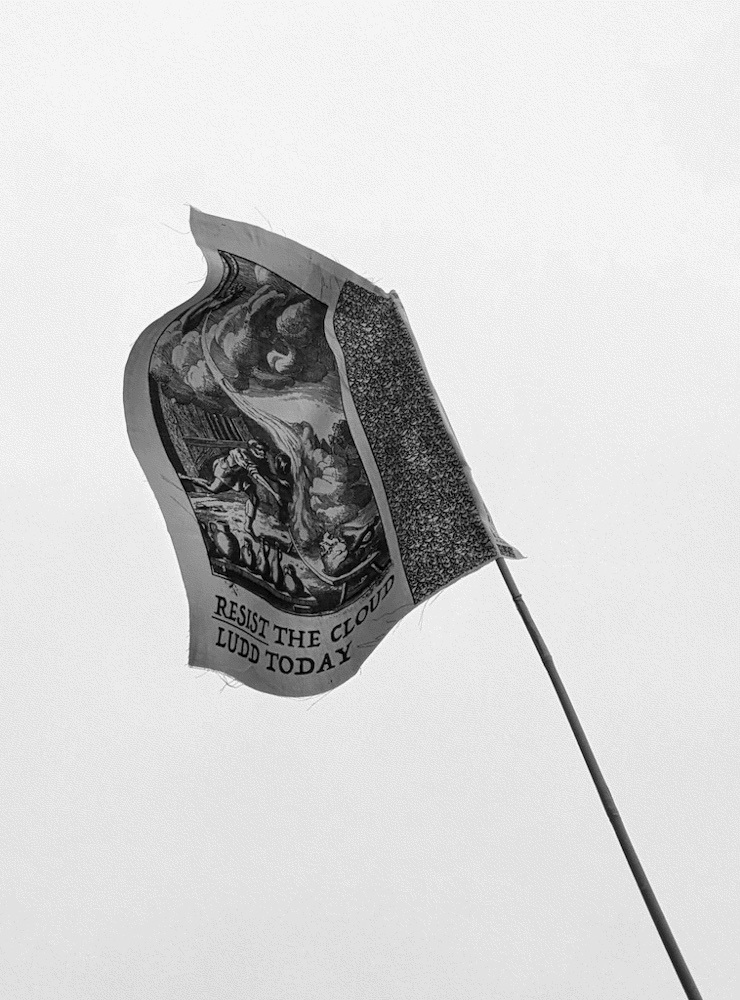
In the assembly of a Luddite archaeology an understanding of the local in relation to the focus of the study is of obvious importance. The Luddites were responding directly to local and immediate concerns, supported by a network that reached beyond the local horizons, and capable of stretching to the range of actions taken under the Luddite banner.
This Ludd walk was publicised with general information about the day of actions organised under the banner of the International Trans★Feminist Digital Depletion Strike or the Counter Cloud strike day.44
I had asked folks to email me to confirm their attendance and was expecting a group of about 10 on the day. The day turned out to be very cold and snowy though, so we ended up with 5. Some of these had travelled from other parts of the country, bringing in other Luddite histories.
The route began at artist-led studios and gallery, Two Queens. The walk had been promoted through their networks and there was general interest in the aims of a Counter Cloud strike. Two Queens is based in an old factory space, that was at some points during its history used for garment manufacturing. The neighbours include a print workshop and an active textile factory.
Heading into the city we discussed the continued importance of the textiles industry within the city today, and how the terrible conditions reported on and in many aspects accepted (by the city, and by consumers generally) relate directly to the protests the luddites made.
I attempted to provoke our thinking and discussion by suggesting that we focus on three distinct time periods.
The now; the technological present, that we are living in. It’s the electromagnetic activity, busy around us, and the buildings and the people we were to see. It’s our work and the way we are worked.
The historical window of the Luddites and the series of protests, sabotage and machine-breaking that had their beginnings in the midlands, and end in Leicester, between 1811 and 1817.
The third time I referred to was the mythical time, of Ned Ludd himself. I referenced the story that around 1779…
being averse to confinement or work, he refused to exert himself, whereupon his master complained to a magistrate, who ordered a whipping. Ned in answer took a hammer and demolished the hated frame. (Hammond, 1919)
Our walk was to end at the churchyard where ‘Ned’ was buried in a paupers grave and a different name. I suggested we think about how we use these stories. What does it mean to share these myths? And how do we shape this into something that can help us today?
The city still resembles in many ways the city that would have been familiar to the Luddites. We passed by the Guildhall and the remains of the old Gaol. Some of my notes I’d made to talk about different locations were drawn from a guidebook to the city written around the time of the Luddites by abolitionist Susanna Watts (1804).
We crossed the market square, towards the cathedral and Richard III. Around the corner is the Guildhall. This is one of the oldest surviving buildings in the city, and would have been active as the location of city council meetings during the early 1800s. So it was notable here as the place where political decisions were being made.
From here we crossed the square towards the High Cross. The buildings here are mostly more recent now and the city ring road cuts a tearing wound through the older streets. But here and there pieces have remained. The County Gaol where the last of the Luddites were imprisoned before execution has one corner wall still visible, sandwiched between newer brickwork. A plaque featuring another Leicester celebrity Daniel Lambert draws attention to it. Lambert was a jailer here for a time. Watts’ guidebook provides a description of the Gaol which can fill in the missing edifice (1804):
Some paces lower the massy stone front of an edifice adorned with rusticated pillars points to the eye the County Goal, erected in the year 1791, at the expense of six thousand pounds. The spectator may prehaps be led into a reflection on the violation of propriety, when he sees the Roman Fasces and Pileus encircled by heavy chains decorating an English prison. Under these symbols the name of the Architect is fully conspicuous, and it may be observed as an example of sudden vicissitude, that the builder of this fabrick became, as a debtor, its first inhabitant. (Watts, 1804)
There is some competition for the hobbyist tour-guide as the info panels, that depicted Lambert, pop up on almost every street in the city, and continue to appear as we move further out. A city tells itself a story. The panels are like physical footnotes, asides pointing to a different reality that may not be visible at all any more.
We leave the old streets and pass glimmering facades of recently built hotels and offices, and the bowling alley that occupies the old railway station. The railway arches continue a while with the memory of line above them, pointing North, to Loughborough. In the arches the gentrification loses its will, and the same mechanics, tyre, repair and scrap merchants that have long been there remain.
Beyond this we follow the canal for a while. The railway, and the canal being the converging points of coal mined in the county being readied for barges and sent onwards. Now the place is subject to a persistent motion, a steady rumble as tens of heavy yellow vehicles scrape and push and carry earth around and houses are assembled.
It’s snowing more heavily now. We turn from the canal and pass parallel to where that morning a plaque is being unveiled marking the home of Leicester suffragette, Alice Hawkins.
We followed a park that snakes out of the city between estates. The focus now was on reaching our destination.
A couple of times other walkers passed us and asked what we were doing. The small flag I carried seemingly acting as an invitation to discussion. And each time they were interested and perhaps amused by our trudging through the snow – our performative attempt to escape the cloud, blanketed by another.
Again thinking about the industrial routes into and out of the city, we made a parallel with the mile-long tunnel that for a time was the longest steam railway tunnel in the world, its dark trace visible now to those who know, in the brick air vents that are visible here at the end of a cul-de-sac and then as we cross a roundabout, poking from a grass verge. On our right is a large cemetery and to our left a hospital. The pavement begins to falter in places and we cross the road multiple times, back and forth, seeking a pedestrian route.
We discussed our individual interests in the Luddites, and the different traces they’d left in other cities.
We discuss the strategies we’ve taken today in hoping to avoid the cloud, and the preparation that has entailed.
The expectation was that the walk would perform some kind of archaeology. The definition of archaeology that Foucault provides and Mackenzie summarises as:
A description that explores the production of statements at the level of knowledge practices (savoir). It emphasizes the irregularities and discontinuities in knowledge practices as well as the derivations of operations and functions. (Mackenzie, 2017)
In performing the walk we have generated a space for an irregular constellation to appear for a moment, and to act against the normality of the city. In some ways it operates like the ritual beating of the bounds and the collective map making that emerges from that. This acting-out surfaces questions about the framing of this history. Parallel to this, is the quiet muddy archaeology performed by our walking, and the small acts of erosion and excavation. Simply by walking this route we carve towards the past.
We pause for photos at Ned Ludd’s Close. This is a small cul-de-sac just beyond the small brook that runs through the village. The old footbridge, that would already have been old by Ned’s time is visible.
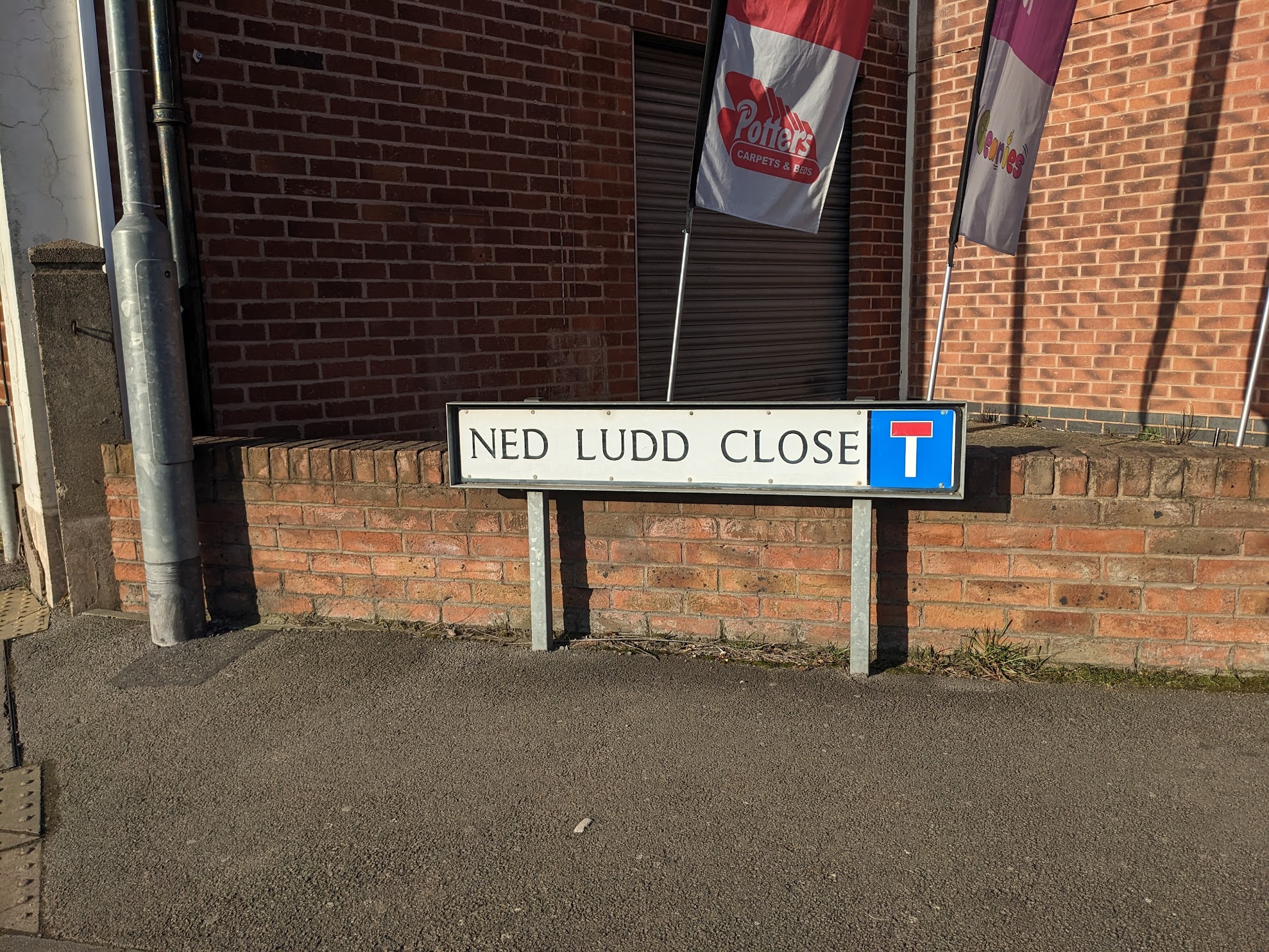
And then we reach the churchyard. Parish records list Edward Ludlam as being buried there in a paupers grave and therefore not marked by any stone. The stones that are present span contemporaries of Ludlam, and the Luddites, and many listed are the framework knitters cited in other records. We stand around quietly for a few minutes - the walk seemingly not fully resolved for not having found Ned.
Exhausted and cold we tap on to the bus and return to the city.
Our strange resistance of big tech, and remembering of previous struggles in synchronicity with other groups and organisations seems to amplify strangeness.
Samuel Delany and Ursula Le Guin figure as part of the conversation, shared stories and the experience of reading these worlds. There is an interplay in the texts, particularly in Delany’s explicit referencing of Le Guin or responding to her works, with his own (as in The Dispossessed (Le Guin, 1974) and Triton (Delany, 1976)). The importance of SF and Delany in this research figured earlier the section referencing Tierney’s research, Luddite Echoes. The city is something that Delany returns to repeatedly. David Graeber and David Wengrow traced a history of the city from about 6000BC (Graeber, Wengrow 2022), but perhaps, like the hobbyist and the Luddite, it is something that has a particular formulation that is only possible with the industrial revolution. There is always the same grey cloud pinned in the sky.
Delany’s Neveryon (1979-series seems to deal specifically with this experience, and has several characters who wander the pages much like we have made our way to the churchyard; picking up stories, piecing histories together. For Delany, there is an important change possible in the transmission and relay of stories, the beginning, the reflection and the interpretation of the reflection. There is an imperative in telling stories. This can be recognised too in the use of the antenna - a crude/brittle reception of information, transformed to a register we can sense (visual waveforms, spectrograms, audible streams).
This thread of the local might also be pulled through a closer understanding of the context of our referenced guide book. In researching the walk I referred to the guide book written by Watts who was a contemporary of the Luddites. In exploring Watts’ documents archived in the Leicester Record office I could only find one explicit reference to the Luddites as part of a poem titled Old Leicestershire, saved as a clipping from a publication. The poem is dismissive of the use of violence by the Nottingham and Yorkshire Luddites, admonishing, “return to your duty, leave cutting of throats and stick to your loom or we all shall want coats.” However, Watts was very active in the organisation of campaigns to abolish slavery, along with fellow Leicester resident Susannah Heyrick. They published pamphlets, organised marches and encouraged the refusal of the use of products created by slave labour. Watts wrote that “Petitioners deeply deplore the existence of British colonial slavery, as a condition of society full of wickedness and cruelty”. (Watts, 1834) Their activism also campaigned against animal cruelty and corporal punishment. Heyrick, whose father had been targeted during machine-breaking riots in 1785, is recorded as more actively advocating for the rights of the textiles workers, specifically her 1825 pamphlet. As Claire Midgley writes, this
advocacy of British labourers’ rights at the same time as her advocacy of the rights of slaves, and her willingness to draw analogies between the sufferings of the two, represent a radical positioning for a middle-class woman, one that provided a potential political bridge with working-class activists hostile to slavery but suspicious of what they saw as the hypocrisy of middle-class abolitionists who wished to extend rights to slaves but not to workers. (Midgley, 2007)
There are countless other legacies entangled and woven into the history of this place. The Luddite fixes us to a moment and allows us to think through specific events and mythologies.
The Loughborough Job
The second walk, in October 2023, provided a welcome event around which to explore further the walk as a form of reflexive tool and practice.
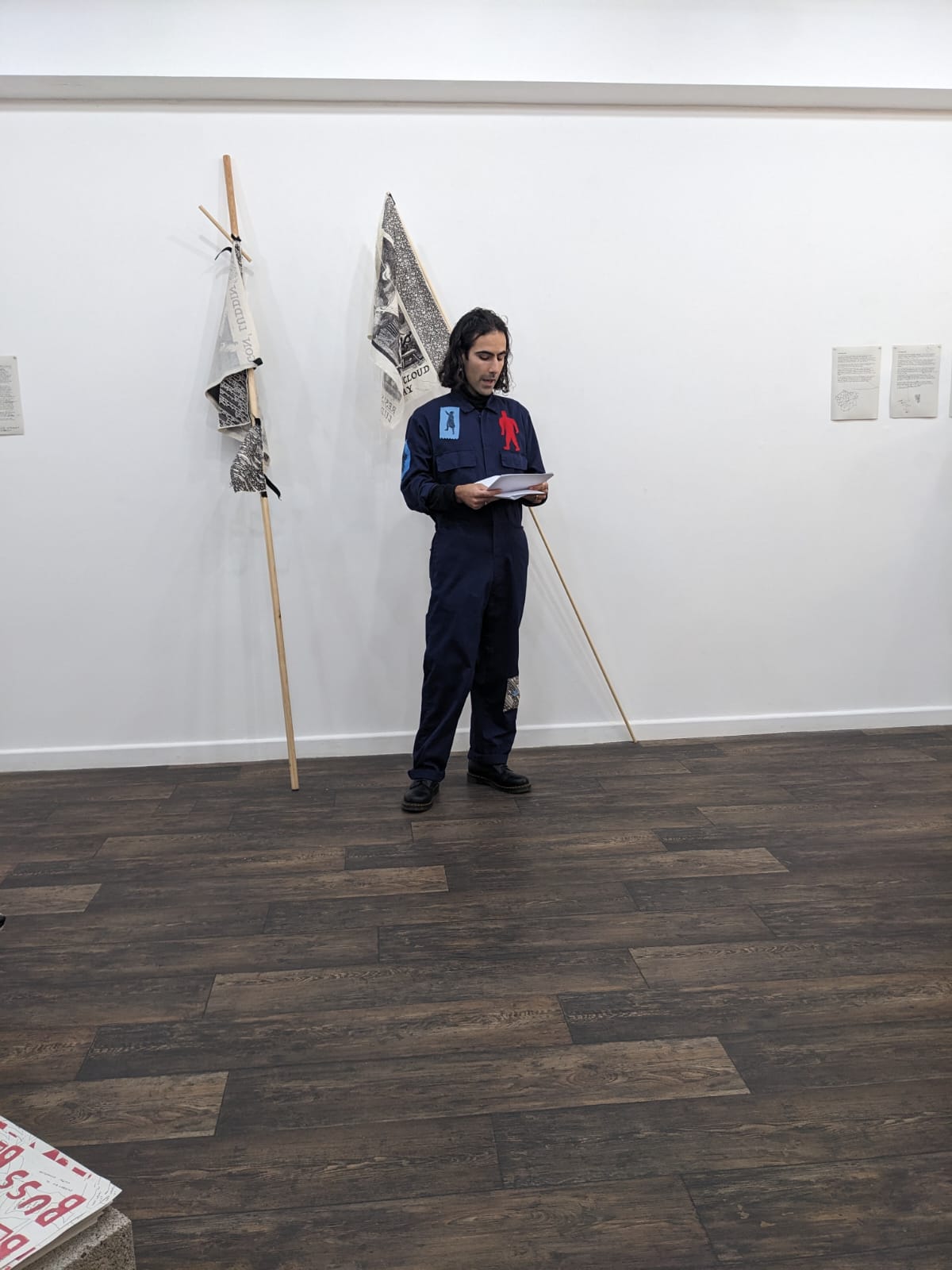
This walk was a celebration at the closing of an exhibition of my work at Modern Painters, New Decorators gallery in Loughborough. This is a small artist-led gallery and studio space situated within a shopping centre. The works I had created for the exhibition mostly reflected upon the history of the Luddites within Loughborough, connected to an exploration of fiction and a history of computation.45 I delivered a talk related to the exhibition and the idea of artist networks which is also linked in the appendix.
The exhibition had been advertised with an image of me operating one of the antennas, although we didn’t eventually exhibit the antenna. The antenna holder was re-purposed during the closing walk as a flag pole.
Instead of relating the route of the walk as before I will try to reflect more upon the effect these actions appear to perform in the moment and subsequently. Some details are useful for context.
The Loughborough Job was a raid on Heathcoat and Boden’s factory in 1816. I mentioned it at the beginning of the Luddite Echoes section. Quite detailed accounts of the raid exist in the newspaper reports documenting the trial of the Luddites. (Nottingham Review, 1817) This allowed me to suggest a route through the town that visited locations mentioned and still existing and threaded through the town, winding back and forth, mimicking the days leading up to the raid.
Over 20 people took part in the walk, including a mix of folks who regularly participated in the gallery events, several local historians46, and others who had simply been looking for something to do.
On a weekend of mass protest globally it felt strange to be performing the walk without actively protesting. Afterwards, in the pub we watched another group pass by along the same route carrying Palestinian flags. Our own procession was however interpreted by others as a protest. Several participants were approached by other members of the public who asked what we were protesting or simply vocalised approval of our protest and wished us well. We formed a large enough group that we could command traffic to stop as we crossed the road. I was wearing a vague costume and carried a flag. The flag from the first Ludd walk, I invited the participants to carry and they shared the duty, passing it around as we made the route. I was aware of the tension here, of how much the walk could be pushed toward a more activist agenda. This was perhaps expected by the participants joining through their familiarity with the gallery, and maybe less so by the others.
Our discussions again bounced between the timeframes of the Luddites, Ned Ludd and the present day, now filled out with more connective tissues - the progression of the textile industry through the different buildings and factories present in Loughborough today. With several historians willing to correct the histories I was suggesting or add details to things I’d missed or excluded, I was able to voice more direct questions about technology and the possibilities of a Luddite approach.
The Loughborough Job is a messy example from which it is difficult to draw an easy Luddite parable. The participants were from Nottingham and acting as Ned’s-for-hire. It’s alleged that some of the workers from the factory followed Heathcoat when he moved his business to Devon. But there was an understood dissatisfaction with the conditions at the factory. The owners had increased the number of gaurds on duty each night.
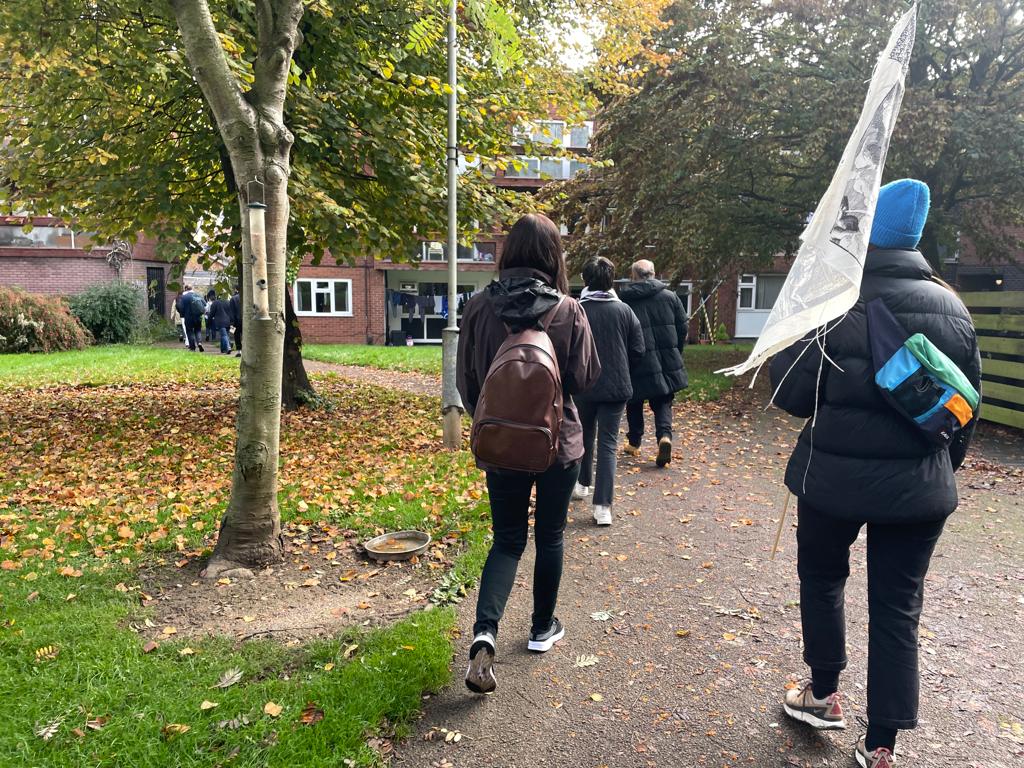
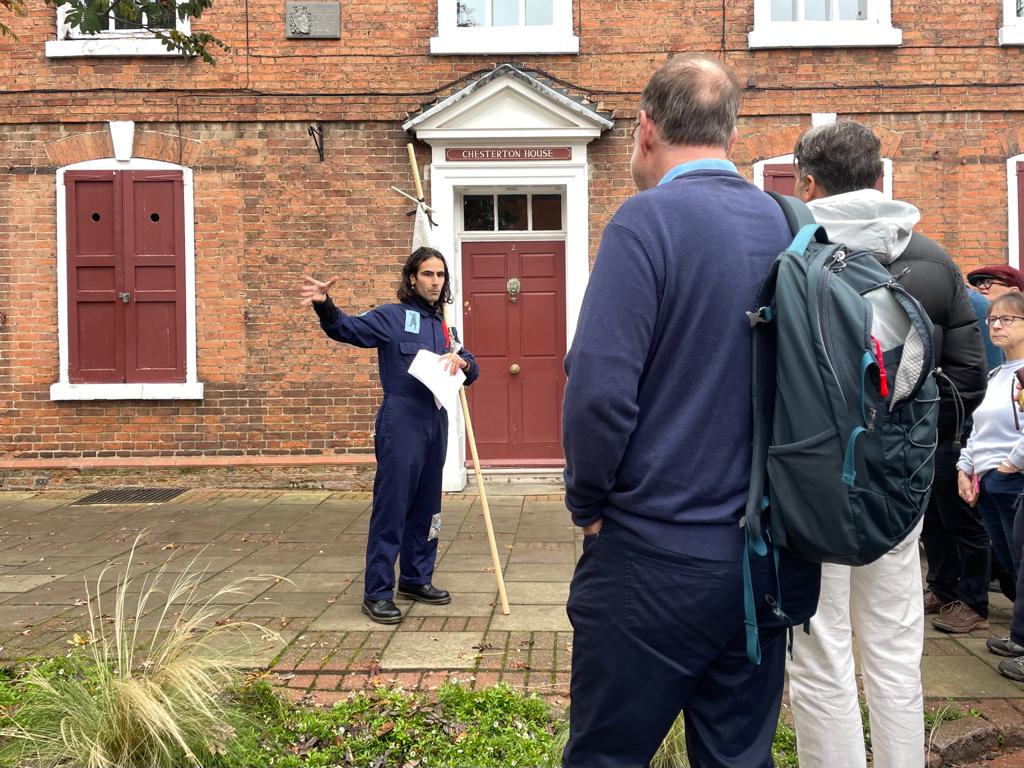
The proximity of this performance or activity to that suggested by the Situationists’ derivé is useful to note. One of the participants who lived in the town, commented on their fascination with the way our route had woven itself largely through the zones of housing bordered by or inhabiting the factory buildings with which we were mostly navigating by. These were paths along which these citizens of the town had never walked or known about. It feels directly in this way like a disruptive, Luddite manouvre. It animates a commonality through its duration. Similar to the practice of listening with the antenna, in participating we switch off from expected networks and tune in to other frequencies - that require an actively imagined processing and identification i.e. the sound of lightning or the survival of the houses of Heathcoat and Boden. For sound artist Westerkamp (referenced in the Practices section) walking and listening is actively explored through the practice of soundwalks.
From Westerkamp’s instructions for Soundwalking (reproduced by Andra McCartney, 2013):
What else do you hear?
Other people
Nature sounds
Mechanical sounds Howmany Continuoussoundscontinuoussoundscontinuoussoundscontinuoussoundscontinuoussounds Can you detect Interesting rhythms
Regular beats The highest The lowest pitch.
The walk is able to exist in a loose and playful manner, which adds to the expectancy that it might be provoking things beyond our immediate party. This is revealed by those who come up and talk to us and also those we find out later had noticed our passing. One instance of this is the landlord and a few patrons of the pub to which we ventured after concluding the walk. We had passed by earlier, standing for a while on the street outside, and discussing its place in the story of the Loughborough Job; one of the many pubs in which the group met and planned and shared mutton chops, ale and rum. This history was unknown to those who spoke to us later in the pub. They asked questions about the wider reasons for the walk and added their own stories of the history of the textiles industry in the town.
The walk, like a workshop or the how-to guide is a template for actions, the potential of actions that creates a space for them to become something unexpected. It is a useful technique for drawing together an assembly of people and providing space for discussion. As I host this walk and perform these activities as an artist I feel the pressure of this hobbyist tension that I have been discussing in this research. I was asked several times why I had become interested in the Luddites. Like most of the participants, the local history was not something I was particularly aware of growing up here. My interest had followed from a dissatisfaction with my own failure to reconcile the problems I could see in computational technologies, with my use of them in the production of an arts practice. As much discussed already, Luddism provides an interesting framework for looking at this problem. Its local history opens an additional space for augmentation of this and the provocation of what a local commons could be or is. The event assembled from the pivilege of a hobbyist position. I was able to walk around the area and explore a route in preparation, without much apprehension for my own safety. I was able to choose to find less paid days of work that week - I can afford some time to wander. Much of the research and planning was conducted using ‘big tech’ infrastructure, mapping and computation. In the simple hobbyist sense of an activity that goes nowhere, our circuitous amble did that. The challenge that Luddism suggests is to make it do more than that.
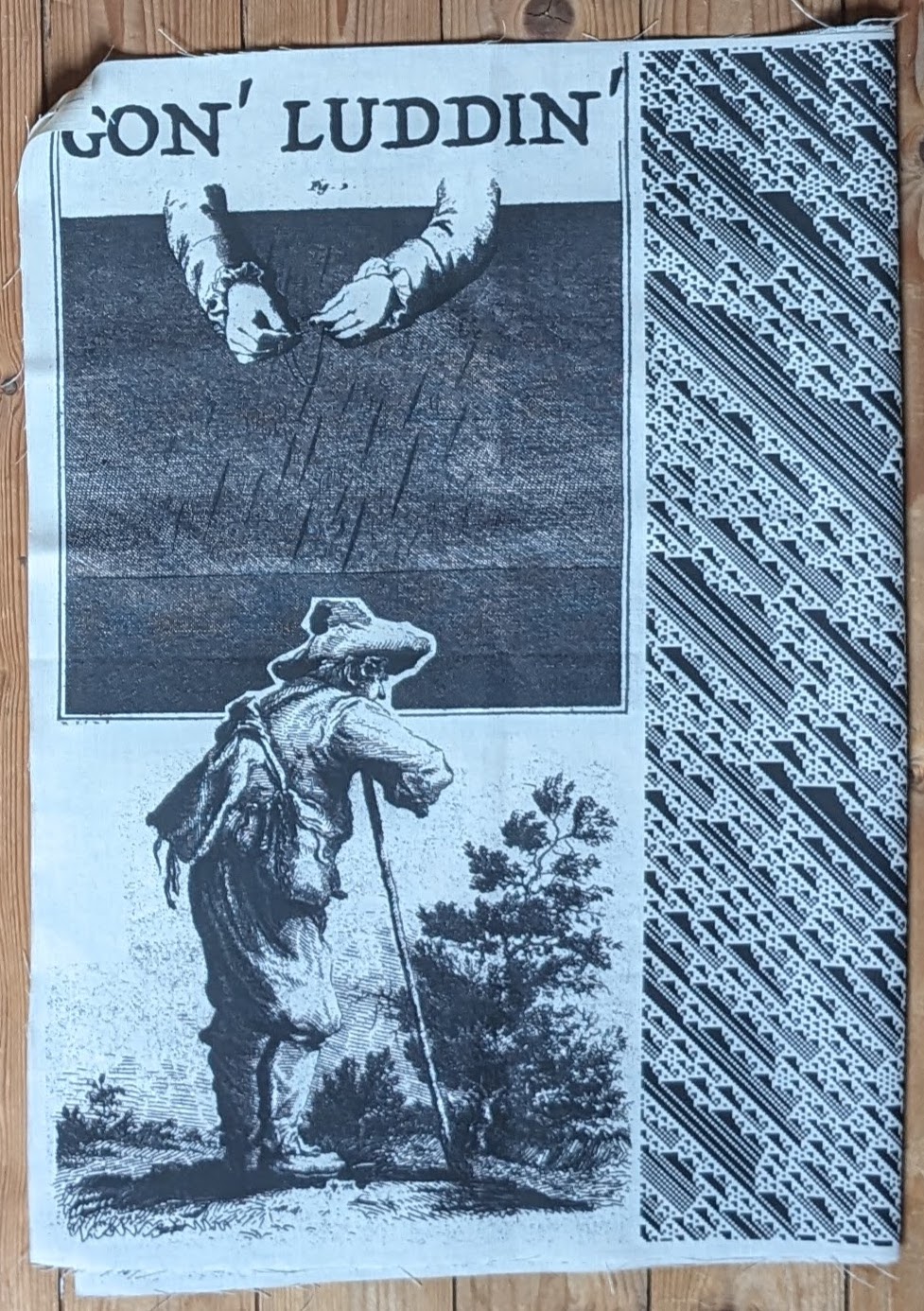

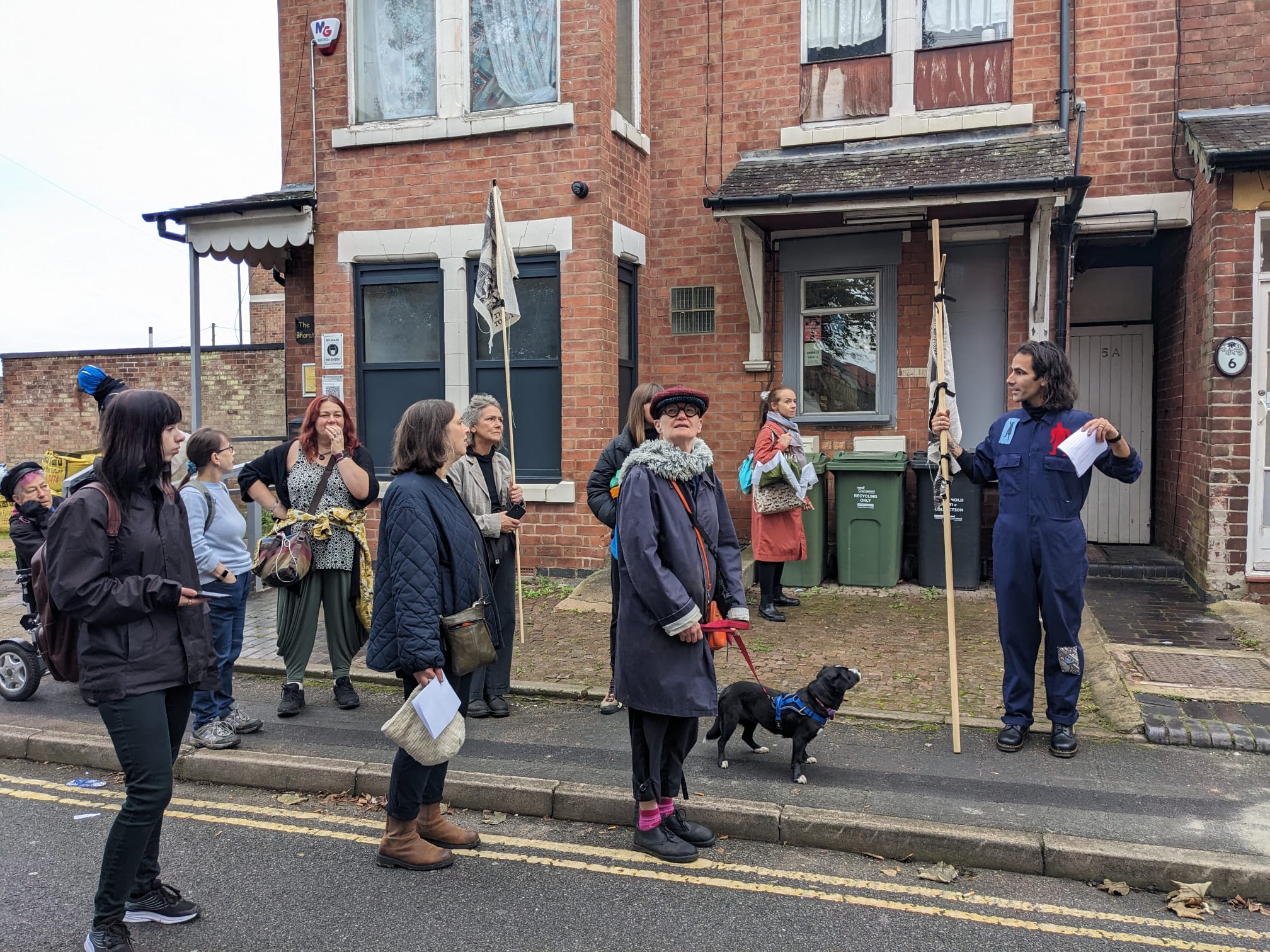
QSB (Are my signals fading?)
Tracing a path through these different texts and bodies of investigation some context and instruction for the research to follow has been constructed.
The Luddites as a historical entity utilised forms of protest not entirely distinct from others during that time. The resistance against industrialisation was widespread and sustained. It represented a loss of the commons, and an inversion of values for the general population. “Commoning has always been local. It depends on custom, memory, and oral transmission for the maintenance of its norms rather than law, police, and media.” (Linebaugh, 2014)
Applying a Luddite methodology to the material media archaeology of hobbyist computation requires the identification of technologies that are responsive to our investigation. They might break or be reformed differently as a result. In this research the antenna has provided avenues for Luddite investigation through its operation, the context of this operation and its construction. As we have seen, they are technically simple to construct. Their limited construction allows for a clearer inventory of the components, and for investigating the systems a practitioner participates in through their acquiring. I have focussed here on the wire itself, as the component contingent between building techniques. We have seen the global routes by which this wire is accessible to a hobbyist. And yet, even this reduced form is folded within a process of other material chains, uninvestigated here (the amplifier, recorders etc.).
This complexity that is inherent in technology, particularly in the scaling up of a technology necessarily changes the possibilities of the hobbyist. An increase in complexity in itself doesn’t necessitate a transition of terms from hobbyist to professional engineer or programmer for example - but it does bring to bear other contingences of time, resources and knowledge. The availability of these contingencies means that the path of the hobbyist is not open to all. In this small guide here, my intention has been to lay out something like a minimal viable system, that can be built, dismantled, twisted according to need. The minimum it must do is provide instructions around which people can gather and communicate. It is a kind of proto hello-world47 of radio listening. As I have shown, the practice of a hobby is also antithetical to capitalist production as it undoes the division of labour and works to position itself joyfully across multiple elements.
Marxist economist Harry Braverman suggests that the methodical breakdown of production into discrete parts can be seen as an essential marker of capitalism. (Braverman, 1974) Hobbies (particularly radio and computational) facilitate collections of knowledge across disciplines and often a repairing of the gaps that have been made. Examining this from a Luddite methodology as we have done here plays with the disassembly and reassembly of these tools, processes and social relationships.
Salvage
I have hinted at the proximity of the hobbyist to practices of recycling and salvage. Exploring this certainly opens up possibilities for effective degrowth strategies. It also carries with it an inherent potential for the repair of the commons, and the refiguring of our surroundings. There is an entire genre of Youtube video which is predominantly workers from the global south demonstrating and sharing techniques for stripping copper from discarded components. Motors often contain long windings, which, through quite labour intensive processes can be extracted and reprocessed. A VLF antenna and listening apparatus as described above is likely possible to be assembled by any reader encountering it through the university without buying anything new.
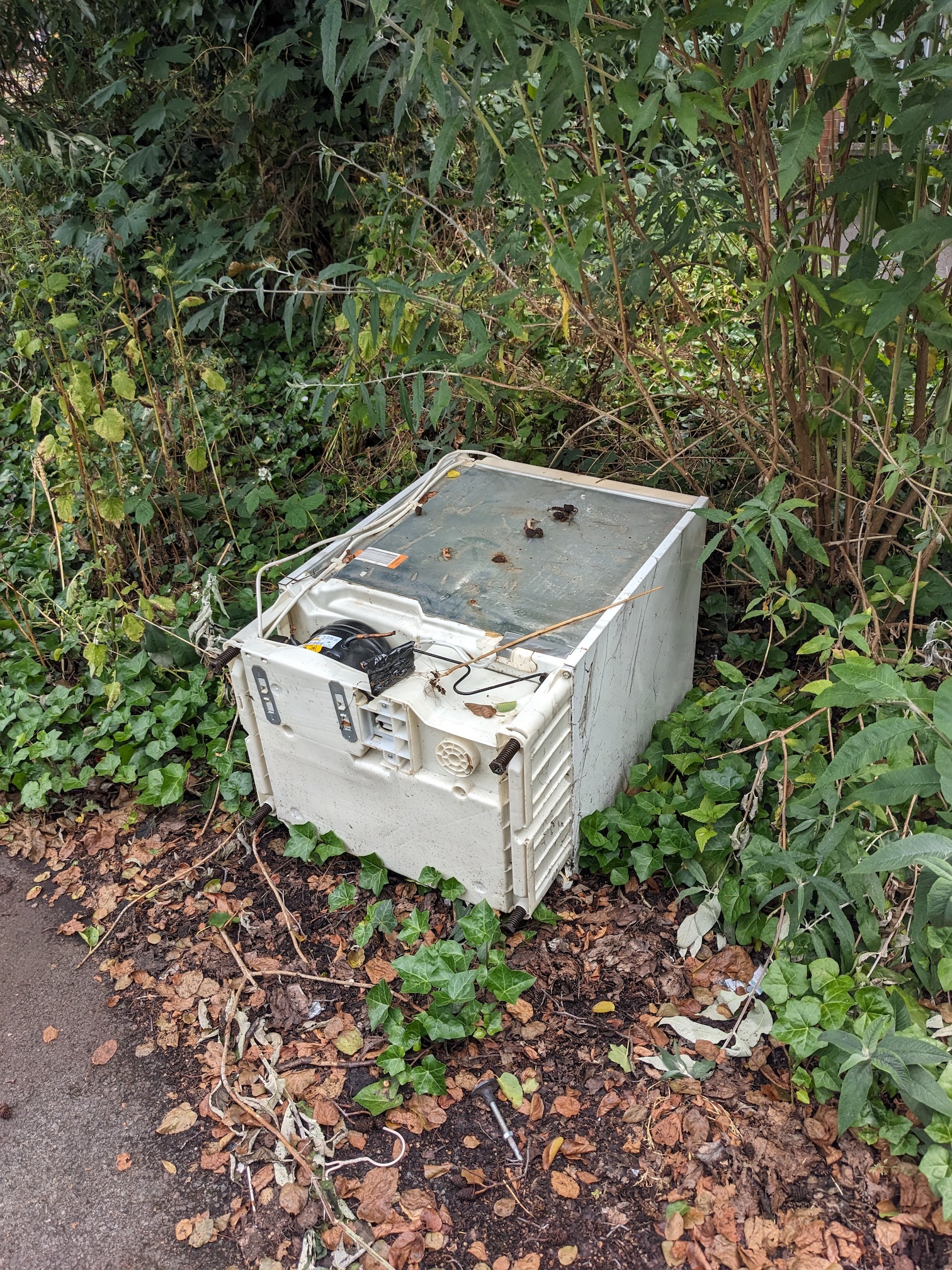
Following the instructions listed here will likely result in a device that does something. It might not be entirely clear what is being signalled. But it does form the steps for repeating a specific ritual. It provides a sequence that builds a framework for a performance that exists across a duration of time.
In my own performance of this I have taken an excessive amount of time. Each stage has been drawn out into multiple sessions. The construction itself seems to aim at craftsperson objectness - the use of wood cut specially for the frame and joined using a carpentry technique. Yet, it doesn’t pass as a craft object. The finish is too rough and the joins are slightly out of alignment. There is a large scar along the top of the frame where I slipped with one of the tools. It seems to struggle to vanish into toolness. It remains an object on the edge of categorisation, determinedly convivial, committed to a making strange.
Voices swim in murky darkness. The air is thick and viscous. Transmissions appear out of thunder and drone. A bubbling, gargling mumble. Electrical things move through this darkness. Something like whale song. There is a sense of things moving along other scales. Romero shows how the observation of a spectrogram covering a timespan of hours, reveals peaks and troughs imperceptible in realtime listening. (see: Schumann resonances, Romero, 2010)
Whilst listening to the antennas I began thinking about repeating the signal, back into the network. I wanted to replicate the experience of demonstrating the VLF antenna to a small group in a room, back into the digital networks that my practice is situated within. I configured a small Icecast server on a Raspberry Pi, which I could stream audio data to. This was accessible to anyone visiting my website and a page logged broadcasts as I made them (bruise.in/stream.html). This is perhaps not too dissimilar from the part-hobbyist network of antennas that monitor lightning strikes across the earth and collate data on websites such as blitzortung.org.
We can begin to think about a commons that is actually held in common. That can go beyond the fantasy of the digital commons - which appears to rest on the insurmountable contradictions of being military technology and able to function only through layers of exploitation which are obscured to the margins. The idea of the local and the simplicity of the VLF antenna is a way of trying to look closely, to map what is local. It includes the traces of lightning strikes that have travelled from far beyond the horizon as well as the exposed linkages of the hobbyist supply chain - the material droppings that seem to slip through. In this Luddite archaeology of the VLF antenna I have explored a wideband listening to the low frequencies of our electromagnetic habitat. The methodology has created positions of listener and the listened to.
I think it is important for artists to face these contradictions that are inherently part of a practice engaged with both technology and the processes of meaningful change, that surface when using the hobby framing. I agree with the warnings against a complete resistance to scale, which across society would likely only continue to increase the suffering and hardship of those with least power (as articulated by Heras, 2023). However, when examining this particular zone of art and hobbies, I think it represents a space for experimentation and possibilities. It remains a space of choices and decisions - to go back to Lazali’s writing, it is a space where participants can create responsibility and also, therefore the agency to care. The possibility that the hobbyist is always a tainted amateur is always there, and maybe the artist has a similar relationship with the artivist. Like the Luddite, the Hobbyist carries subversive potential under its commonly used definitions.
I work as a technician at various venues in the city and as an assistant with several artists. I’m an active member of artist-led space, Two Queens. My arts practice includes the generation of and listening to sounds as explored here, narrative texts, experimental use of digital technologies. I’ve also included references to local projects where possible.↩︎
Particularly What is Media Archaeology (2012) in which Parikka suggest media archaeology as a “a way to analyse the regimes of memory and creative practices in media culture – both theoretical and artistic.”↩︎
These scales included the deep time of geology [see: artist Martin Howse’s geological provocations, Earthcodes (2013)], the Anthropocene of the archaeological [see: Anatomy of an AI by Kate Crawford and Vladen Joler (2018). This work combines text and diagrams to map out the complex processes that construct the labor and processes involved in the Amazon Echo device.] and the moment of the forensic [see: Matthew Kirschenbaum’s media memories of Mechanisms (2008) and the demarcation of moments of the collective Forensic Architecture, as discussed in Matthew Fuller and Eyal Weizman’s Investigative Aesthetics (2021)]↩︎
Referencing Foucault, they write that, “what constitutes knowledge is necessarily open to question and to alternative forms of knowledge or nonknowledge.” (Blackwell et al. 2022) The writing of theorist Wolfgang Ernst is also important here.↩︎
“…the limits and the forms of expressibility: what is it possible to speak of?” (Foucault, 1972)↩︎
Aspects of these I’ll return to later, but for now, I am thinking about the importance of clubs and the cultivation of membership that goes alongside hobbyist specialism.↩︎
This perhaps points to a similarity which we will encounter with the discussion of radio - the emergence of hobbyist means, which are then sanitised to be folded into and regulated as part of the acceptable order of Capital. This can also be traced through in the language and methods of copyright law.↩︎
Bey described the temporary autonomous zones as “almost a poetic fancy” and something understood through action. (1991) He writes “The TAZ is like an uprising which does not engage directly with the State, a guerilla operation which liberates an area (of land, of time, of imagination) and then dissolves itself to re-form elsewhere/elsewhen, before the State can crush it.” (1991). (See also: McLaverty-Robinson, 2018)↩︎
The ZAD acronym has been used throughout France to denote land occupied by activists in order to disrupt developments. The ZAD referred to here is the ZAD de Notre-Dame-des-Landes. The Wikipedia article documents 11 ZAD sites around France. (Wikipedia, Zone to Defend)↩︎
Many of the practices referenced throughout this research use the form of the manifesto. Turinsky’s Soiled manifesto is another example of this. There is certainly a link between the manifesto and the how to guide. Both outlining steps for transformation or generation. The space between them is perhaps the algorithm - in which the how to instructions are performed to the rigidity of a manifesto.↩︎
See also Ojeda et al, (2020)↩︎
“When the web that we weave is complete, / And the shuttle exchanged for the sword, / We will fling the winding sheet / O’er the despot at our feet, / And dye it deep in the gore he has pour’d.” (Byron, 1816)↩︎
Elbit Systems are an Israeli arms manufacturer. They operate various sites and factories that have been targetted by pro-Palestine protests. The factory in Leicester is operated by a subsidary of Elbit Systems, UAV Tactical Systems. The use of unmanned aerial vehicles in military and policing represents one of the ways in which automation attempts to obfuscate harm and responsibility. (See: BBC, 2022)↩︎
The Wikipedia entry for Anonymous provides detailed information about the organisation, its history and a timeline of events. Whilst the group has apparently been less active in recent years, a new series of cyberattacks that have caused outages to part of Microsoft’s services have been claimed by a collective operating under the Anonymous name. The connection of this collective to the ‘legion’ aims of Anonymous have been widely dismissed as cover for Russian-backed attacks. (The Guardian, 2023)↩︎
See 100 Anti-Thesis, (Old Boys Network, 2019)↩︎
This is perhaps why I link to climate-related movements later. These certainly include the undoing of harms, but also an understanding of human survival on the planet, contingent on a set of parameters that can’t be crossed.↩︎
Particularly the Crip movement as described by Turinsky (mentioned in the previous section) as well as wider movements connected to the social model of disability. For example, The Art of Captioning research group led by artist Hannah Wallis and researcher Sarah Hayden, which critiques standards of access to art. (Wallis, 2023)↩︎
This Luddite slogan existed in reference to the hammers used by some of the Yorkshire Luddites to destroy shearing machines. The hammers were made in workshops owned by Enoch and James Taylor who also owned the shearing machines that were being destroyed. (Radical History Network, 2011) (See also: Stuart O. Anderson, 2008)↩︎
I return to Audre Lorde later in this research. Here Lorde was writing about focussed on anti-racism / the language is referencing slavery and the master/slave positions. The concept holds importance here in thinking about the assembly/disassembly of technologies and which tools are best to perform that critique.↩︎
Thee Ludds were a post-punk art band active in Leicester 2009-2012.↩︎
Examples of this include, the Swing Riots which followed several years later in the 1830s by agricultural workers and the Peterloo massacre of 1819.↩︎
This entanglement with legalistic discourse provides a throughline to contemporary discussions of copyright, licencing and data activism which was also undergoing important changes at this time and will be discussed further in the section on the commons. (It was the patents on the framework knitting machines that allowed this control and extraction to take place)(link to copyright text)↩︎
These writing surfaces are often complex layers of software and processes. The controlled versioning of Git. A popular tool for this is Etherpad which which opens a networked, collaborative editing space. Another example is tmux, which allows simultaneous command line editing. In both these examples the performance of the writing itself requires hesitancy, sparks confusion and rests on collaboration.↩︎
The origins of the term sabotage require mention here. They are bound to this mode of industrial resistance. A popular etymology of the word posits that French workers threw their wooden clogs (sabots) into the knitting machines to destroy them. The evidence-backed etymology is also relevant though. It was coined by anarchist Emile Pouget in reference to the practice of work slowdowns, and this being effectively like working in clogs (O’Conner, Kellerman, 2010). Labor activist Elizabeth Gurley-Flynn’s 1917 pamphlet, Sabotage gives an expanded definition of the word and its history.(Gurley-Flynn, 1917)↩︎
An urgency of this conviviality is felt through professor Andrew Dewdney’s reading of philosopher Bernard Stiegler; “recognises a new urgency in making the deep opacity of technics and what is being performed and transformed by a technical system of power intelligible, because it is the most powerful and dynamic factor in the numbing of decision making.” (Dewdney, 2021)↩︎
Sometimes this is stated as a political agenda by the author or artist, as in philosopher Yuk Hui’s attempt to “rearticulate the positions of both objects and humans in the technical system in favor of an individuation proper to humans and objects.” (Hui, 2016 p.3)↩︎
Across society this has been felt in unequal measure by the partial collapse of home and workplace (accelerated by the effects of the Covid-19 pandemic).↩︎
Fremeaux and Jordan write that “You are artists and you are working in the Capitalocene, an era marked by a system, whose obsession with limitless growth means it will always place the economy in front of life, sucking the living into its globalized circuits of capital, forever expanding and voraciously devouring more and more worlds.” (2021) This reference to the current epoch of the Capitalocene is worth mentioning as it neatly links to the wider discussion here. The Capitalocene was coined by ecologist Andreas Malm, and has since been taken up by others. Economist David F. Ruccio argues that it is distinct from the Anthropocene as, “Human beings have, of course, transformed the planet from the start of agriculture and the beginnings of class society. But it is as a result of the rise of capitalism that the most significant changes—from rising carbon dioxide levels, population growth, and consumption—have been produced.” (2011)↩︎
See also French activists CLODO, documented in Machine in Flames (Culp, Dekeyser, 2023)↩︎
This has been examined extensively in the research of James Boyle, specifically, The Public Domain: Enclosing the Commons of the Mind (2008) and The Second Enclosure Movement and the Construction of the Public Domain (2003). For Boyle there is a recognition in the need to ‘invent’ the public domain: “The explosion of information technologies has precipitated an intellectual land grab; it must also teach us about both the existence and the value of the public domain.” (2008)↩︎
Following the use of the Greek mythology to define computer malware that disguises itself from the user to produce its programmed intentions an example of such a commons could be the creative exploitation of collaboration features present in edutech software, to create shadow messaging networks between students.↩︎
As Siddharth Kara shows in Cobalt Red (2022), this is unfortunately a much more difficult assertion to make than might be expected.↩︎
For another example we can look to the experimental collective Critical Engineering, who pointedly define themselves as Critical Engineers. Their manifesto explains the range of disciplines from which they draw: 8. The Critical Engineer looks to the history of art, architecture, activism, philosophy and invention and finds exemplary works of Critical Engineering. Strategies, ideas and agendas from these disciplines will be adopted, re-purposed and deployed. (Critical Engineering, 2021)↩︎
Which are themselves inspired by the practice of utopian fiction - specifically William Morris’s News From Nowhere (1890) but also those SF dismantlings referenced already. (Delany, Le Guin, Butler)↩︎
It’s worth noting that the title here is referring to the Luddite psuedonym, but that it also happens to be the name of the first chatbot, created by Joseph Weizenbaum (1964-66). Weizenbaum was referencing the character Eliza Doolittle, from George Bernard Shaw’s Pygmalion. The development of chatbots and the forms of labour they seek to replace are of obvious concern to this chapter. See also: Aesthetic Programming, Cox, Soon, 2020.↩︎
Babbage’s collaborator was Ada Lovelace, who is often credited as writing the first computer programme. Lovelace is also closely connected to the story of the Luddites, as she was the daughter of Lord Byron.↩︎
Jacquard’s invention of the programmable loom, was assisted in part by the work of another French inventor, Vauconson. As well as looms, Vauconson developed various automata, and also some of the earliest mechanical lathes (which were crucial in the accelerated production of complex machines to follow). Despite being an illusion the infamous chess-playing Mechanical Turk automaton also plays a role in the development of the automating machines, as Brian Merchant cites it as an influence of Edmund Cartwright’s power loom. In recent times the Mechanical Turk was animated by Amazon as a marketplace for gig workers. This kind of invisible piece work continues in the categorisation of data for large language models and content moderation.↩︎
Command line tools such as Traceroute can reveal a surface approximation of the network topology through data requests – tracing the hops between networks and the timings between them whilst still obscuring deeper layers of hops.↩︎
PCBs are available often through print-on-demand and low quantity services. Some manufacturers provide guidance on preparing the design to include a feature such as an antenna, which will be composed in the exposed copper. (PCBway)↩︎
This builds with a feminist new materialist understanding which, as McQuillan writes, “rather than having a mechanical model of the world, focusing on the processes of becoming means we can see how things emerge and potentially how they might emerge differently.” (McQuillan, 2022)↩︎
This project forms part of Howse’s ongoing investigations of psychogeophysics, which he describes as an “investigation of different methods for exploring the relations between code, materials (the earth) and the psyche” (Howse, 2012) Through these projects, tools are methodically generated that can perform the sensing and documentation of these spaces.↩︎
The antennas are like drawings fixed to the wall, and the artists describe them as visual scores (Pickett, 2015). The metaphor of the score is useful in pointing toward the need for the thing to be performed. Similar to the how-to - the score is a technology that permits and performs the reproduction of itself.↩︎
This corresponds to Fuller and Weizman’s statement that, “in the lab and the studio the commons emerge as sites of the diffuse and collective labour of enquiry forged through composition and invention.” (Fuller and Weizman, 2021)↩︎
It was also listed on the website of research centre, CSNI and promoted by Leicester based arts organisations LCB Depot and Two Queens.↩︎
Exhibition blurb: ‘Carrier Bag Fictions’ is an exhibition by Mateus Domingos featuring textiles, drawings and text inspired by Loughborough’s Luddite history. In the 19th Century, technology transformed the work of textile workers. The Luddites were a group of workers who resisted these changes through refusal, sabotage and threatening letters. The show’s title is inspired by the writing of Ursula K. Le Guin, who redefined technology as a cultural carrier bag rather than a weapon of domination.↩︎
Including Lynne Dyer, who blogs extensively about local history and walks at lynneaboutloughborough.blogspot.com/.↩︎
Hello World programs are commonly used in programming to test that the system is operating as the user expects. (See: Aesthetic Programming, Cox, Soon, 2020)↩︎
Bibliography
Books
Journals
Websites
Artworks and other media
Appendix
-
A folder containing different sound recordings made using the VLF antennas: (link to mega.nz folder)
-
Recordings
- 230511_0166.wav - 1m19s, Big Square Antenna, dusk, Leicester City.
AM broadcast of BBC Asian Network is audible due to increased amplification of signal through the Tascam recorder. The end of the audio contains distortion from a phone being held close to the antenna. - 230511_0168.wav 20s, Big Square Antenna, dusk, Leicester City.
The antenna is picking up an increased hum from the power grid. This is perhaps made worse by the close proximity of a metal drainpipe. Knocking sounds at the end of the recording are from a loose connection. - 230513_0169.wav 3m4s, Big Square Antenna, dusk, Leicester City.
Lots of statics audible (especially around 1m30s). - 230513_0171.wav 2m40s, Big Square Antenna, dusk, Leicester City.
Statics audible throughout. - 230513_0175.wav 10m39s , Big Square Antenna, dusk, Leicester City.
Statics audible throughout. - 230513_0175-humremoved.wav - 10m44s, Big Square Antenna, dusk, Leicester City.
Low and high frequencies have been edited out to remove the hum that is present in the orginal recordings. It makes it slightly easier to hear the presence of statics. - 230513_0176.wav 5m32s Big Square Antenna, dusk, Leicester City.
Between 4m30s - 5m32s the sound of interference from a phone sending an email is heard. - DesktopSewing.wav 9m02s Desktop Antenna, day, Leicester City.
A sewing machine motor is being run at different speeds directly next to the antenna. - HexagonalHearingLoop.wav 3m05s Hexagonal Antenna, day, Leicester City.
The antenna is in a public arts venue. It is receiving the signal from the hearing loop built into some rooms of the building. - DesktopWinding.mp3 10m15s Desktop Antenna
The sound of the Desktop Antenna being wound, recorded through phone. - home-work-walk.wav 26m20s Hexagonal Antenna, day, Leicester City.
A recording of a walk through the city center. Lots of different electrical sounds can be heard from different sources. Passing vehicles are distinctive as the pass by at speed. - mk-storm01.wav 7m29s Hexagonal Antenna, night, Leicester City.
A thunderstorm passes close to the city. The statics here are similar to other recordings, but much louder and more frequent. - rec_20230611-175355.mp3 60m Hexagonal Antenna, dusk, Leicester City
Recording made through amplifier and computer. This was available live as an internet radio stream.
- 230511_0166.wav - 1m19s, Big Square Antenna, dusk, Leicester City.
-
A folder containing the images referenced and displayed in the text: images/images.html
-
Images
- f01 - Crossed pieces of wooden frame.
- f02 - Overlaid pieces of wooden frame, checking the size needed for cut.
- f03 - Profile view of frame shape.
- f04 - Working on all four sides of the frame simultaneously.
- f05 - Scorched marks to frame as a result of using a blunted saw blade.
- f06 - Checking size of connector panel.
- f07 - Two corners stacked together, checking that the frame is square.
- f08 - Close-up of glued corners. The edges are cut quite roughly and the edges don't align perfectly.
- f09 - The two parts of the frame being glued together. Clamps hold the frame in place as the glue dries.
- f10 - A hole drilled for dowel to be added to the corner join.
- f11 - The dowel is added with plenty of glue.
- f12 - A channel is routed along the edge of the frame.
- f13 - The channel is shown going to the corner.
- f14 - Damaged section of frame. Whilst cutting the channel, the router slipped and cut through the front of the frame. A larger section was cut out and then repaired with an offcut.
- f15 - The connector panel with stereo jack mounted.
- f16 - The rough cut void for seating the connector panel.
- f17 - Close-up of a corner of the frame showing the channel.
- f18 - Two holes drilled through to the connector panel void.
- f19 - A spool of enamelled copper wire.
- f20 - The stereo jack component.
- f21 - Winding the antenna around the channel.
- f22 - Winding the antenna around the channel.
- f23 - Testing the antenna and stereo jack connections.
- f24 - Close-up of antenna connected to crocodile clips for testing.
- f25 - Close-up of stereo jack connected to crocodile clips for testing.
- f26 - The antenna cable is clipped back to a suitable length.
- f27 - Using sandpaper to expose copper wire and remove enamelled coating.
- f28 - The exposed wire tip is clearly visible.
- f29 - A blade can also be used to remove the enamelled coating.
- f30 - Soldering the antenna to the stereo jack.
- f31 - Both ends of the antenna soldered to the stereo jack.
- f32 - Close-up of sewing machine motor close to 'desktop' antenna.
- f33 - Close-up of thin gauge wire of 'Desktop' antenna.
- f34 - Close-up of breadboard wiring of 'Desktop' antenna. Additional wires are remnants of experiments with additional resistors and other components introduced to the circuit.
- f35 - Recording and internet streaming setup using 'Hexagonal' antenna, headphone amplifier, guitar amplifier and Tascam DR-07X recorder.
- f36 - The completed 'Big Square' antenna suspended from bungee cords.
- f37 - The completed 'Big Square' antenna suspended from bungee cords.
- f38 - The 'Big Square' antenna propped against a chair, resting on the ground. This was the location for recordings.
- f39 - A close-up of the connector panel, with an audio cable connected.
- f40 - A close-up of red enamelled wire in the channel of the 'Big Square' antenna.
- f41 - 'Desktop' antenna in full.
- f42 - 'Salvaged' antenna built from old metal framework, speaker wire, cable ties, electrical tape and a spliced headphone cable.
- f43 - Diagram showing framework.
- f44 - Diagram showing method of joining corners of frame.
- f45 - Ludd Walk flag. A printed textile showing an angel blowing from a cloud and destroying a potter's pot.
- f46 - Starting pieces of wood for the 'Big Square' antenna.
- f47 - Initial cuts for joining antenna lengths.
- f48 - The join after some work.
- f49 - Spectrogram view of recording [0173] with statics marked by red arrows.
- f50 - Spectrogram view of recording [0174] with statics marked by red arrows.
- f60 - Photo credit - Guy Smallman. Protestors occupy roof of Elbit drone factory.
- f61 - Ceremony, Burial of an Undead World exhibition leaflet
- f62 - Abondoned fridge, stripped of copper.
- f63 - Scale model of Heathcoat's bobbin net machine on display at Nottingham Castle
- f64 - Heathcoat's house in Loughborough
- f65 - Schematic of the simplest FM transmitter by Tetsuo Kogawa
- f66 - Bill Gates Open Letter to Hobbyists, Homebrew Computer Club Newsletter Volume 2, Issue 1, January 31, 1976.
- f67 - Enoch's Hammer (2008) exhbited sledgehammer by Stuart O. Anderson and Shaun Slifer. Photo- Anderson Slifer.
- f68 - Bela Uitz, Plate III from the 'General Ludd' Portfolio, 1923. Photo credit: DACS, London 2022
- f69 - Minera Escondida, photo- BHP.
- f70 - Tekla Aslanishvili: A State in a State, Filmstill (2022)
- f71 - Photograph of Detektor device by Martin Howse and Shintaro Miyazaki, photo credit Martin Howse
- f72 - Photograph of Ned Ludd Close streetsign
- Gon' Luddin' printed flag
- Ludd Walk documentation, photo- José Domingos
- Ludd Walk documentation, photo- Tom Sansome
List of related talks/activity
- Lightning strikes the earth up to 100 times a second!, Toward a Minor Tech (essay) [publication link] 01/23
- Ludd Walk (event) [event page 03/23
- Webring workshop and talk with members of MPND, 04/23
- Carrier Bag Fictions, MPND (exhibition) [gallery website] 09/23
- Artist Networks talk, MPND [recording link]
categories: text
~gg 08/23
+-+-+-+-+-+-+
|B|R|U|I|S|E|
+-+-+-+-+-+-+